Unitech Electronics MS916BT Wireless Pocket Laser Scanner User Manual MS916 UM 20150119 V1 0
Unitech Electronics Co., Ltd. Wireless Pocket Laser Scanner MS916 UM 20150119 V1 0
Users Manual
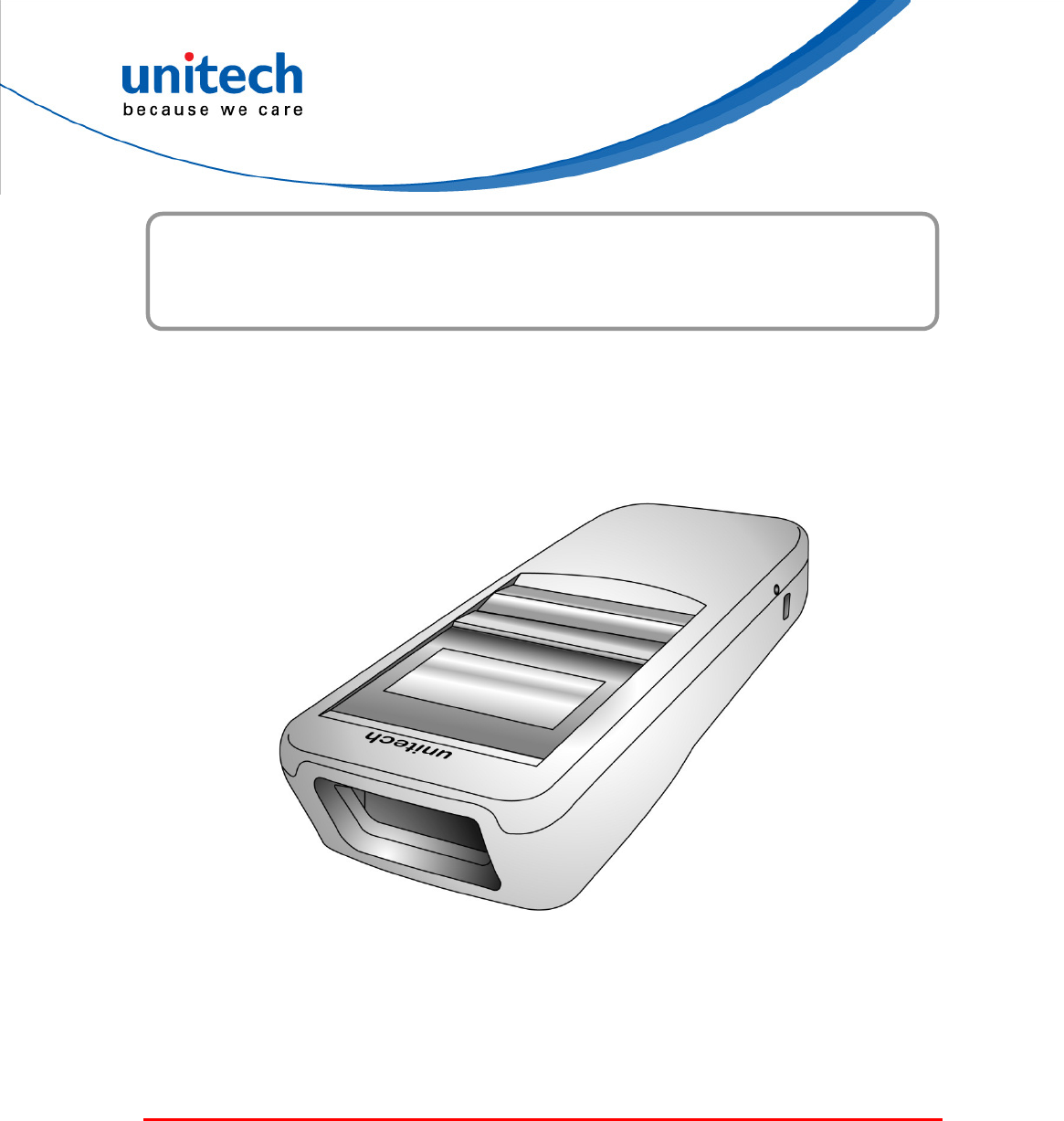
© 2015 unitech Electronics Co., Ltd. All rights reserved. unitech is a registered trademark of
unitech Electronics Co., Ltd.
Wireless(BT) Pocket Laser Scanner
- MS916 -
User's Manual
Version 1.0

i
Table of Contents
Chapter 1
Overview..........................................................................................................1
Package Contents ........................................................................................1
Scanner Detail..............................................................................................3
Getting Started .............................................................................................4
BATTERY CHARGING.................................................................................4
Pairing With PC/Notebook For The First Time..............................................5
Specifications ...............................................................................................6
Chapter 2
MS916 Setting Code........................................................................................9
Chapter 3
Setting Up MS916..........................................................................................15
MS916 Menu Tree......................................................................................14
General Setting ..........................................................................................16
Data & Memory ..........................................................................................19
BT Configuring ...........................................................................................20
Barcode setting ..........................................................................................22
Disable All Code.........................................................................................22
Chapter 4
Parameter Menus ..........................................................................................24
Introduction ................................................................................................23
Operational Parameters .............................................................................23
Set Default Parameter................................................................................28
Beeper Volume...........................................................................................29
Beeper Tone...............................................................................................29
Laser On Time............................................................................................30
Aim Duration...............................................................................................31
Triggering Modes........................................................................................31
Time-out Between Same Symbol ...............................................................33
Beep After Good Decode............................................................................33
Parameter Scanning...................................................................................34

ii
Parameter Pass Through ...........................................................................34
Disable All Symbologies .............................................................................35
Linear Code Type Security Level................................................................36
Bi-directional Redundancy .........................................................................37
UPC/EAN ...................................................................................................38
Code 128....................................................................................................46
Code 39......................................................................................................47
Code 93......................................................................................................52
Code 11......................................................................................................54
Interleaved 2 of 5........................................................................................57
Discrete 2 of 5 ............................................................................................61
Chinese 2 of 5 ............................................................................................63
Codabar .....................................................................................................63
MSI.............................................................................................................66
GS1 DataBar..............................................................................................70
Transmit Code ID Character.......................................................................72
Prefix/Suffix Values.....................................................................................73
Scan Data Transmission Format ................................................................74
Numeric Bar Codes....................................................................................76
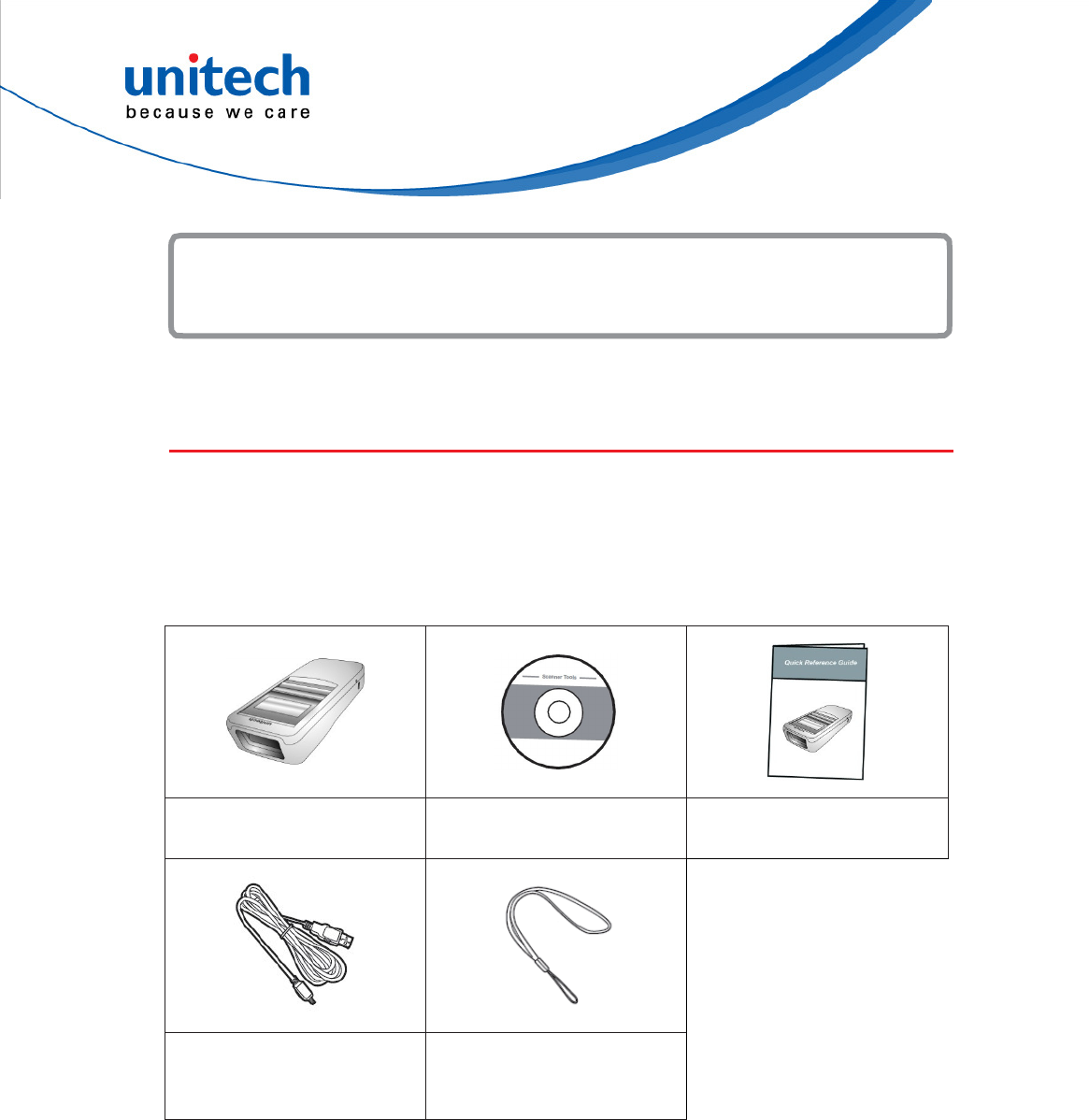
-
1
-
Package Contents
Please make sure the following contents are in the MS916 gift box. If
something is missing or damaged, please contact your Unitech representative.
The standard package contents
MS916 Scanner Resource CD Quick Reference Guide
Micro USB to USB
Cable Whist Strap
Overview
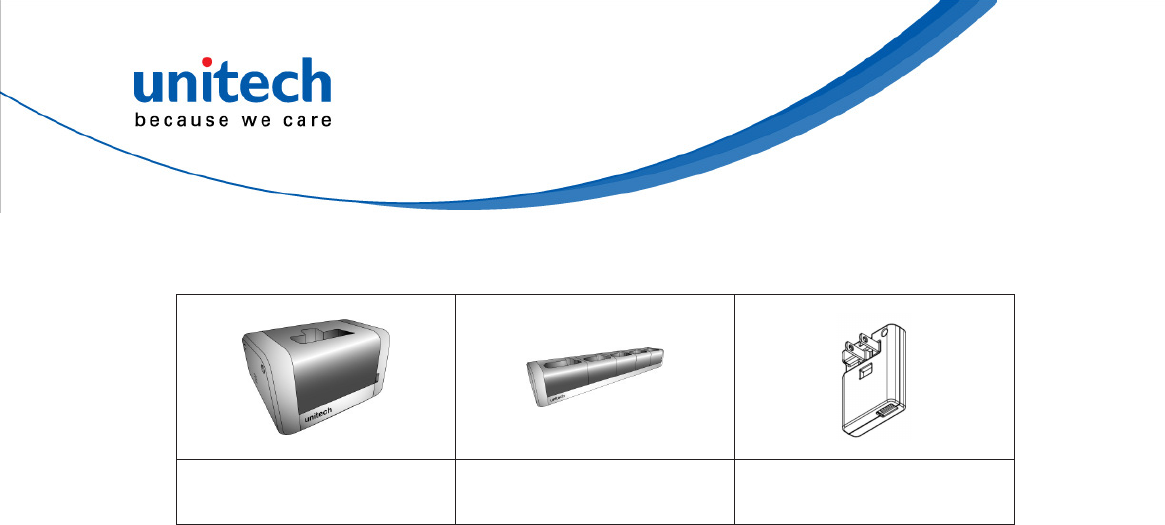
-
2
-
Optional accessories
1-Slot Charging cradle
5-Slot Charging cradle
USB Adapter
NOTE: 1. The scanner’s default power off time is 5 minutes.
2. Please charge scanner for at least 2 hours prior to initial use.
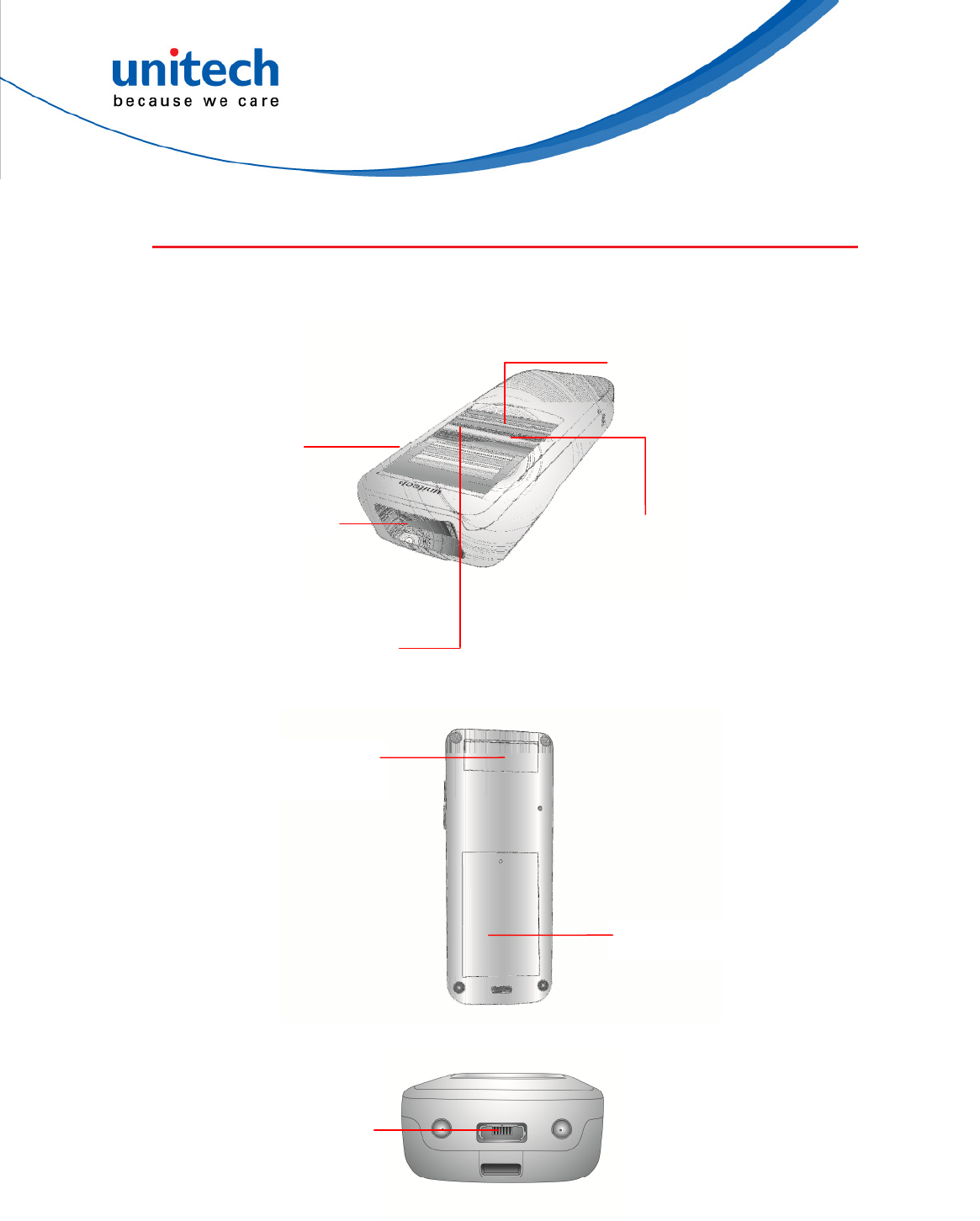
-
3
-
Scanner Detail
Micro USB Connector
For scanner charging and
data transmission
Scan Window
Scan & Power Button
Power On/Off & Scan barcode
Charging Status LED (Red LED)
It will light up while the scanner is
charging
Page up / Page down keys
Move up / down through list of
menu items
Scan LED (Green LED)
It will light up while the barcode is
successfully scanned
Product Label
Laser Warning Label
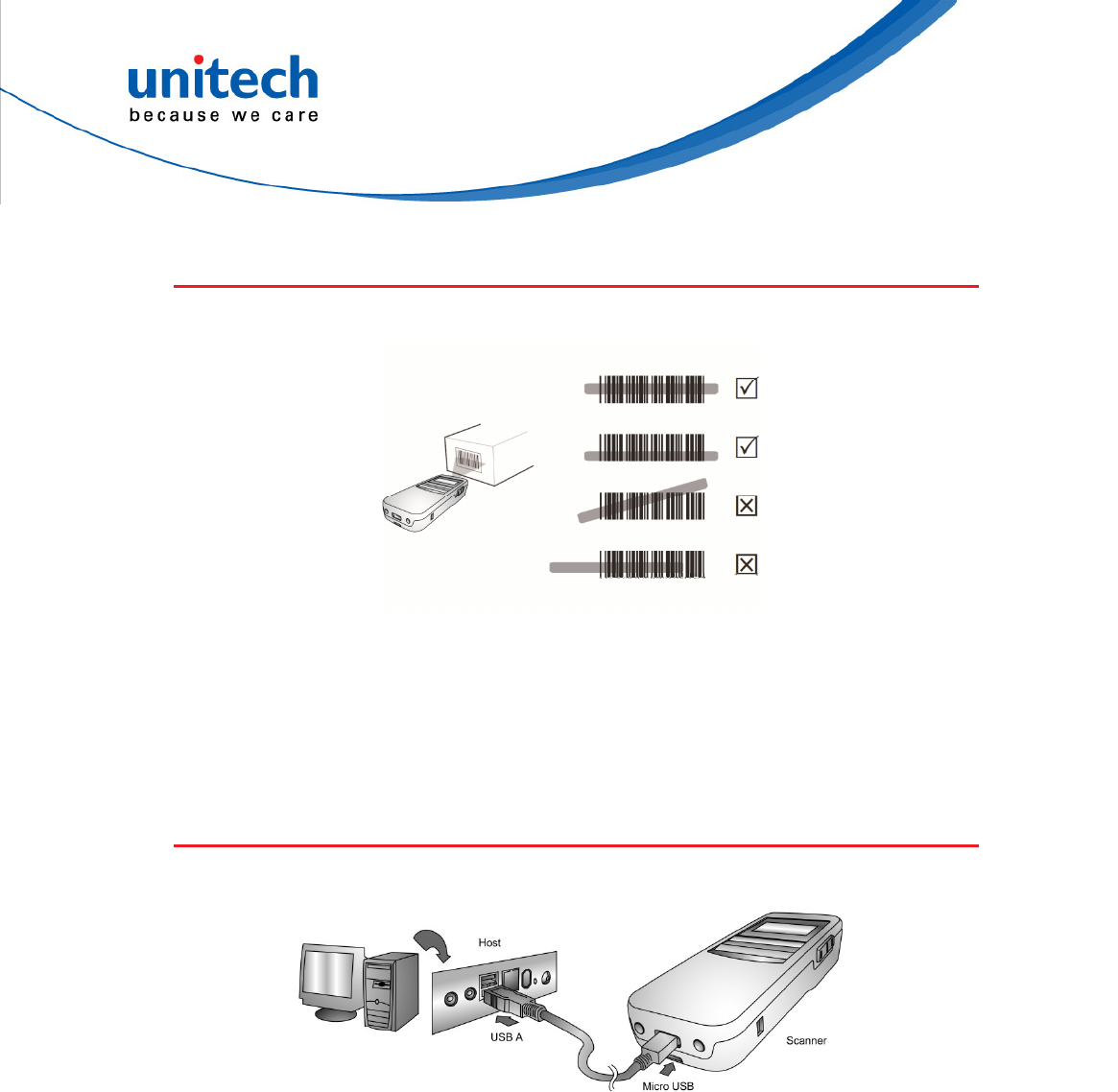
-
4
-
Getting Started
To scan a barcode, make sure the aiming beam crosses every bar and space
of the barcode.
BATTERY CHARGING
Insert the mini USB connector into the port on the scanner and the standard
mini USB connector of the USB cable into a USB port on the host PC.

-
5
-
Pairing With PC/Notebook For The First Time
PC (HID mode)
Following steps are based on Microsoft Windows 7.
1. Turn on MS916 and then press the Page Down button to enter BT Pairing
mode.
2. Open Devices and Printers by clicking the Start button , and then, on
the Start menu, clicking Devices and Printers.
3. Click Add a device, and then follow the instructions.
4. Click the Bluetooth enabled device (MS916-[XXXXXX]) you want to add to
your computer, and then click Next. If you don't see the device you want to
add, make sure the device is turned on and discoverable. If you just turned
on the device, it may take Windows several seconds to detect it.

-
6
-
Specifications
System
Display 1" OLED, 128 x 64
OS
Proprietary, Connect to host with Windows, Android and
iOS
Memory
64 Kbytes SRAM / 16MB Flash ROM
Key
3 Keys: Page up, Page down, Scan with power on/off
feature
Optical & Performance
Receiving Device
Laser Engine
Light Source 650 nm visible laser diode
Max. Resolution 4mil
Scan Rate 104 scans/second
Skew Angle 47±3 degrees
Pitch Angle 35±3 degrees
Printing Contrast
Scale minimum 25%
Depth of Field
(DOF PCS=80%)
Symbology | Density | Near | Far
Code 39, 4 mils | 2.5 cm | 13.97 cm
Code 39, 5 mils | 3.18 cm | 20.32 cm
Code 39, 7.5 mils | 3.81 cm | 33.02 cm
Code 39, 10 mils | 3.81 cm | 45.72 cm
Code 39, 15 mils | 3.81 cm | 71.72 cm
Code 39, 20 mils | 4.45 cm | 83.82 cm
Code 39, 40 mils | x | 91.44 cm
Code 39, 55 mils | x | 114.3 cm
UPC, 13 mils | 3.81 cm | 60.96 cm

-
7
-
Functionality
Symbologies
1D Code 39, Full ASCII Code 39, Interleave 2 of 5, UPC
A/E/E1, MSI, Codabar, Code 11, EAN8/13, Code 93, Code
128, EAN 128, Code32, GS1 databar Code, Bookland
EAN, Discreate 2 of 5, Chinese 2 of 5, ISBT 128, UCC
Coupon Extended Code, Bookland 128
Postal Australian Post, BPO, Canada Post, Dutch Post, Japan
Post, PostNet, Sweden Post
Operation Mode Trigger mode, Pulse mode, Flash mode, Continuous Mod
e,
Buffer mode
Data Formatting Prefix, Suffix, Code ID, Reformatting Date
Environmental
ESD Protection Functional after 8K Contact and 12K Air
Mechanical Shock
1.5m onto concrete (scanner only)
IP Rate IP42
Operating
Temperature 0°C to 50°C
Storage
Temperature -30°C to 70°C
Relative Humidity
95% non-condensing
Electrical
Operation Voltage
DC 3V to 5V
Current
Consumption Operation mode: TBD, Standby mode: TBD
Battery Type Rechargeable Li-ion battery battery
Battery Capacity 770 mAh
Battery Charging
time Fully charged in about 3 hours
Operating Time 10 hours at condition of 1 scan/5 sec

-
8
-
Communication
Radio Frequency Bluetooth V2.1+EDR. Class 2
Protocol Wireless SPP & HID profiles
Range Up to 30 Feet (Open space)
Host Interface
supported USB
Mechanical
Scanner
Dimension H21.1*W36.9*L95.9mm
Scanner Weight 63g
Switch life 10 million times
Regulation Approvals
CE, FCC, BSMI, VCCI
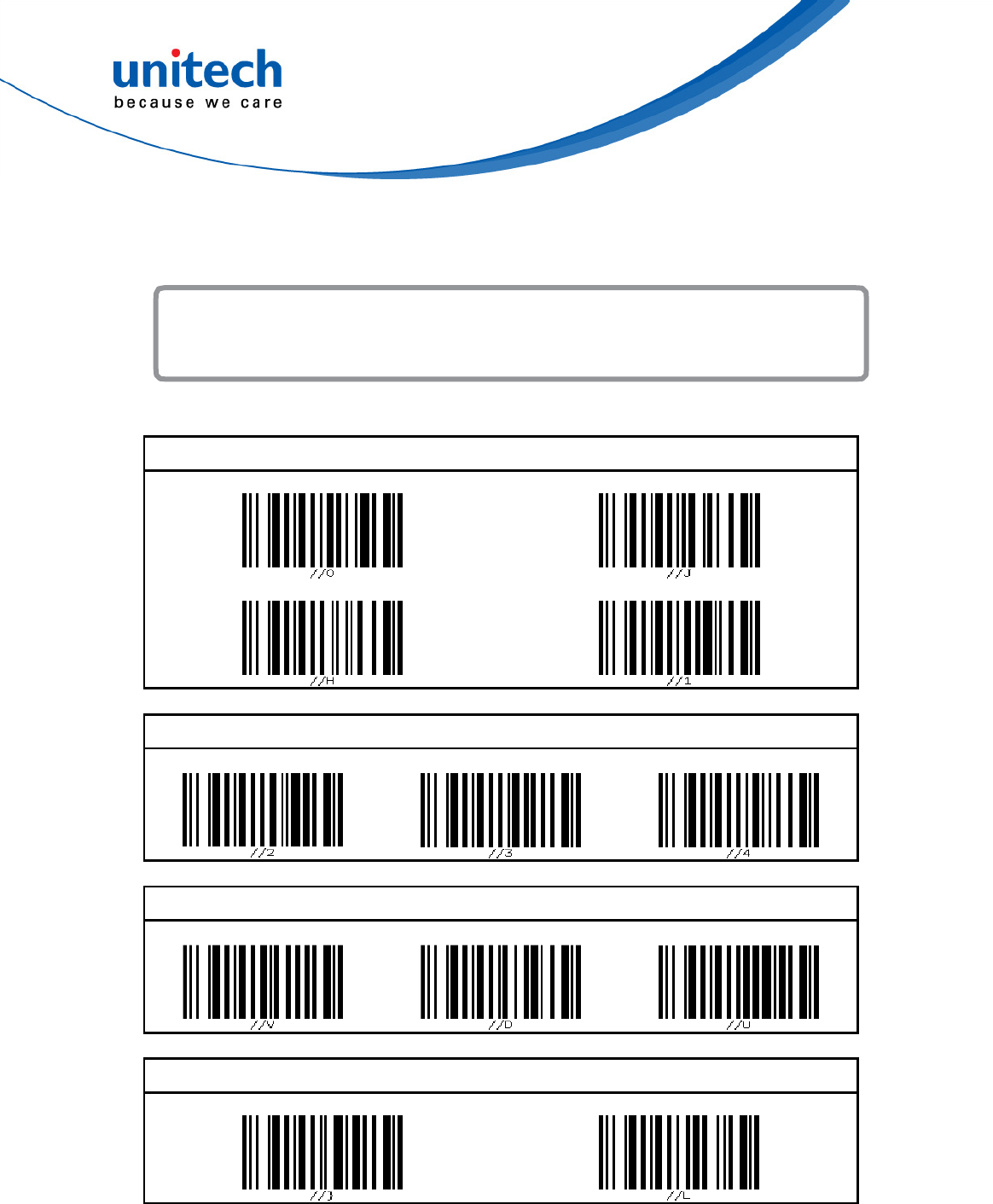
-
9
-
Chapter 2
*for FW v0.35 or later
Scanner Type
BT HID *
USB SPP
BT SPP
BT SPP (Slave)
Operation Mode
Wedge
Batch
Auto *
Bluetooth Config
BT
Pairing
Paired Device
Remove Pair
System Restore & Info
Factory Default
Send Info
MS916 Setting Code
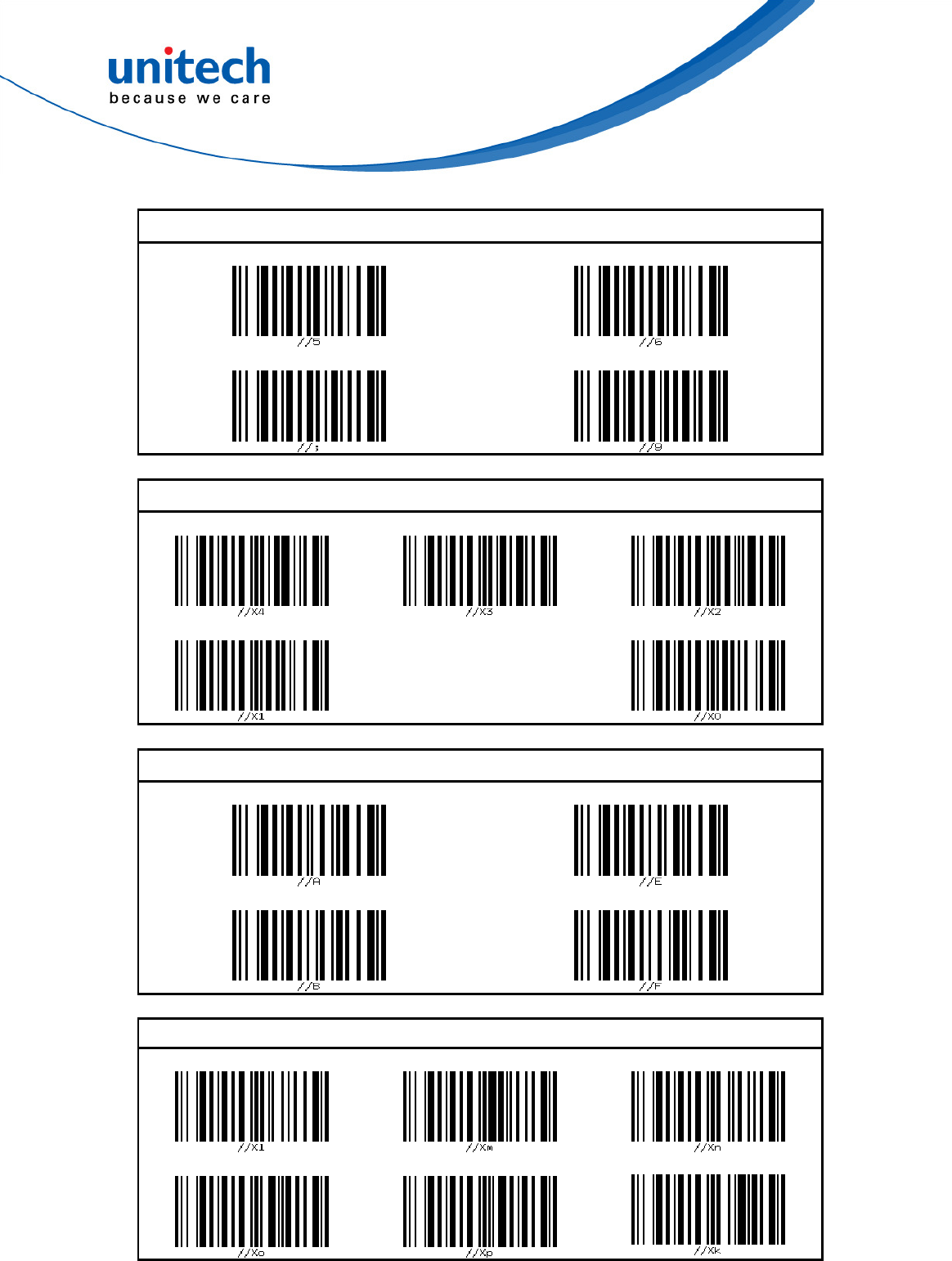
-
10
-
Data & Memory
Send Batch
Free Memory Space
Erase Last Memory Entry
Erase Memory
Beeper & Vibrator Control
High Volume
Mute & Vibrate
Medium Volume *
Low Volume
Mute
Beep / Vibrate
Enabled for Good Read *
Enabled for Connection *
Disabled for Good Read
Disabled for Connection
Power Saving
5 Seconds
20 Seconds
10 Seconds
30 Seconds
15 Seconds
Disable
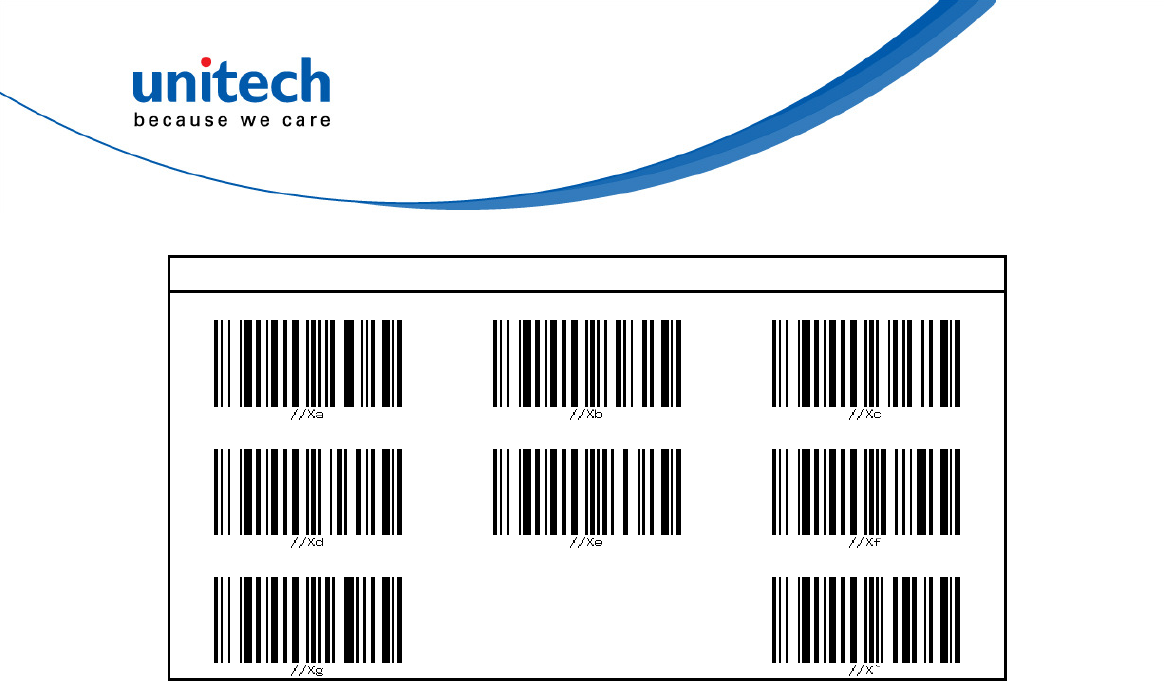
-
11
-
Auto Power Off
1 Minute
10 Minutes
30 Minutes
3 Minutes
15 Minutes
5 Minutes *
20 Minutes
Disable
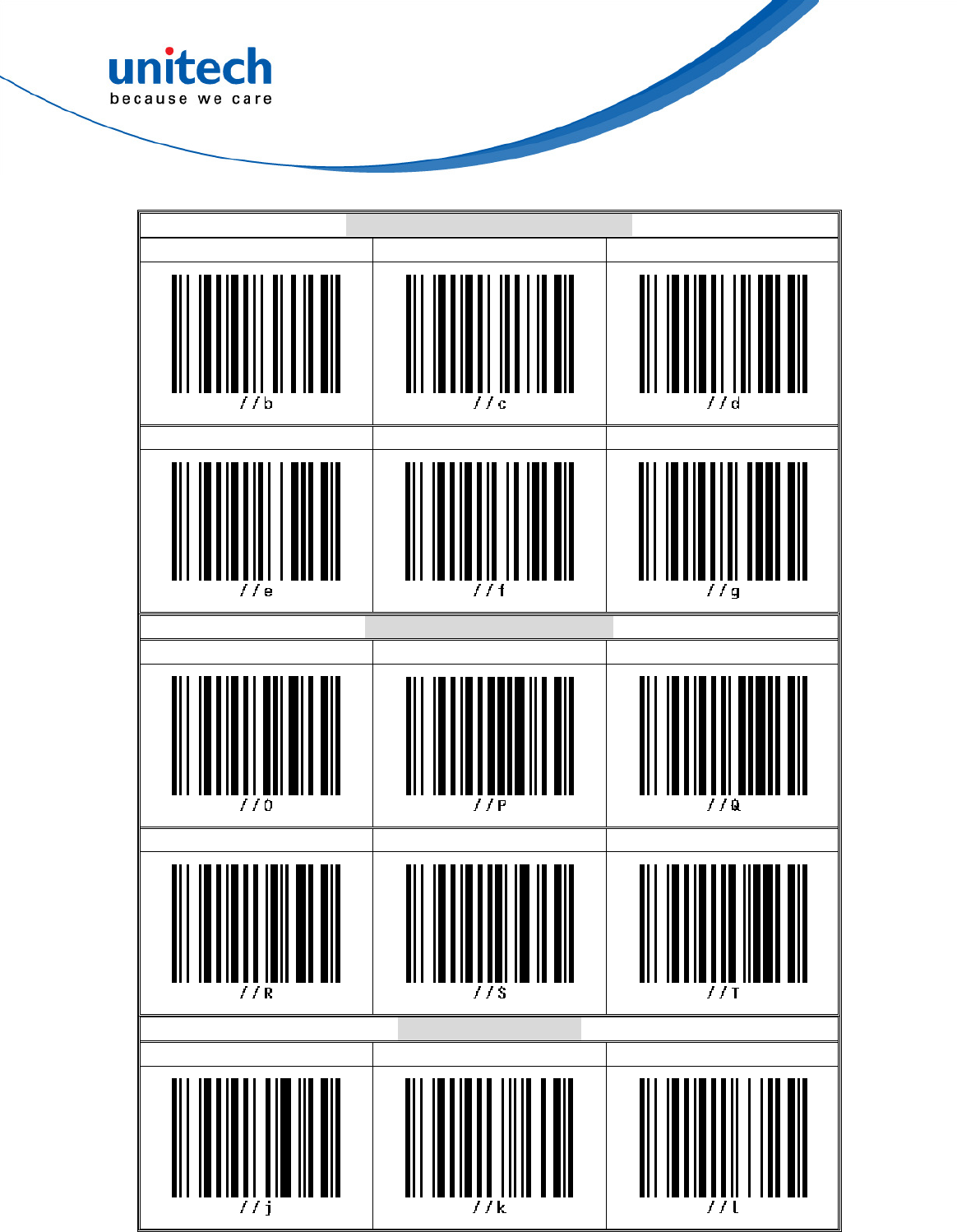
-
12
-
HID Keyboard Character Delay
1 ms * 5 ms 10 ms
20 ms 50 ms 100 ms
HID Keyboard Block Delay
10 ms * 50 ms 100 ms
500 ms 1 Sec. 3 Sec.
HID Keyboard Case
Auto Trace * To Lower To Upper
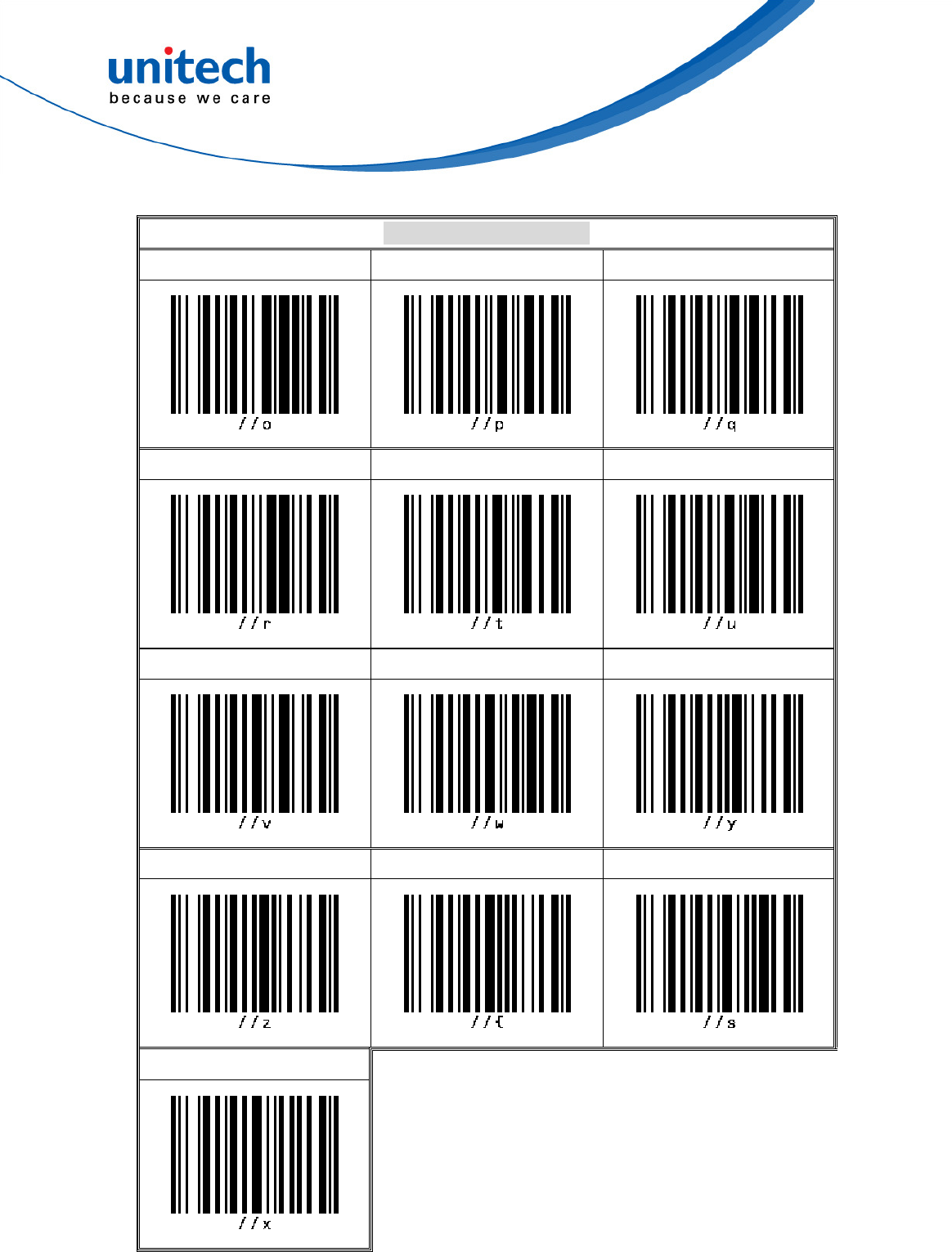
-
13
-
HID Keyboard Language
US English * UK English Swiss
Swedish Norwegian Italian
German French Danish
Partial ALT Japanese (OADG109) Spanish
ALT Mode
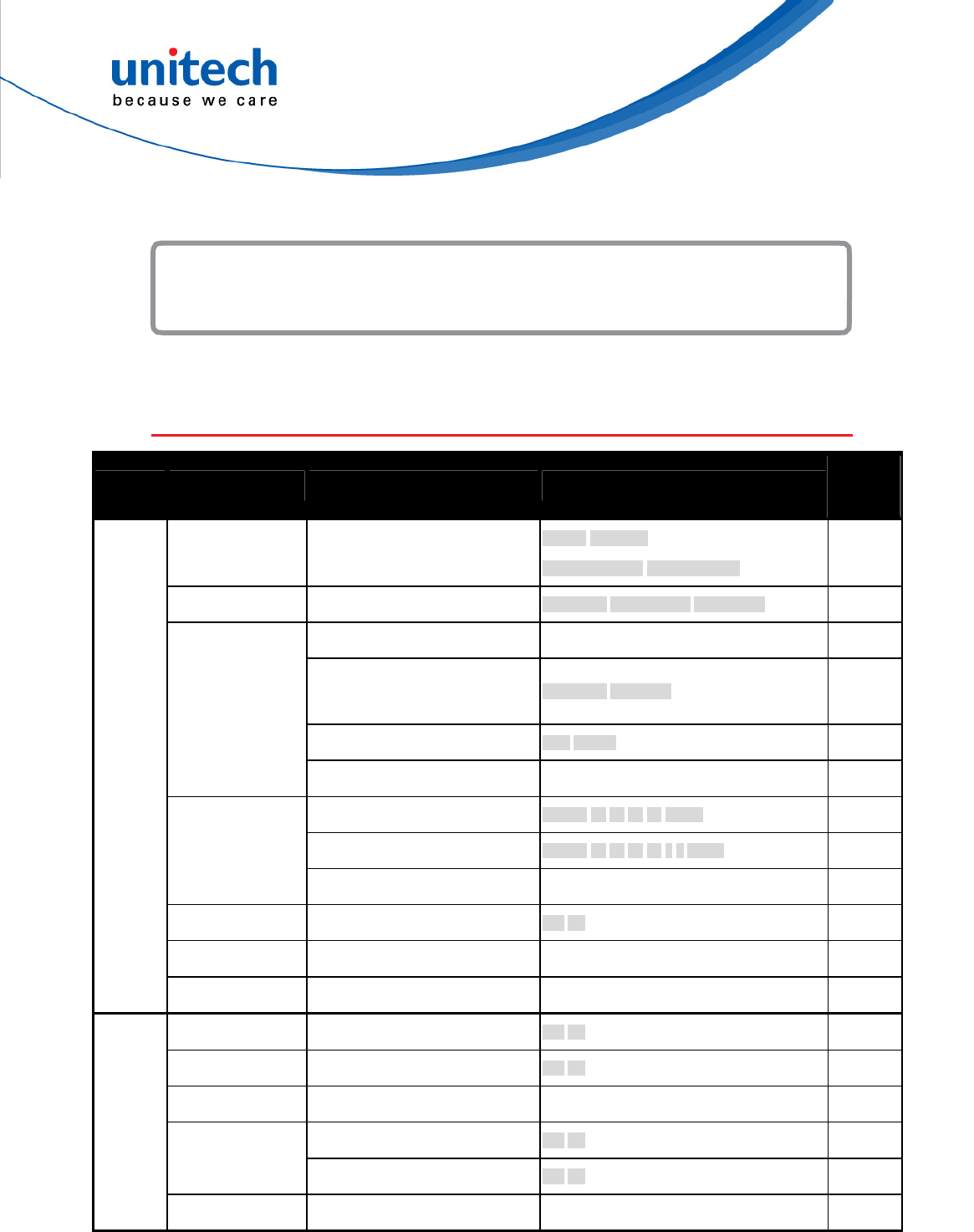
-
14
-
Chapter 3
MS916 Menu Tree
Top Menu
Sub Menu Level 1
Sub Menu Level 2 Options/Result
Default
Setting
1. Scanner Type
BT HID/USB SPP/
BT SPP (Master)/BT SPP (Slave)
BT HID
2. Operation Mode Auto Mode/Wedge Mode/Batch Mode Auto Mode
3.1 View Date/Time Show date and time N/A
3.2 Set Date/Time SET DATE/SET TIME
2015-01-01
08:00:00
3.3 Time Display Auto/Always Auto
3. Date/Time
3.4 Exit Return to the previous menu N/A
4.1 Power Saving Disable/30/20/15/10/5 Sec. 15 Sec.
4.2 Auto Power Off Disable/30/20/15/10/5/3/1 Min. 5 Min.
4. Power Manager
4.3 Exit Return to the previous menu N/A
5. FAC Default 6.1 Restore to FAC Default? Yes/No No
6. FW Version Show Firmware Version V0.32
General
Setting
7. Exit Return to the previous menu N/A
1. Buffer Data 1.1. Erase Previous Buffer Entry? Yes/No No
2. Batch Data 2.1. Erase Previous Batch Entry? Yes/No No
3. Free Mem Space Show Free Buffer and Batch Memory Space N/A
4.1. Erase Buffer Yes/No No
4. Erase Memory
4.2. Erase Batch Yes/No No
Data &
Memory
5. Exit Return to the previous menu N/A
Setting Up MS916
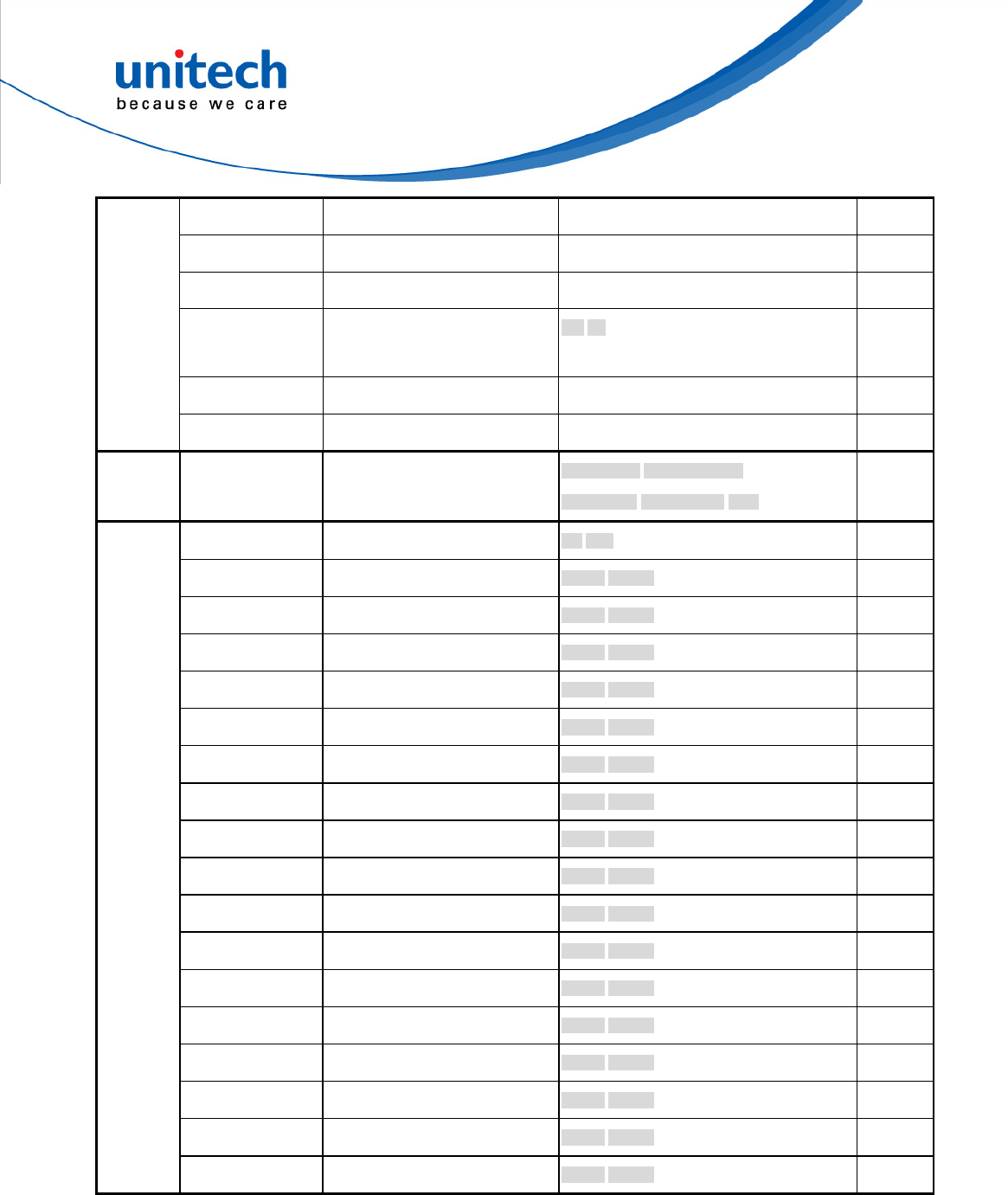
-
15
-
1. BT Pairing Enter BT pairing N/A
2. BT MAC Addr Show BT MAC Address N/A
3. BT Paired Dev Show BT paired Name and MAC Address N/A
4. Remove Pairing
Yes/No (If a BT device has been paired with
MS916)
No
5. BT FW Version Show BT Firmware Version N/A
BT
Configuring
6. Exit Return to the previous menu N/A
Beep &
Vibrate
High Volume/Medium Volume/
Low Volume/Mute&Vibrate/Mute
Medium
Volume
1. Disable All Code ON/OFF OFF
2. UPC-A Enable/Disable Enable
3. UPC-E Enable/Disable Enable
4. EAN-8 Enable/Disable Enable
5. EAN-13 Enable/Disable Enable
6. Code 39 Enable/Disable Enable
7. Code 128 Enable/Disable Enable
8. EAN 128 Enable/Disable Enable
9. I 2 of 5 Enable/Disable Enable
10. Code 93 Enable/Disable Disable
11. Codabar Enable/Disable Disable
12. Code 11 Enable/Disable Disable
13. MSI Enable/Disable Disable
14. UPC-E1 Enable/Disable Disable
15. Bookland EAN Enable/Disable Disable
16. Discreate 2 of 5
Enable/Disable Disable
17. Chinese 2 of 5 Enable/Disable Disable
Barcode
setting
18. GS1-14 Enable/Disable Disable
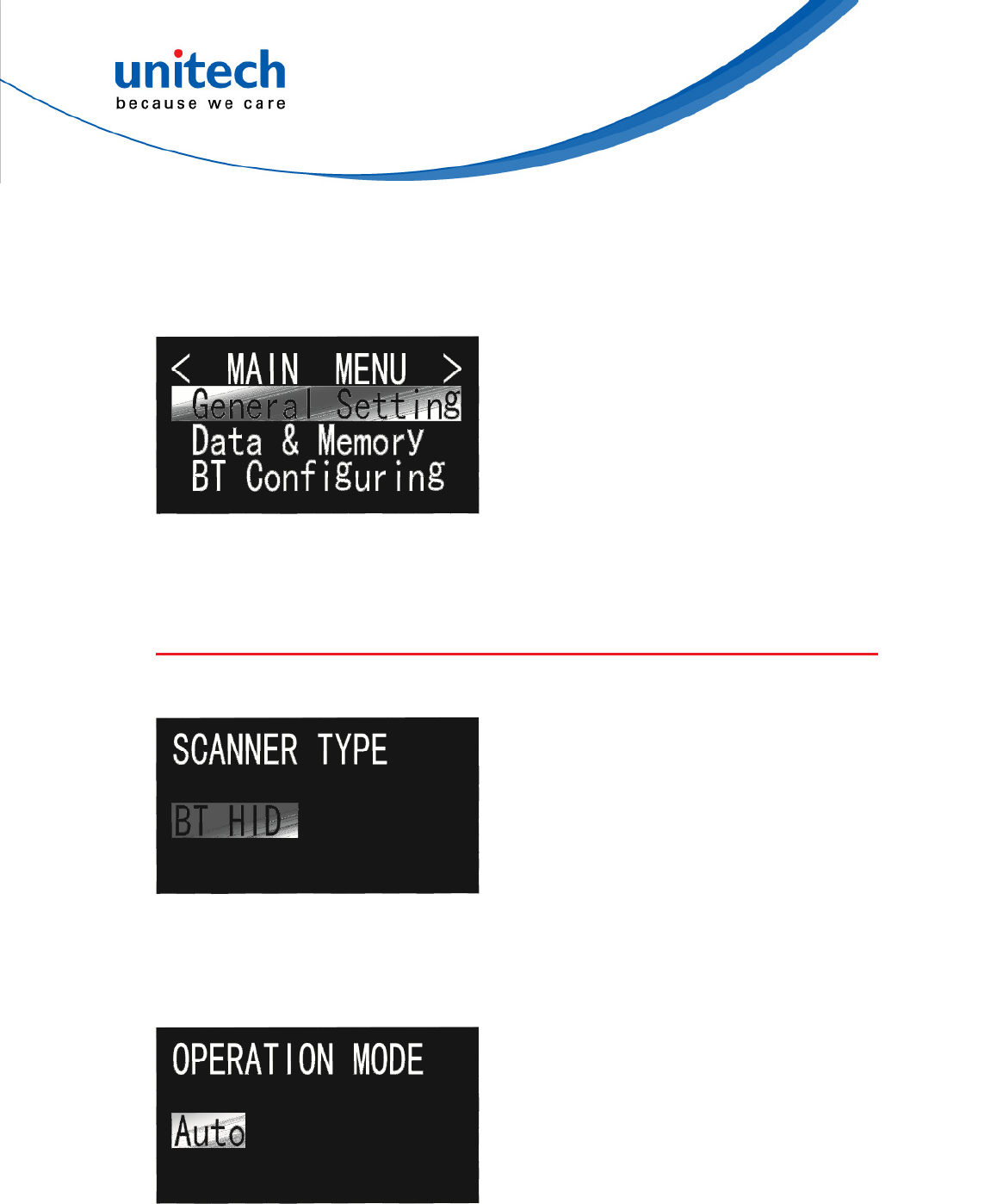
-
16
-
To enter main menu of MS916, press Page Up and Page Down button
simultaneously. You will see the following screen on the MS916 display. Now
you can use Page Up/Down button to scroll through the menu and use Scan
button to make your selection.
The following sections will introduce each function in the menu.
General Setting
Scanner Type
- MS916 can be set to five types: BT HID/USB SPP/BT SPP (Master)/BT
SPP (Slave). The default scanner type is BT HID.
Operation Mode
- MS916 can be operated under three modes: Auto Mode/Wedge
Mode/Batch Mode. The default operation mode is Auto Mode.
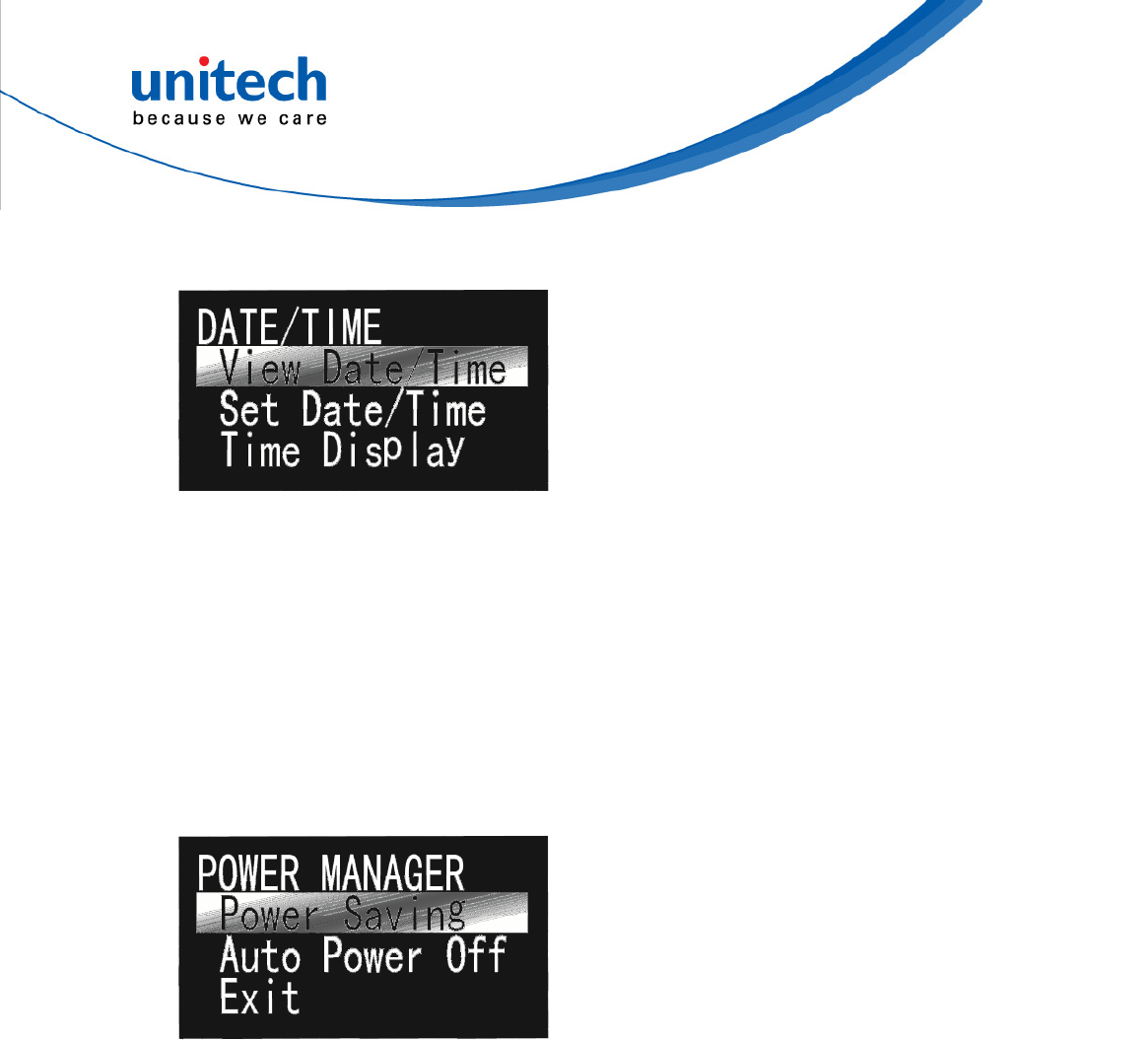
-
17
-
Date/Time
- There are 4 functions under Date/Time menu. The View Date/Time
function can show date/time which has been set in MS916 on the scanner
display.
- You can use Set Date/Time function to set current date/time. First enter
current date (yyyy-mm-dd) and then current time (hh:mm:ss).
- You can use Time Display function to set time to be either Always or Auto
displayed. The default value is Auto.
- The final function Exit can guide you to return to previous menu level.
Power Manager
- The first function under Power Manager menu is Power Saving. You can
use this function to choose the time duration for the scanner coming into
idle mode after no command received. The default value is 15 seconds.
- You can use Auto Power Off to choose the time duration for the scanner
turning off automatically after no command received. The default value is 5
minutes.
- The final function Exit can guide you to return to previous menu level.
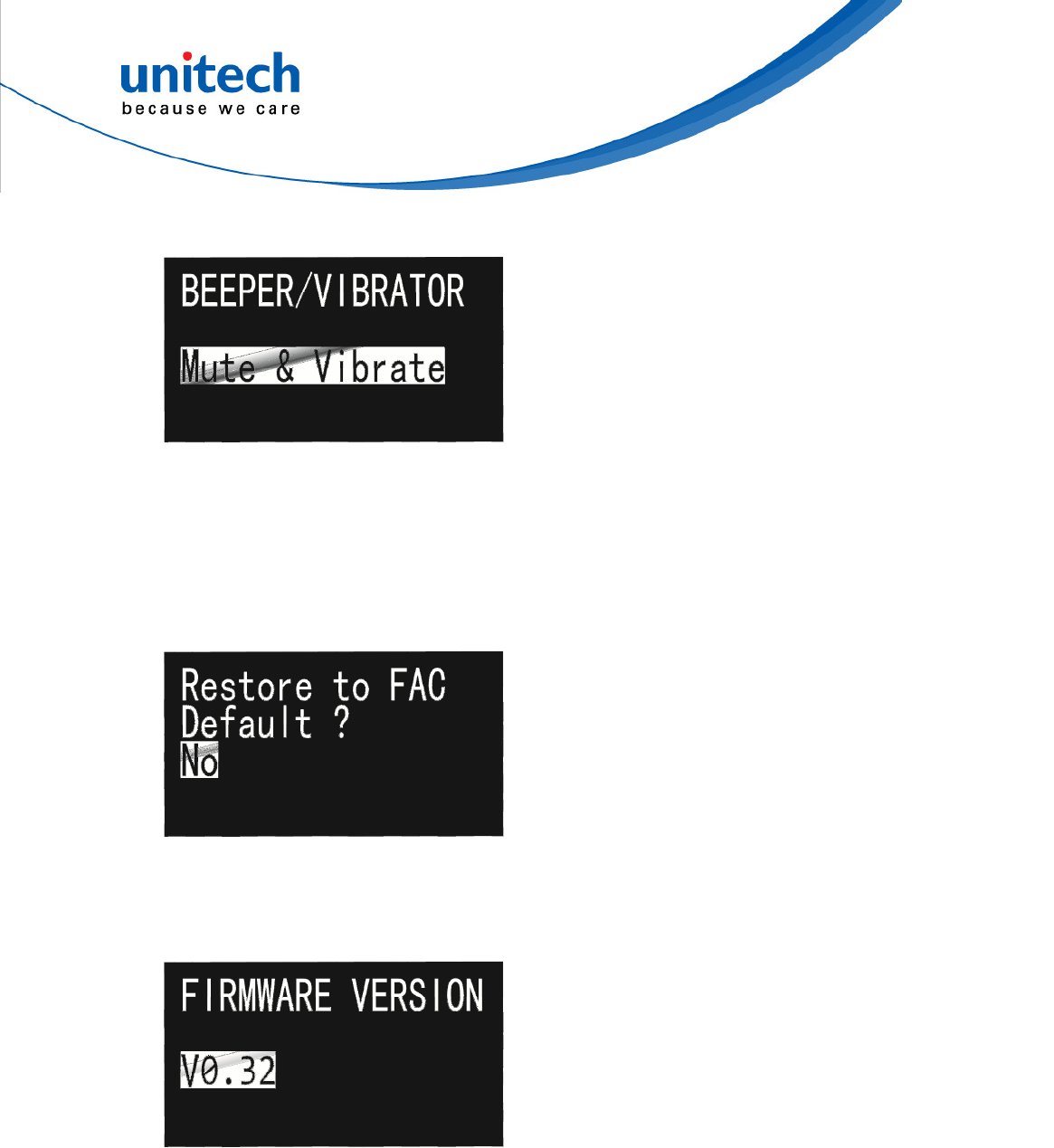
-
18
-
Beep & Vibrate
- You can use Beep & Vibrate function to set scanner’s beep volume and
turn on/off scanner vibration. The options are: High Volume/Medium
Volume/Low Volume/Mute&Vibrate/Mute. The default option is Medium
Volume.
FAC Default
- Use this function to restore MS916 to factory default.
FW Version
- Use this function to show the current FW version of MS916.
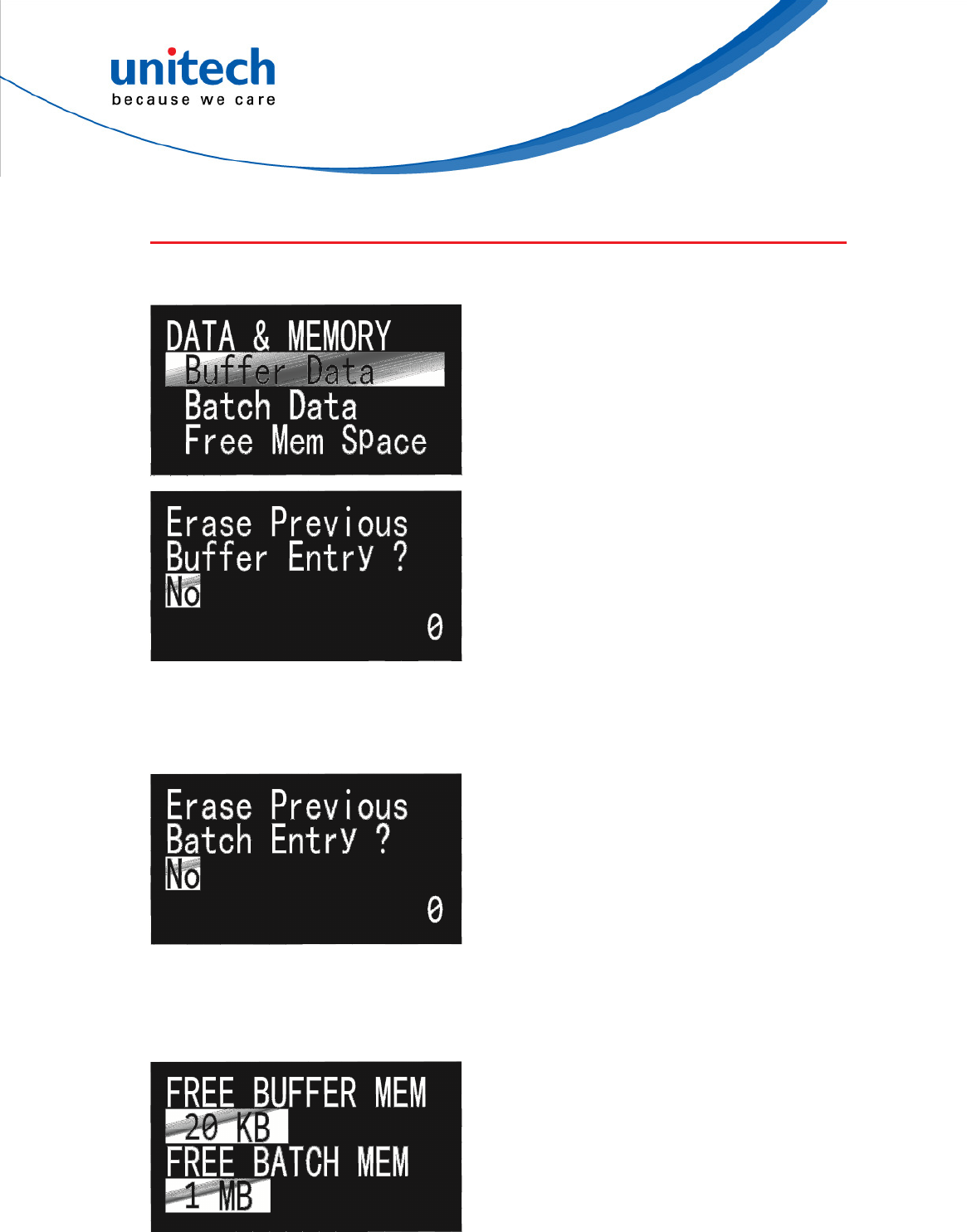
-
19
-
Data & Memory
Buffer Data
- You can use Buffer Data function to erase previous buffer entry.
Batch Data
- You can use Batch Data function to erase previous batch entry.
Free Mem Space
- You can use Free Mem Space function to see how much free buffer and
batch memory left.
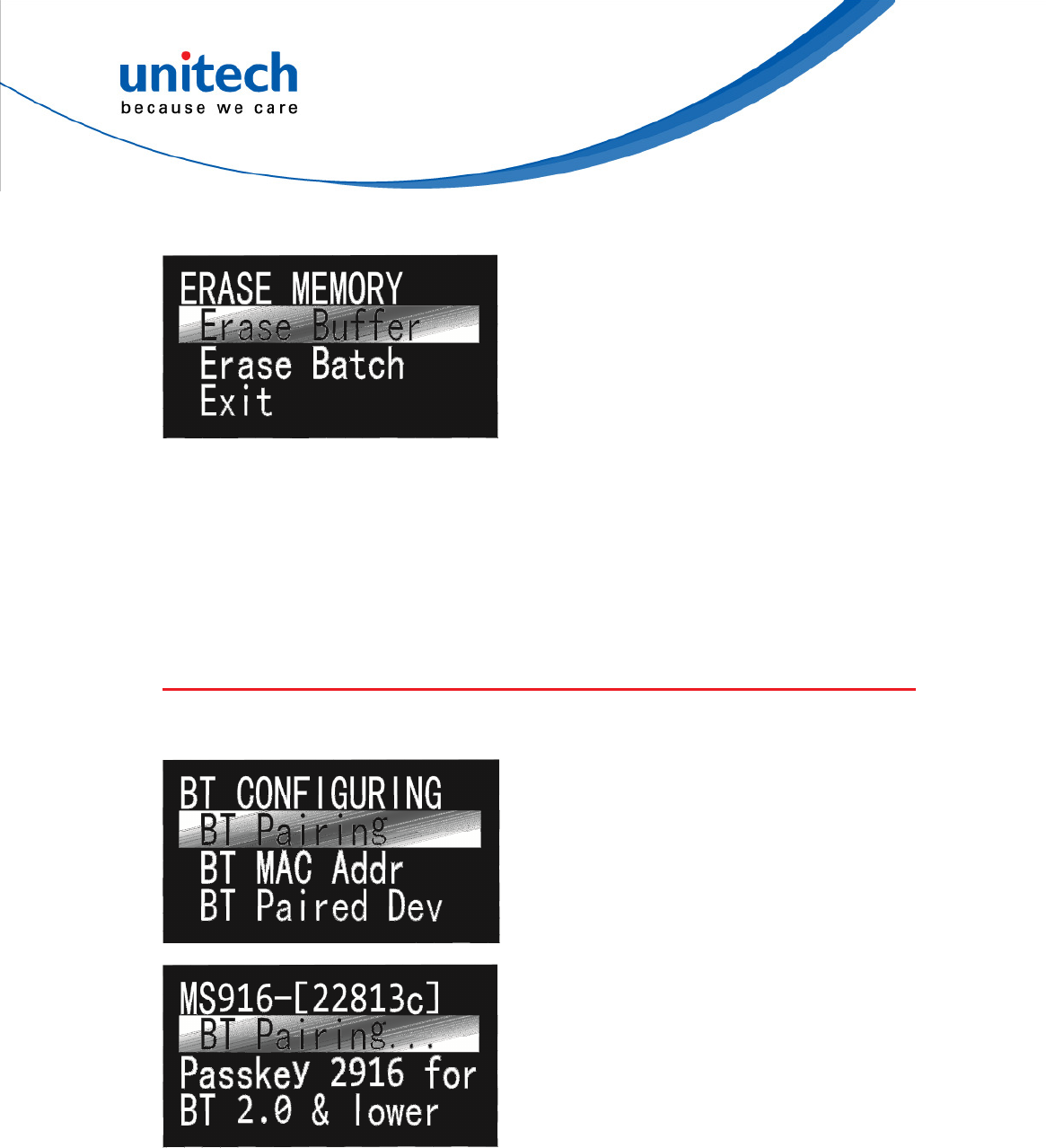
-
20
-
Erase Memory
- Under ERASE MEMORY menu, you can select Erase Buffer and Erase
Batch function.
- You can use Erase Buffer function to empty buffer memory.
- You can use Erase Batch function to empty batch memory.
BT Configuring
BT Pairing
- You can use BT Pairing function to pair MS916 with your host device.
(PC/Notebook/Smartphone/etc.) After select this function, MS916 will be
discoverable and ready to connect with your host device.
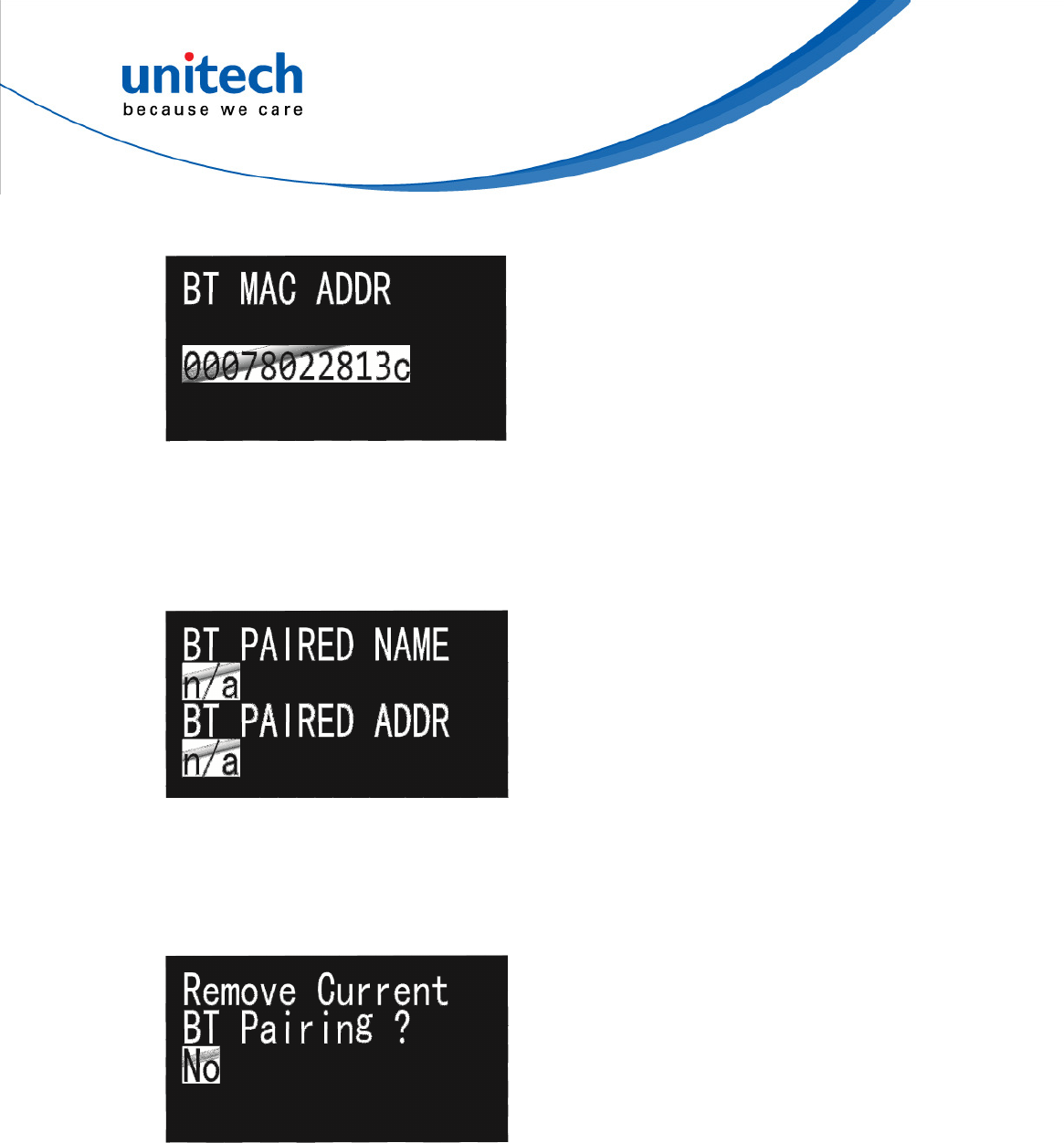
-
21
-
BT MAC Address
- You can use BT MAC ADDR function to show the BT MAC address of
MS916.
BT Paired Device
- You can use BT PAIRED DEV function to show the name and MAC
address of the paired Bluetooth device.
Remove Pairing
- If a BT device has been paired with MS916, you can use this function to
remove the connection.
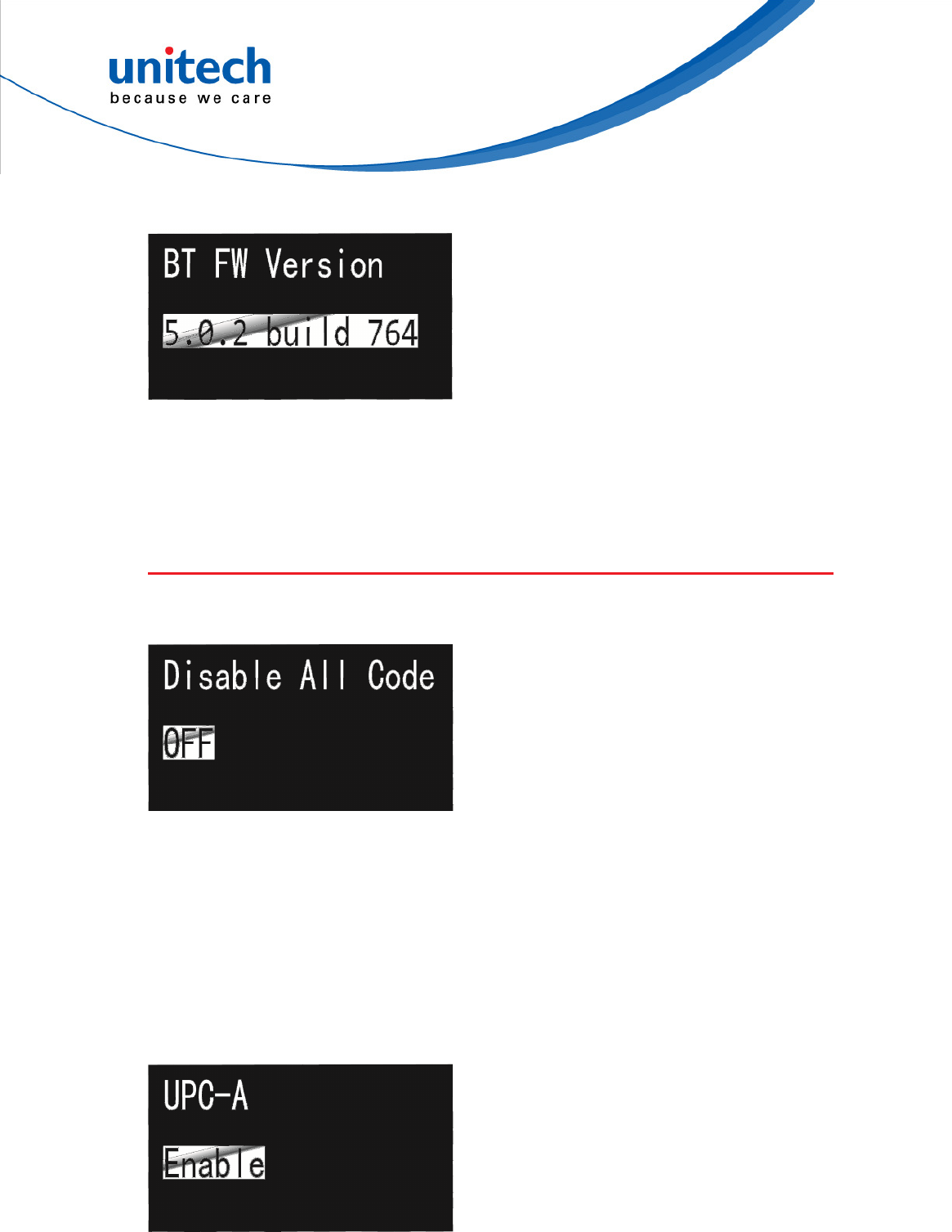
-
22
-
BT FW Version
- You can use BT FW Version to show the Bluetooth firmware version of
MS916.
Barcode setting
Disable All Code
- You can use Disable All Code function to turn on/off all barcodes scanning
availability.
UPC-A / UPC-E / EAN-8 / EAN-13 / Code 39 / Code
128 / EAN 128 / I 2 of 5 / Code 93 / Codabar /
Code 11 / MSI / UPC-E1 / Bookland EAN /
Discreate 2 of 5 / Chinese 2 of 5 / GS1-14
- You can Enable or Disable these supported barcode’s scanning availability.

-
23
-
Chapter 4
Introduction
This chapter describes the programmable parameters, provides bar codes for
programming, and hexadecimal equivalents for host parameter programming
through SSI.
Operational Parameters
The MS916 is shipped with the factory default settings shown in Table 3-1 on
page 26. These factory default values are stored in non-volatile memory and
are preserved even when the scan engine is powered down.
Changes to the factory default values can be stored as custom defaults. These
values are also stored in
non-volatile memory and are preserved even when the scan engine is
powered down.
To change the parameter values:
• Scan the appropriate bar codes included in this chapter. The new values
replace the existing memory values. To set the new values as custom
defaults, scan the Write to Custom Defaults bar code. The factory
default or custom default parameter values can be recalled by scanning
the Set Factory Defaults bar code or the Restore Defaults bar code on
page 29.
or
• Send the parameter through the scan engine’s serial port using the SSI
command PARAM_SEND. Hexadecimal parameter numbers are shown
in this chapter below the parameter title, and options appear in
parenthesis beneath the accompanying bar codes. Instructions for
changing parameters using this method are found in Chapter 10, Simple
Serial Interface.
Parameter Menus

-
24
-
Parameter Programming Recommendations
When setting parameters via bar code or via SSI with the permanent flag set,
the following conditions must be met:
• The system must have stable power applied to the scanner.
• The engine and host must be operating and communicating with no
interference.
• Power must be maintained for at least two seconds after sending the
command or scanning the parameter bar code.
If sending parameters upon every power up, ensure they are temporary.
Motorola does not recommend sending permanent parameters or Set Defaults
upon every power up. Motorola also recommends not using a hard power
switch on the power supply.
Failure to meet these conditions can corrupt the scan engine's memory.
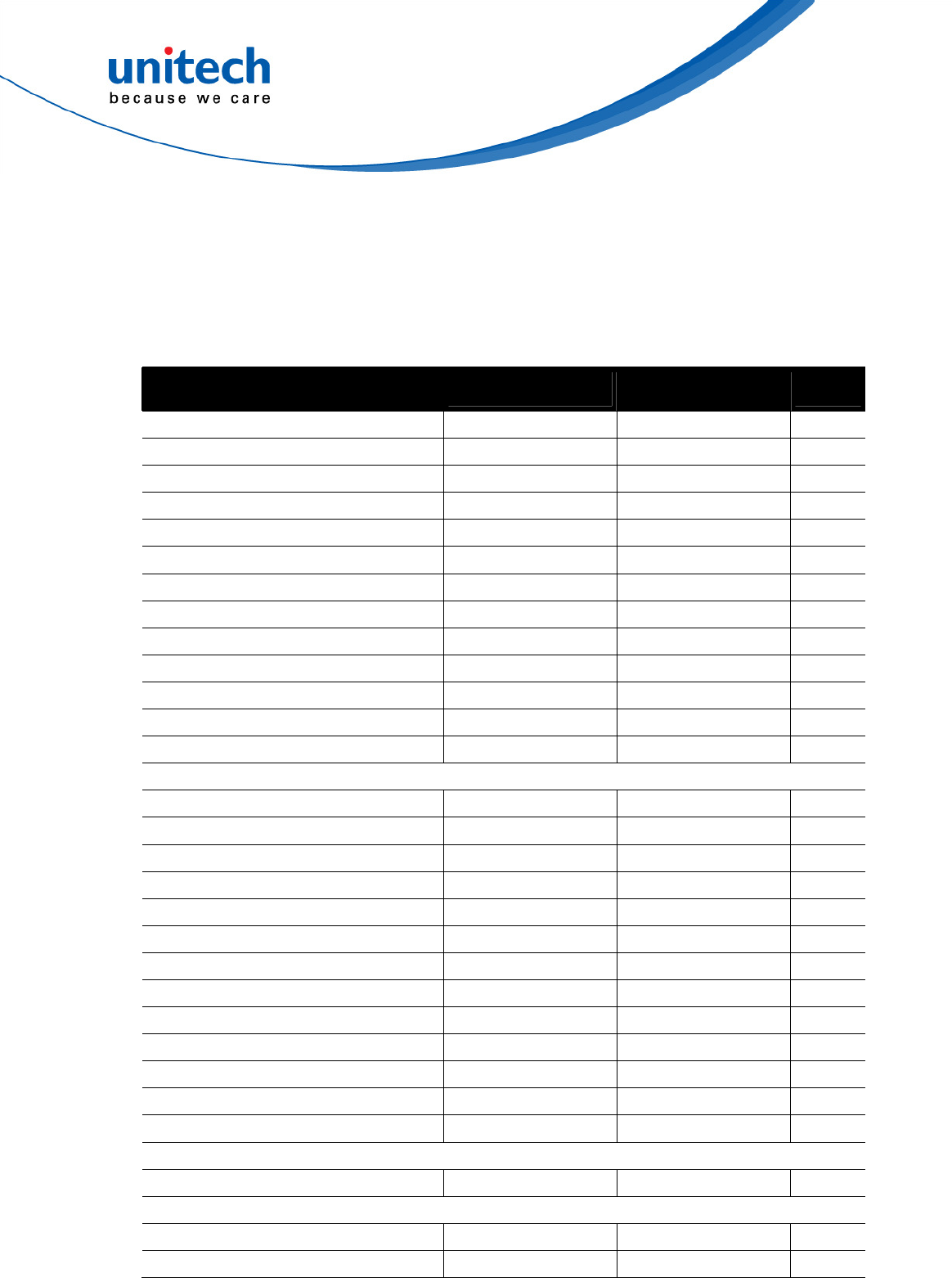
-
25
-
Parameter Defaults
Table 3-1 lists the factory defaults for all parameters. To change any option,
scan the appropriate bar code(s).
Table 3-1 Factory Default Table
Parameter Parameter Number
(Hex) Factory Default Page
Number
Set Factory Default All Defaults 29
Beeper Volume 0x8C Medium 30
Beeper Tone 0x91 Medium Frequency 30
Laser On Time 0x88 3.0 sec 31
Aim Duration 0xED 0.0 sec 32
Trigger Mode 0x8A Level 32
Time-out Between Same Symbol 0x89 1.0 sec 34
Beep After Good Decode 0x38 Enable 34
Parameter Scanning 0xEC Enable 35
Parameter Pass Through F1h 71h Disable 35
Disable All Symbologies N/A N/A 36
Linear Code Type Security Levels 0x4E 1 37
Bi-directional Redundancy 0x43 Disable 38
UPC/EAN
UPC-A 0x01 Enable 39
UPC-E 0x02 Enable 40
UPC-E1 0x0C Disable 40
EAN-8 0x04 Enable 41
EAN-13 0x03 Enable 41
Bookland EAN 0x53 Disable 42
UPC-A Preamble 0x22 System Character 42
UPC-E Preamble 0x23 System Character 43
UPC-E1 Preamble 0x24 System Character 44
Convert UPC-E to A 0x25 Disable 45
Convert UPC-E1 to A 0x26 Disable 45
EAN-8 Zero Extend 0x27 Disable 46
Bookland ISBN Format F1h 40h ISBN-10 46
Code 128
Code 128 0x08 Enable 47
Code 39
Code 39 0x00 Enable 48
Trioptic Code 39 0x0D Disable 48
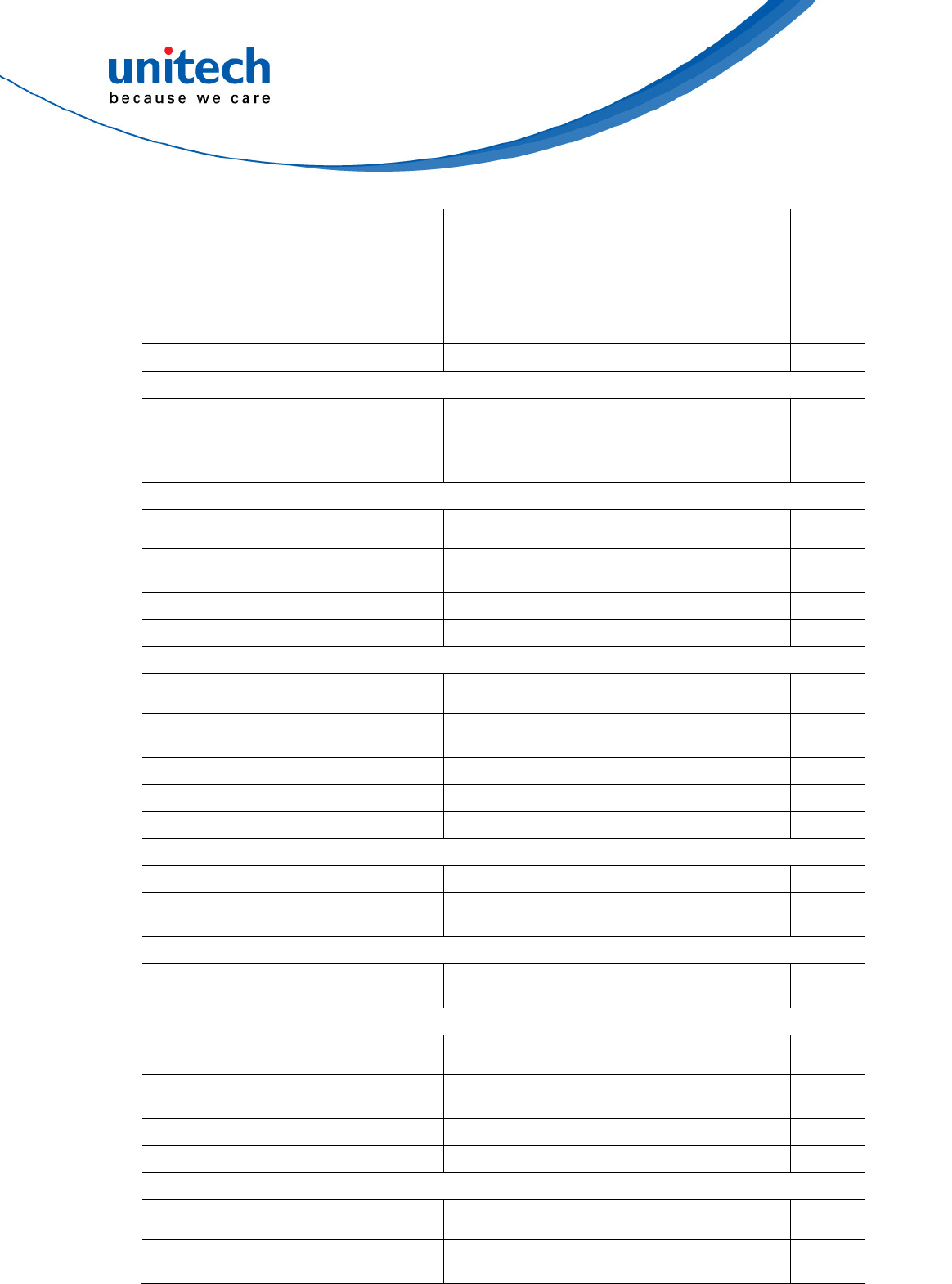
-
26
-
Convert Code 39 to Code 32 0x56 Disable 49
Code 32 Prefix 0xE7 Disable 49
Set Length(s) for Code 39 0x12 2-55 50
Code 39 Check Digit Verification 0x13 Disable 51
Transmit Code 39 Check Digit 0x30 Disable 52
Code 39 Full ASCII Conversion 0x2B Disable 52
Code 93
Code 93 0x09 Disable 53
Set Length(s) for Code 93 0x1A
0x1B 4-55 54
Code 11
Code 11 0x0A Disable 55
Set Lengths for Code 11 0x1C
0x1D 4 to 55 56
Code 11 Check Digit Verification 0x34 Disable 57
Transmit Code 11 Check Digit(s) 0x2F Disable 58
Interleaved 2 of 5
Interleaved 2 of 5 0x06 Enable 58
Set Length(s) for I 2 of 5 0x16
0x17 14 59
I 2 of 5 Check Digit Verification 0x31 Disable 60
Transmit I 2 of 5 Check Digit 0x2C Disable 61
Convert I 2 of 5 to EAN 13 0x52 Disable 61
Discrete 2 of 5
Discrete 2 of 5 0x05 Disable 62
Set Length(s) for D 2 of 5 0x14
0x15 12 62
Chinese 2 of 5
Chinese 2 of 5 0xF0
0x98 Disable 64
Codabar
Codabar 0x07 Disable 64
Set Lengths for Codabar 0x18
0x19 5-55 65
CLSI Editing 0x36 Disable 66
NOTIS Editing 0x37 Disable 67
MSI
MSI 0x0B Disable 67
Set Length(s) for MSI 0x1E
0x1F 6-55 68

-
27
-
MSI Check Digits 0x32 One 69
Transmit MSI Check Digit 0x2E Disable 70
MSI Check Digit Algorithm 0x33 Mod 10/Mod 10 70
GS1 DataBar
GS1 DataBar-14 0xF0
0x52
Disable
71
GS1 DataBar Limited 0xF0
0x53
Disable
71
GS1 DataBar Expanded 0xF0
0x54
Disable
72
Convert GS1 DataBar to UPC/EAN 0xF0
0x8D
Disable
72
Data Options
Transmit Code ID Character 0x2D None 73
Prefix/Suffix Values
Prefix
Suffix 1
Suffix 2
0x69
0x68
0x6A
NULL
LF
CR
74
Scan Data Transmission Format 0xEB Data as is 75
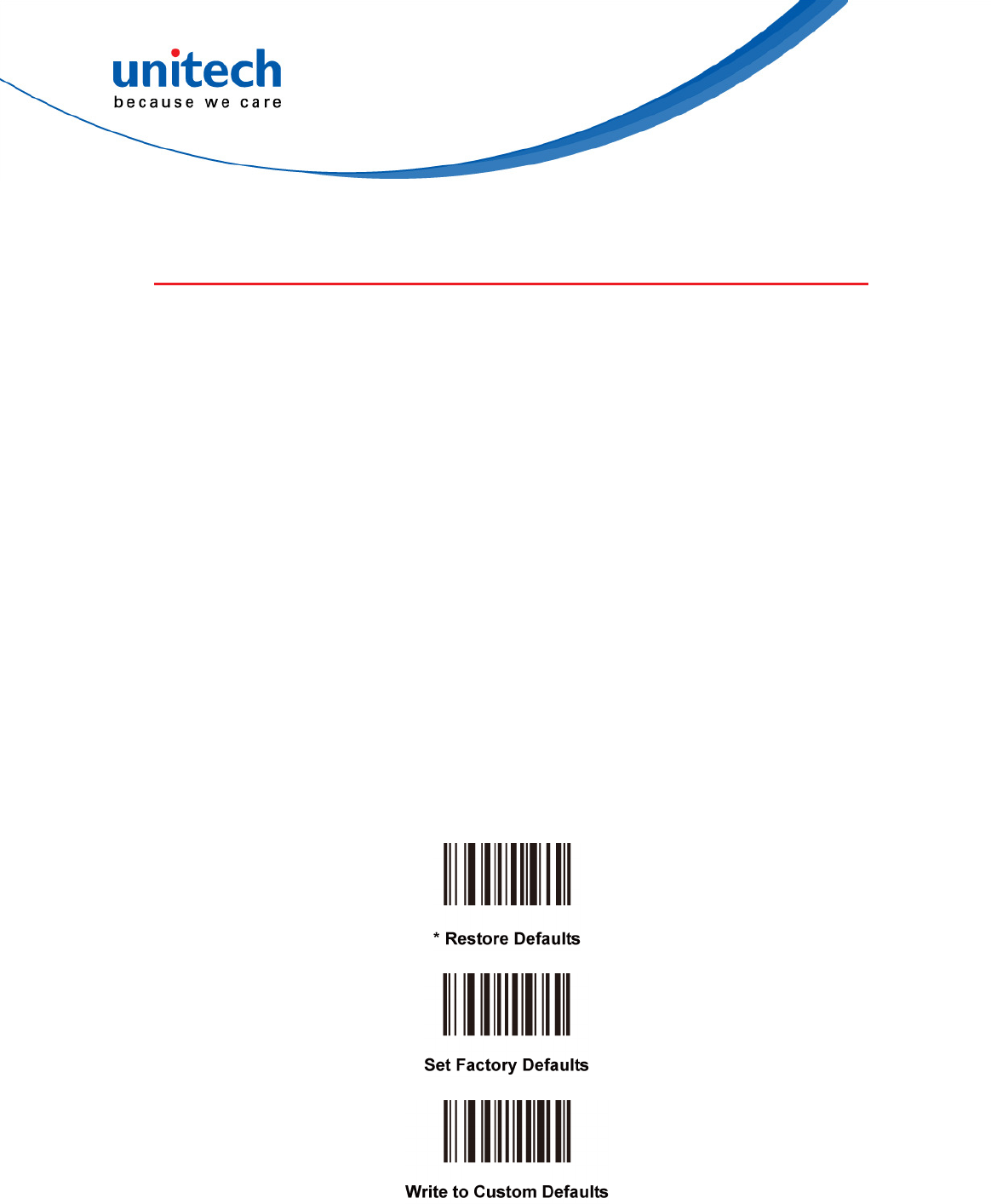
-
28
-
Set Default Parameter
The MS916 can be reset to two types of defaults: factory defaults or custom
defaults. Scan the appropriate bar code below to reset the MS916 to its default
settings and/or set the scan engine’s current settings as the custom default.
• Restore Defaults - Scan this bar code to reset all default parameters
as follows.
• If custom defaults were set by scanning Write to Custom
Defaults, scan Restore Defaults to retrieve and restore the
scan engine’s custom default settings.
• If no custom defaults were set, scan Restore Defaults to restore
the factory default values listed in Table 3-1 on page 26.
• Set Factory Defaults - Scan this bar code to restore the factory
default values listed in Table 3-1 on page 26. If custom defaults were
set, they are eliminated.
• Write to Custom Defaults - Scan this bar code to store the current
scan engine settings as custom defaults. Once custom default
settings are stored, they can be recovered at any time by scanning
Restore Defaults.
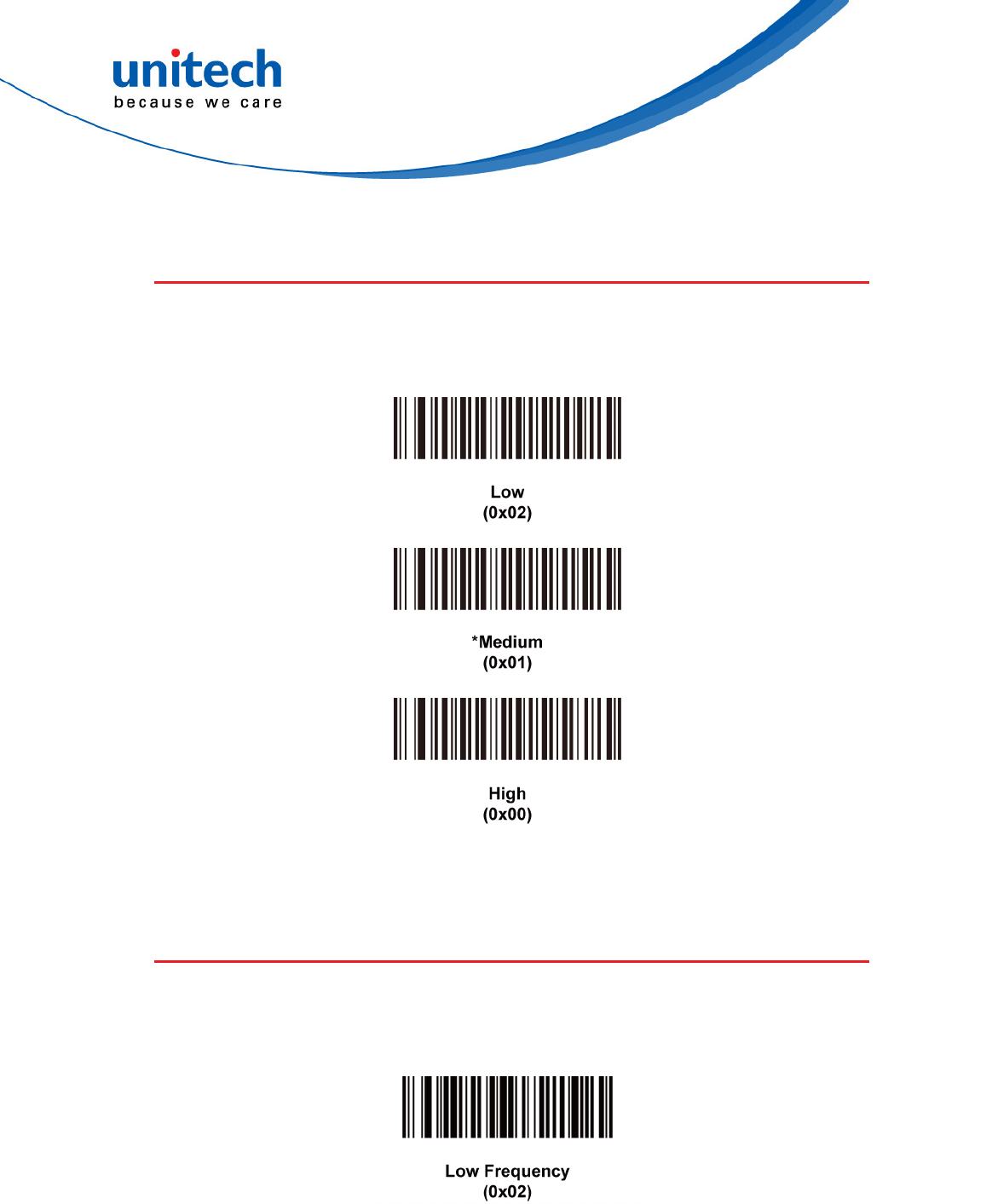
-
29
-
Beeper Volume
Parameter # 0x8C
To select a decode beep volume, scan the appropriate bar code.
Beeper Tone
Parameter # 0x91
To select a decode beep frequency (tone), scan the appropriate bar code.
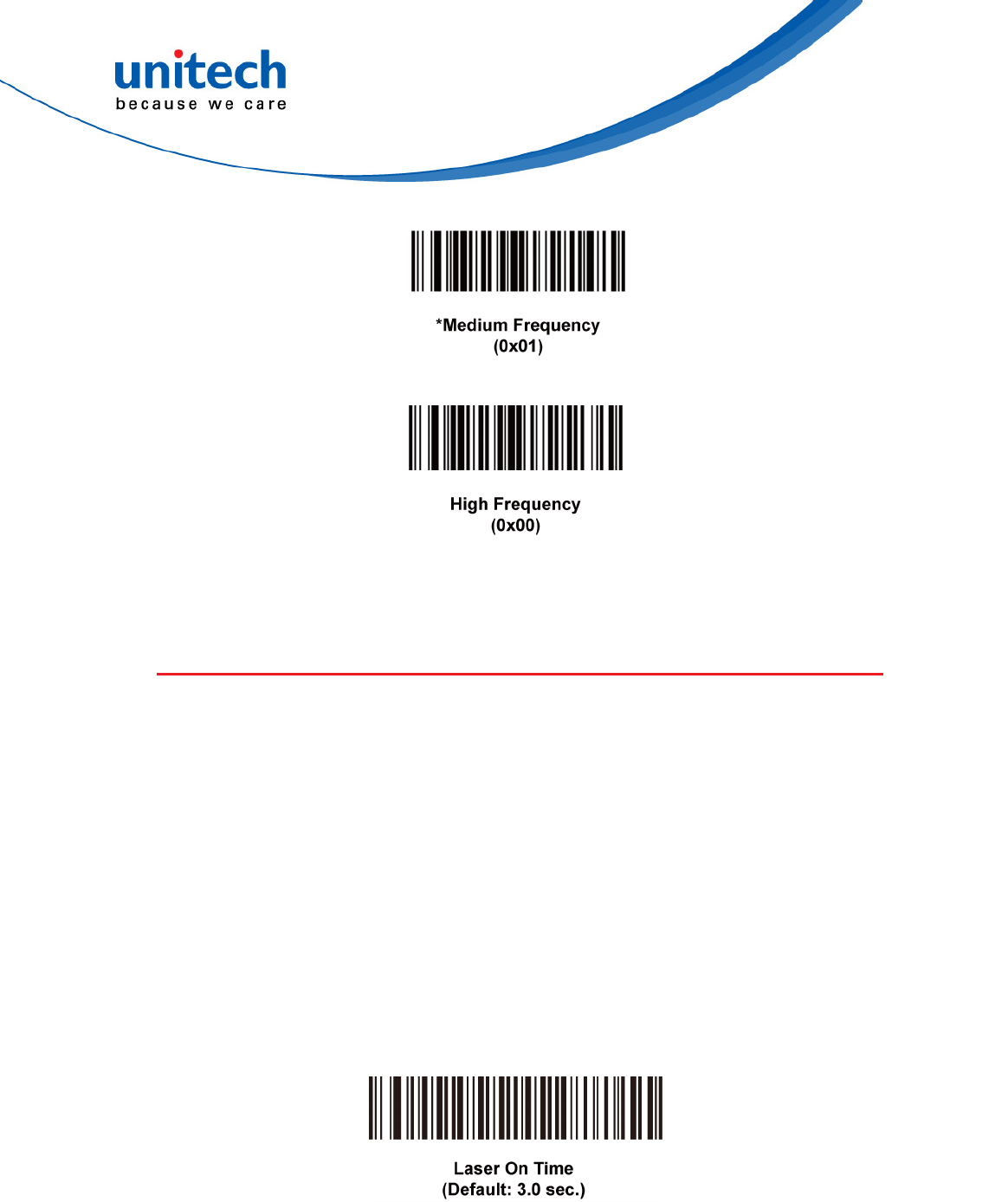
-
30
-
Laser On Time
Parameter # 0x88
This parameter sets the maximum time decode processing continues during a
scan attempt. It is programmable in 0.1 second increments from 0.50 to 25.5
seconds.
To set a Laser On Time, scan the bar code below. Next scan two numeric bar
codes beginning on page 77 that correspond to the desired on time. Single
digit numbers must have a leading zero. For example, to set an on time of 0.5
seconds, scan the bar code below, then scan the "0", "5" and "0" bar codes; to
set an on time of 10.5 seconds, scan the bar code below, then scan the "1", "0"
and "5" bar codes. To change the selection or cancel an incorrect entry, scan
Cancel on page 78.
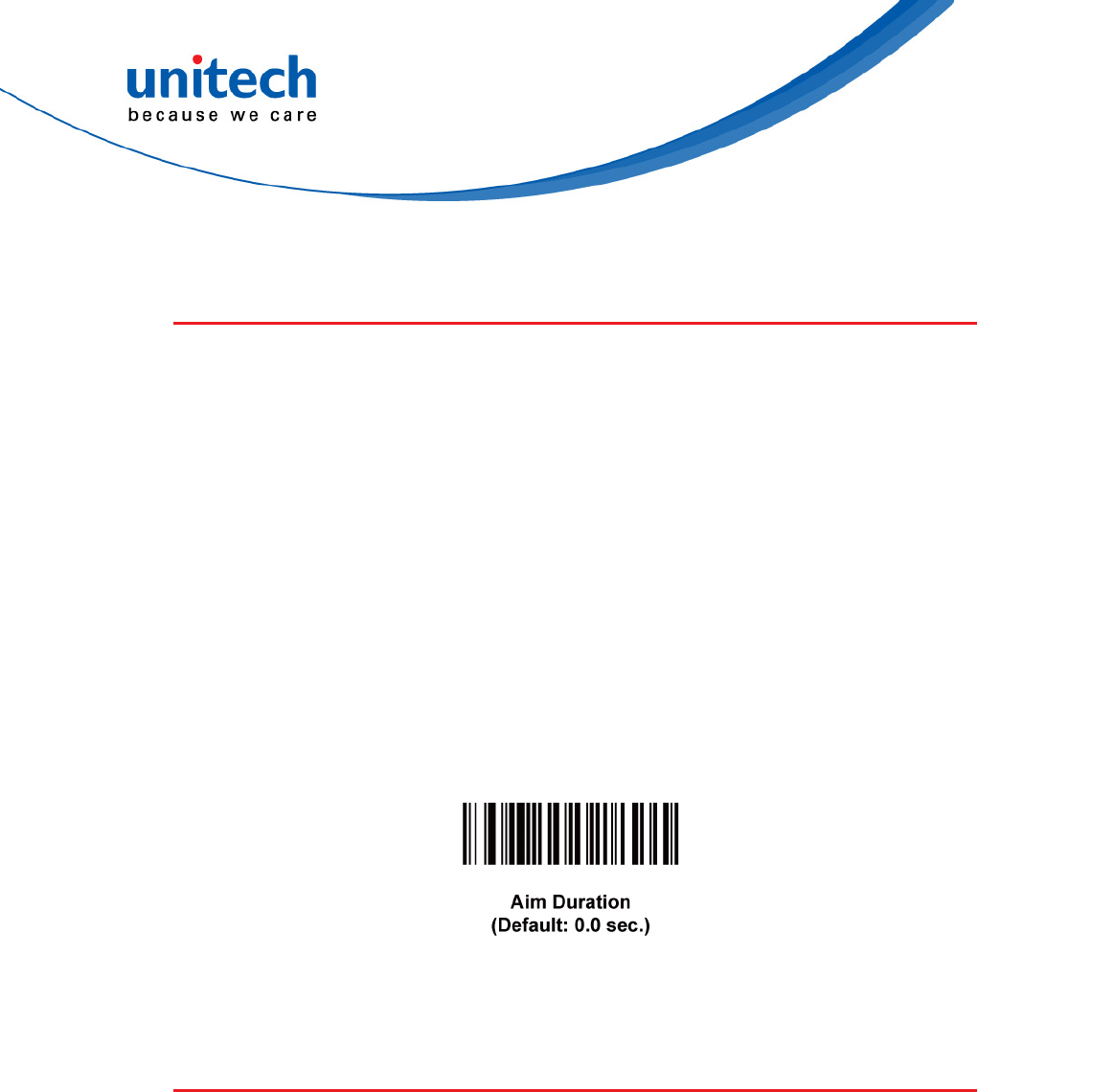
-
31
-
Aim Duration
Parameter # 0xED
When a scan engine with an aim mode is triggered either by a trigger pull, or a
START_DECODE command, this parameter sets the duration the aiming
pattern is seen before a a scan attempt begins. It does not apply to the aim
signal or the AIM_ON command. It is programmable in 0.1 second increments
from 0.0 to 9.9 seconds. No aim pattern is visible when the value is 0.0.
To set an aim duration, scan the bar code below. Next scan two numeric bar
codes beginning on page 77 that correspond to the desired aim duration.
Single digit numbers must have a leading zero. For example, to set an aim
duration of 0.5 seconds, scan the bar code below, then scan the “0” and “5” bar
codes. To change the selection or cancel an incorrect entry, scan Cancel on
page 78.
Triggering Modes
Parameter # 0x8A
Choose one of the options below to trigger the scan engine. Bar codes and
option numbers are on the following page.
• Scan (Level) - A trigger pull activates the laser and decode
processing. The laser remains on and decode processing continues
until a trigger release, a valid decode, or the Laser On Time-out is
reached.
• Scan (Pulse) - A trigger pull activates the laser and decode
processing. The laser remains on and decode processing continues
until a valid decode or the Laser On Time-out is reached.
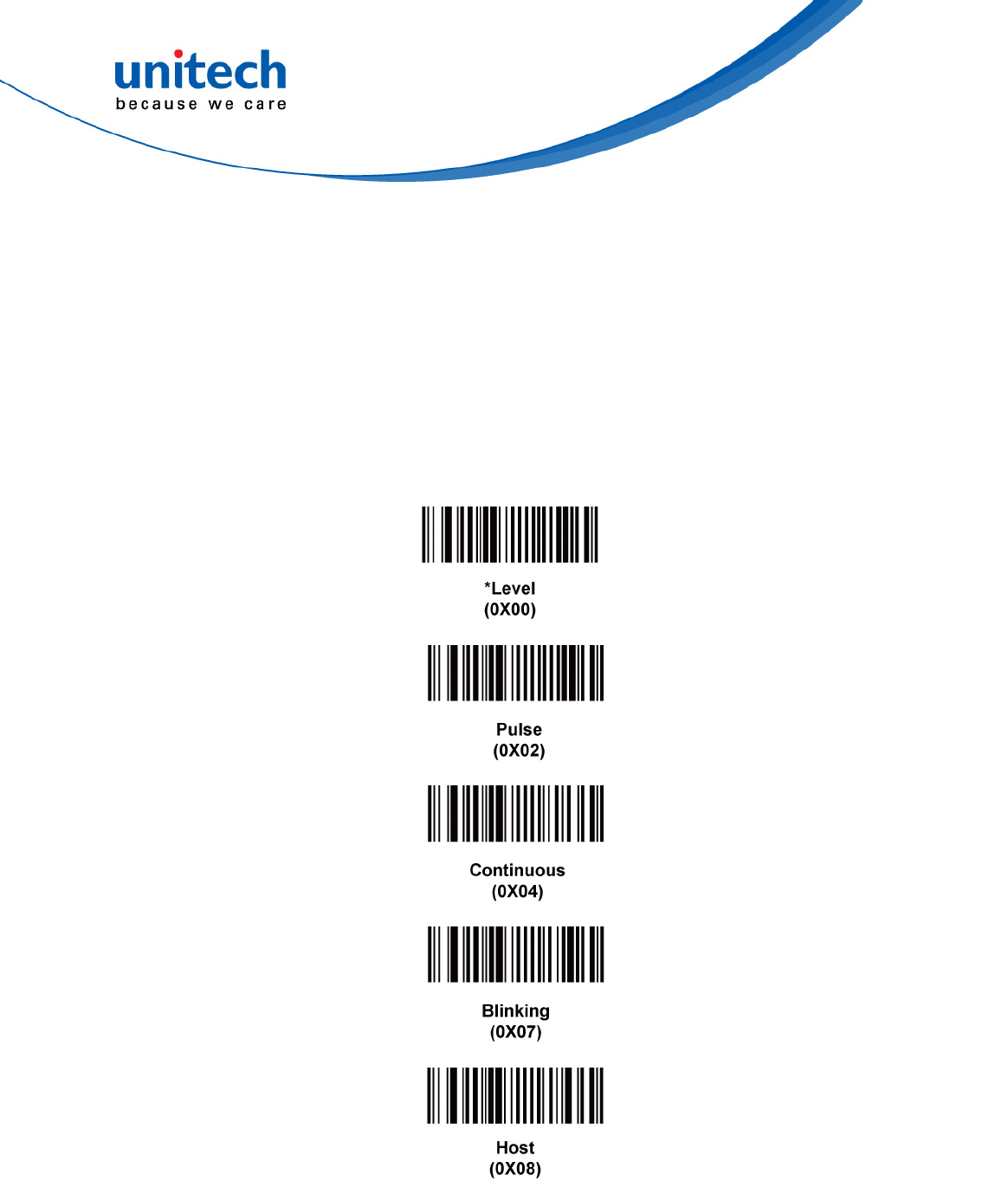
-
32
-
• Continuous - The laser is always on and decoding.
• Blink - This trigger mode is used for trigger less operation. Scanning
range is reduced in this mode. This mode cannot be used with
engines that support an aim mode.
• Host - A host command issues the triggering signal. The scan engine
interprets an actual trigger pull as a Level triggering option.
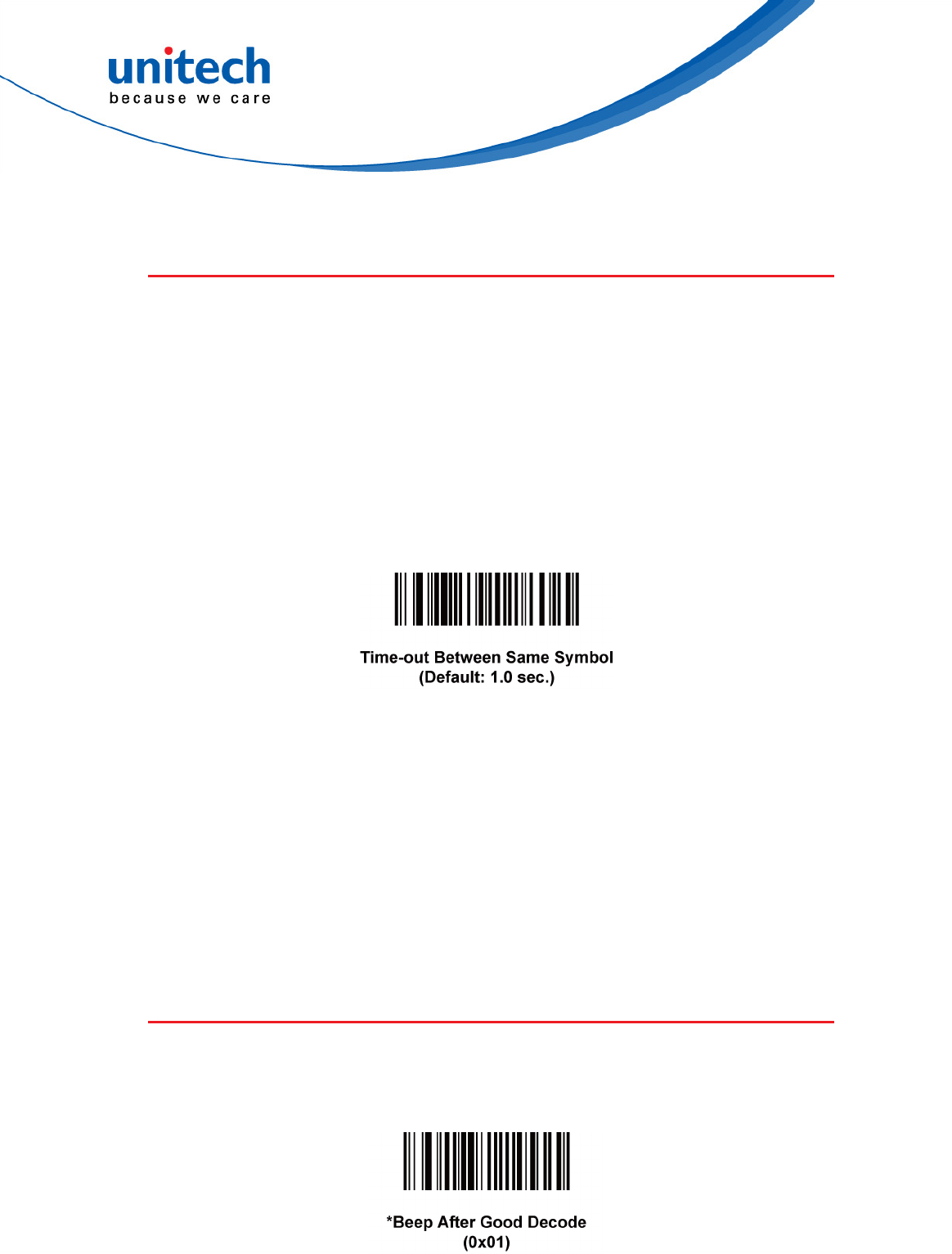
-
33
-
Time-out Between Same Symbol
Parameter # 0x89
When in Continuous triggering mode, this parameter sets the minimum time
that must elapse before the scan engine decodes a second bar code identical
to one just decoded. This reduces the risk of accidently scanning the same
symbol twice. It is programmable in 0.1 second increments from 0.0 to 9.9
seconds.
To set a time-out between same symbol, scan the bar code below. Next scan
two numeric bar codes beginning on page 77 that correspond to the desired
time-out. Single digit values must have a leading zero. For example, to set a
time-out of 0.5 seconds, scan the bar code below, then scan the “0” and “5” bar
codes. To change the selection or cancel an incorrect entry, scan Cancel on
page 78.
Beep After Good Decode
Parameter # 0x38
Scan this symbol to set the scan engine to beep after a good decode.
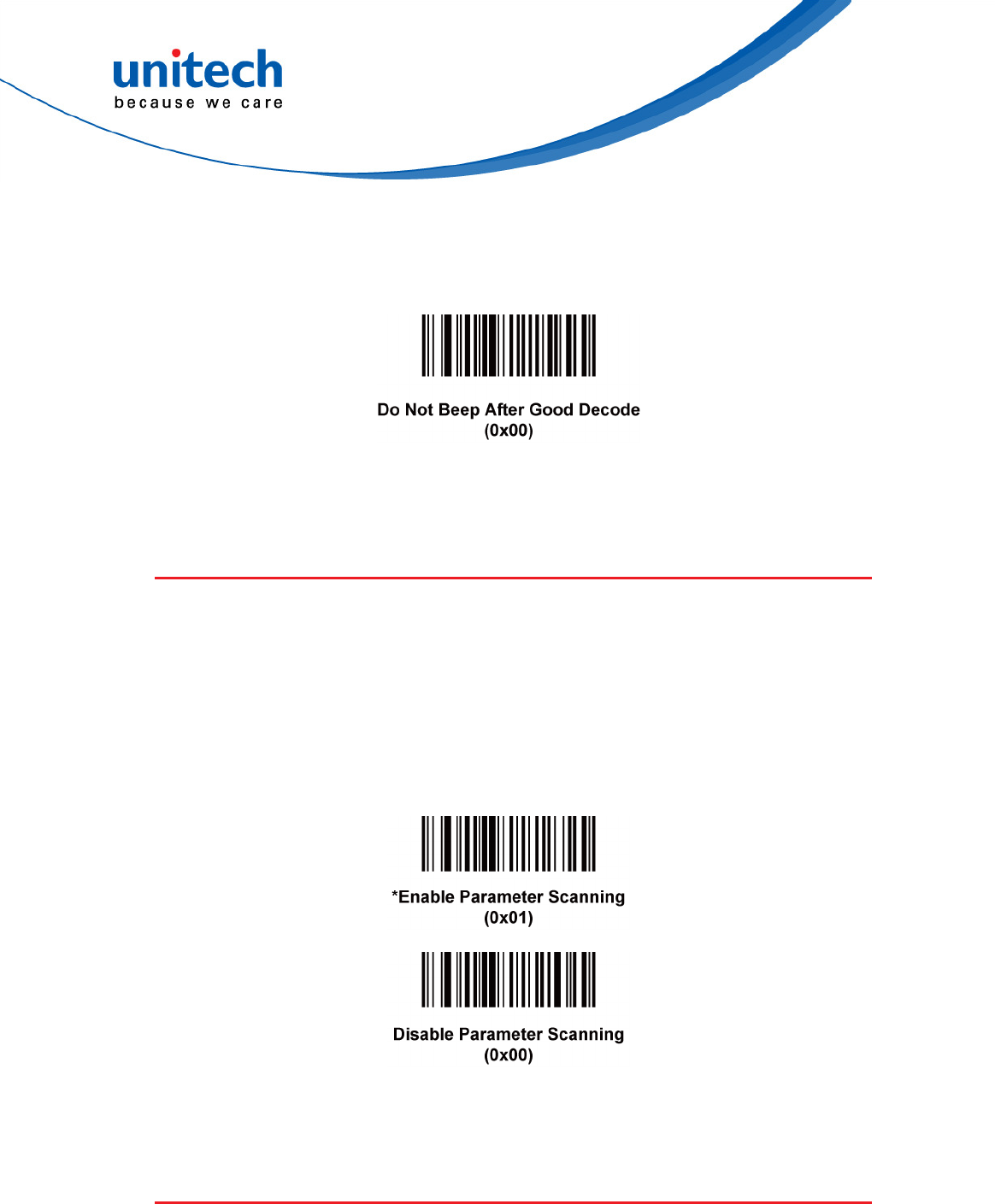
-
34
-
Scan this symbol to set the scan engine not to beep after a good decode.
The beeper still operates during parameter menu scanning and indicates error
conditions.
Parameter Scanning
Parameter # 0xEC
To disable decoding of parameter bar codes, scan the bar code below. The Set
Defaults parameter bar code can still be decoded. To enable decoding of
parameter bar codes, either scan Enable Parameter Scanning below, Set
Factory Defaults on page 29 or set this parameter to 0x01 via a serial
command.
Parameter Pass Through
Parameter # 0xF1 0x71
Enable Parameter Pass Through to transmit bar codes in the following format,
in Code 128, to the host:
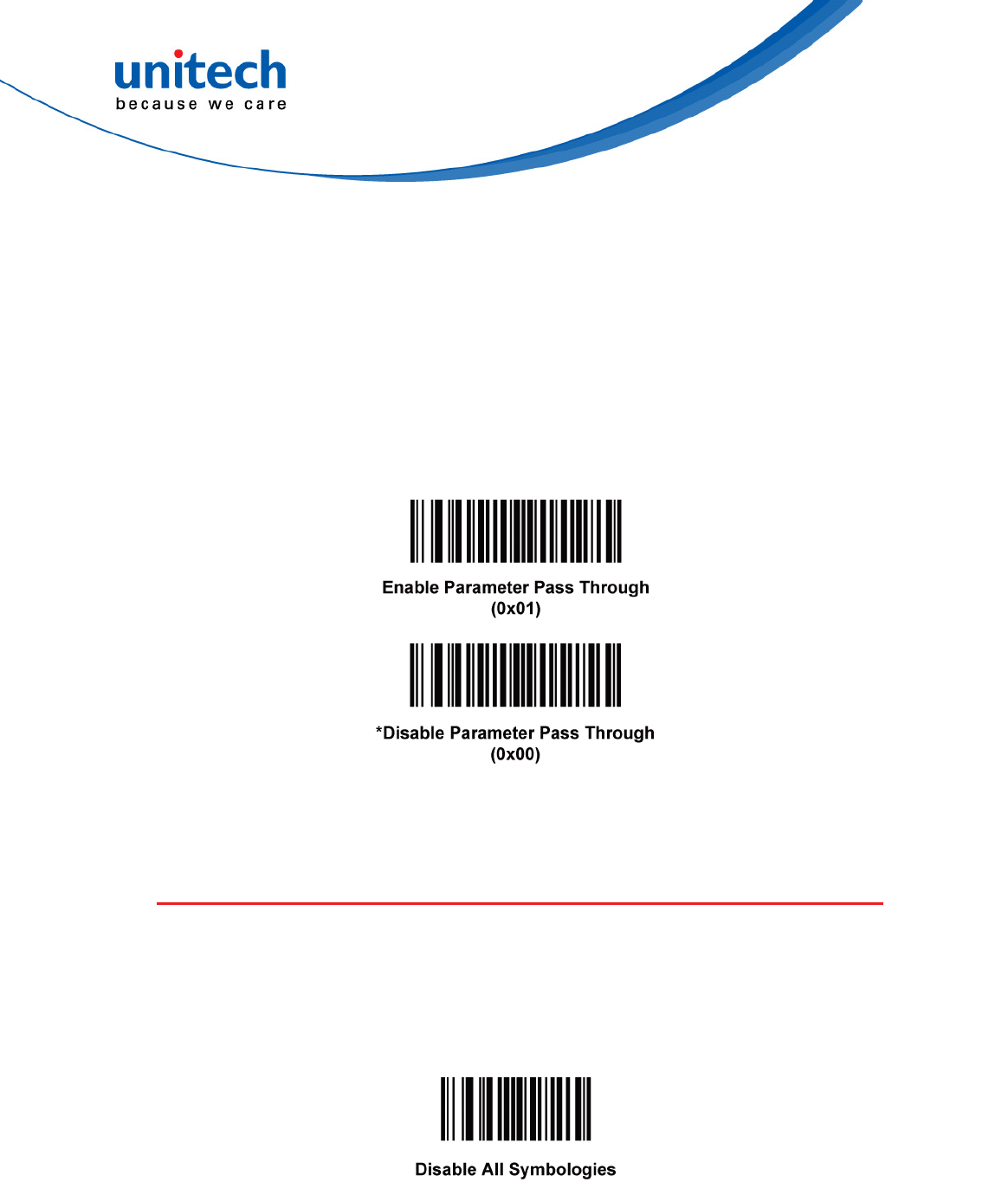
-
35
-
<FNC3>L<any length data>
<FNC3>B<12 characters of data>
Note that the special Code 128 character <FNC3> must appear at the
beginning of this data. However, if the appropriate data does not follow this as
shown above, it does not transmit to the host device.
Disable All Symbologies
Scan the bar code below to disable the decoding of all symbologies. Use this
to simplify selecting a single symbology to decode by scanning this, then
scanning the desired enable code type bar code. Note that the decoder can
still decode parameter bar codes.
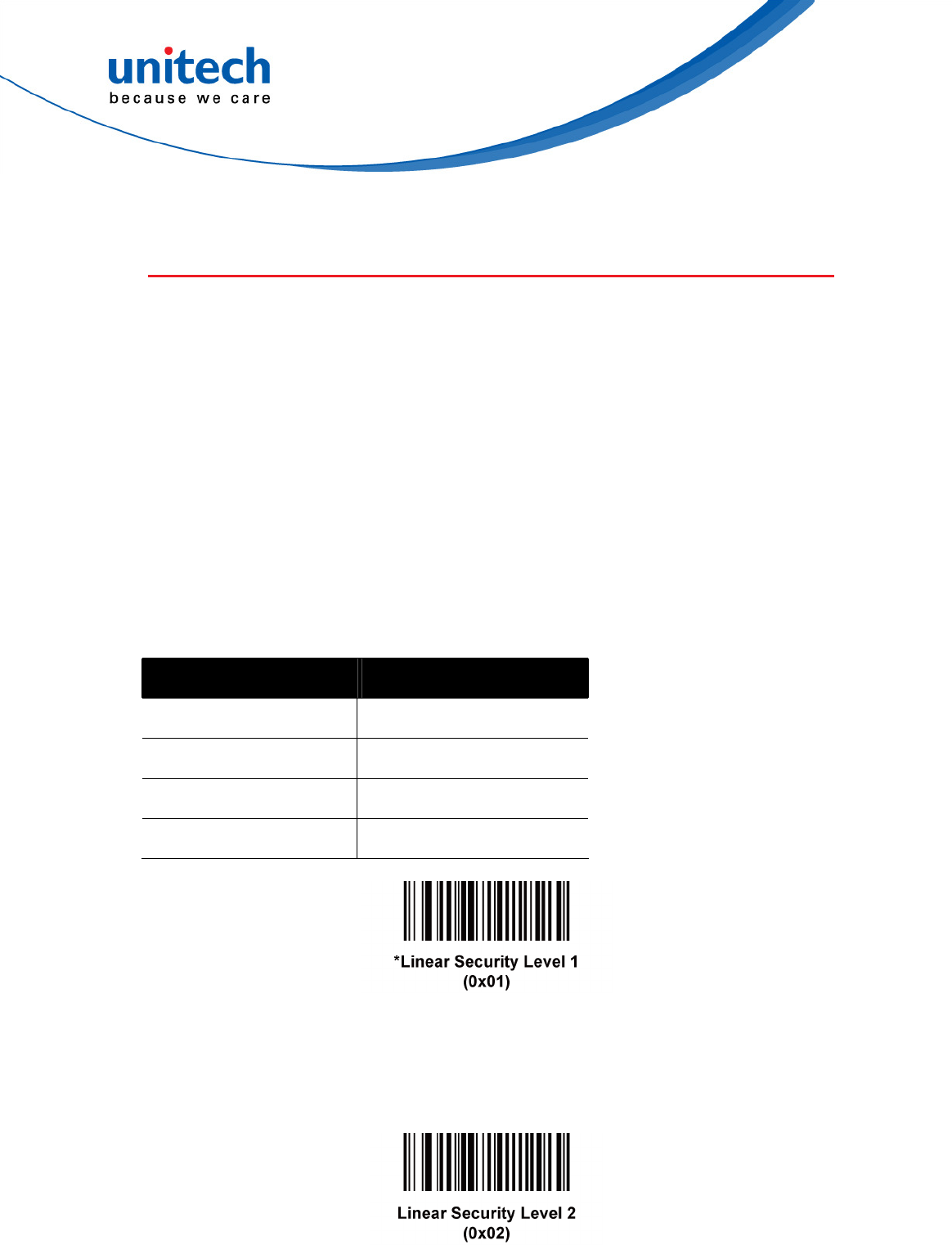
-
36
-
Linear Code Type Security Level
Parameter # 0x4E
The MS916 offers four levels of decode security for linear code types (e.g.
Code 39, Interleaved 2 of 5). Select higher security levels for decreasing levels
of bar code quality. As security levels increase, the scan engine’s
aggressiveness decreases.
Select the security level appropriate for your bar code quality.
Linear Security Level 1
The following code types must be successfully read twice before being
decoded:
Code Type Length
Codabar All
MSI 4 or less
D 2 of 5 8 or less
I 2 of 5 8 or less
Linear Security Level 2
All code types must be successfully read twice before being decoded.
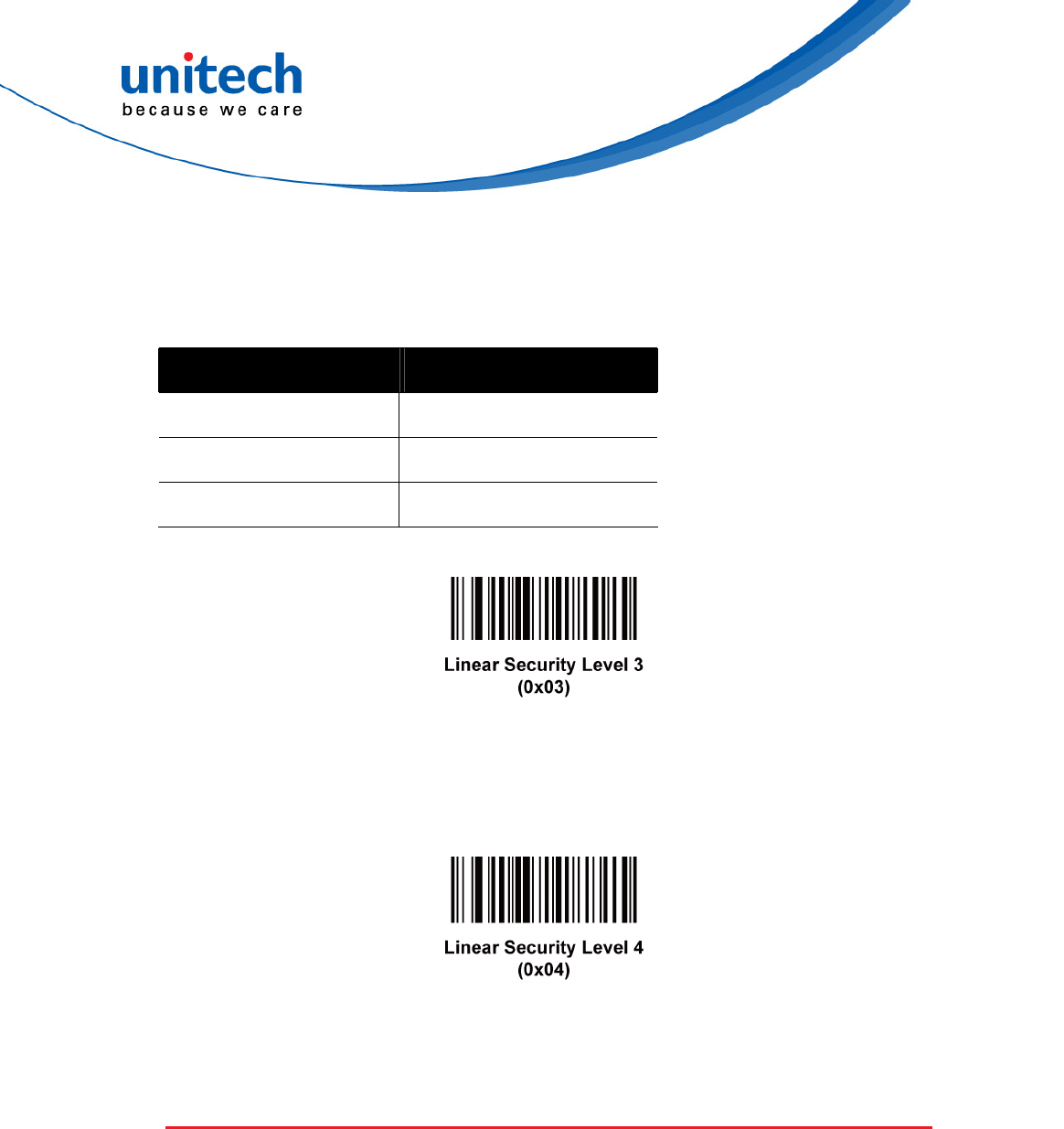
-
37
-
Linear Security Level 3
Code types other than the following must be successfully read twice before
being decoded. The following codes must be read three times:
Code Type Length
MSI 4 or less
D 2 of 5 8 or less
I 2 of 5 8 or less
Linear Security Level 4
All code types must be successfully read three times before being decoded.
Bi-directional Redundancy
Parameter # 0x43
This parameter is only valid when a Linear Code Type Security Level is
enabled (see page 37). When this parameter is enabled, a bar code must be
successfully scanned in both directions (forward and reverse) before being
decoded.
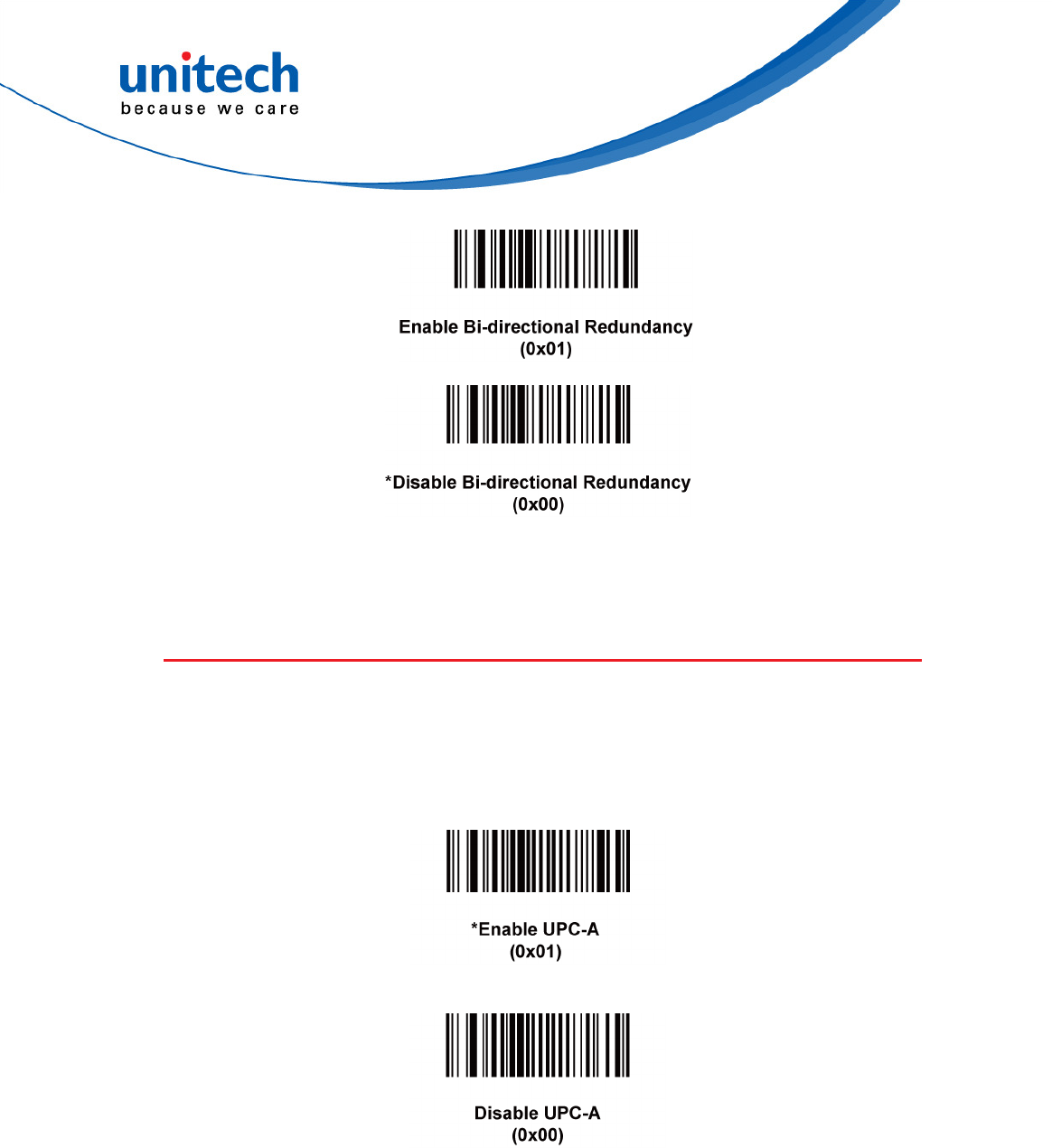
-
38
-
UPC/EAN
Enable/Disable UPC-A
Parameter # 0x01
To enable or disable UPC-A, scan the appropriate bar code below.
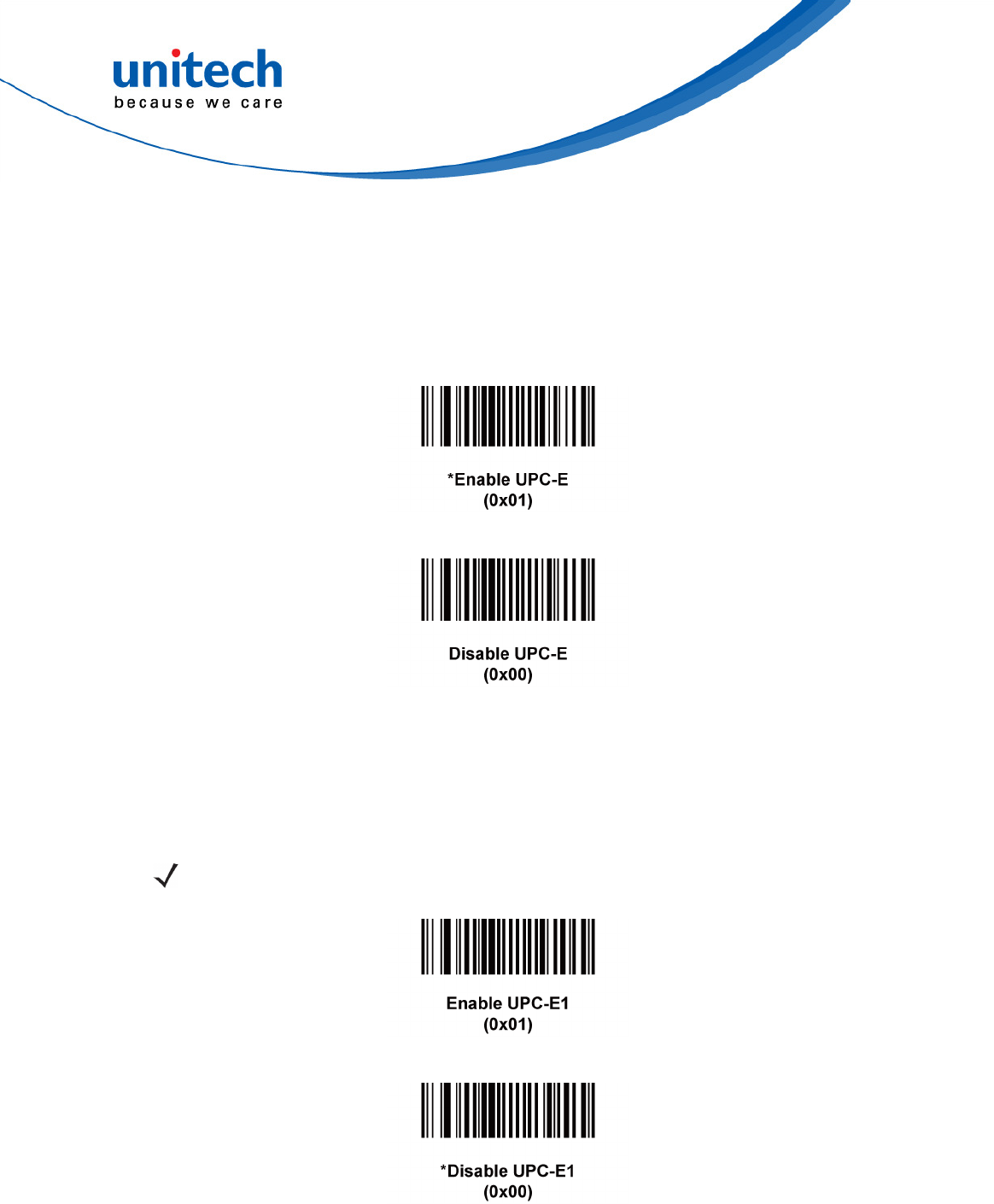
-
39
-
Enable/Disable UPC-E
Parameter # 0x02
To enable or disable UPC-E, scan the appropriate bar code below.
Enable/Disable UPC-E1
Parameter # 0x0C
To enable or disable UPC-E1, scan the appropriate bar code below.
NOTE
UPC-E1 is not a UCC (Uniform Code Council) approved symbology.
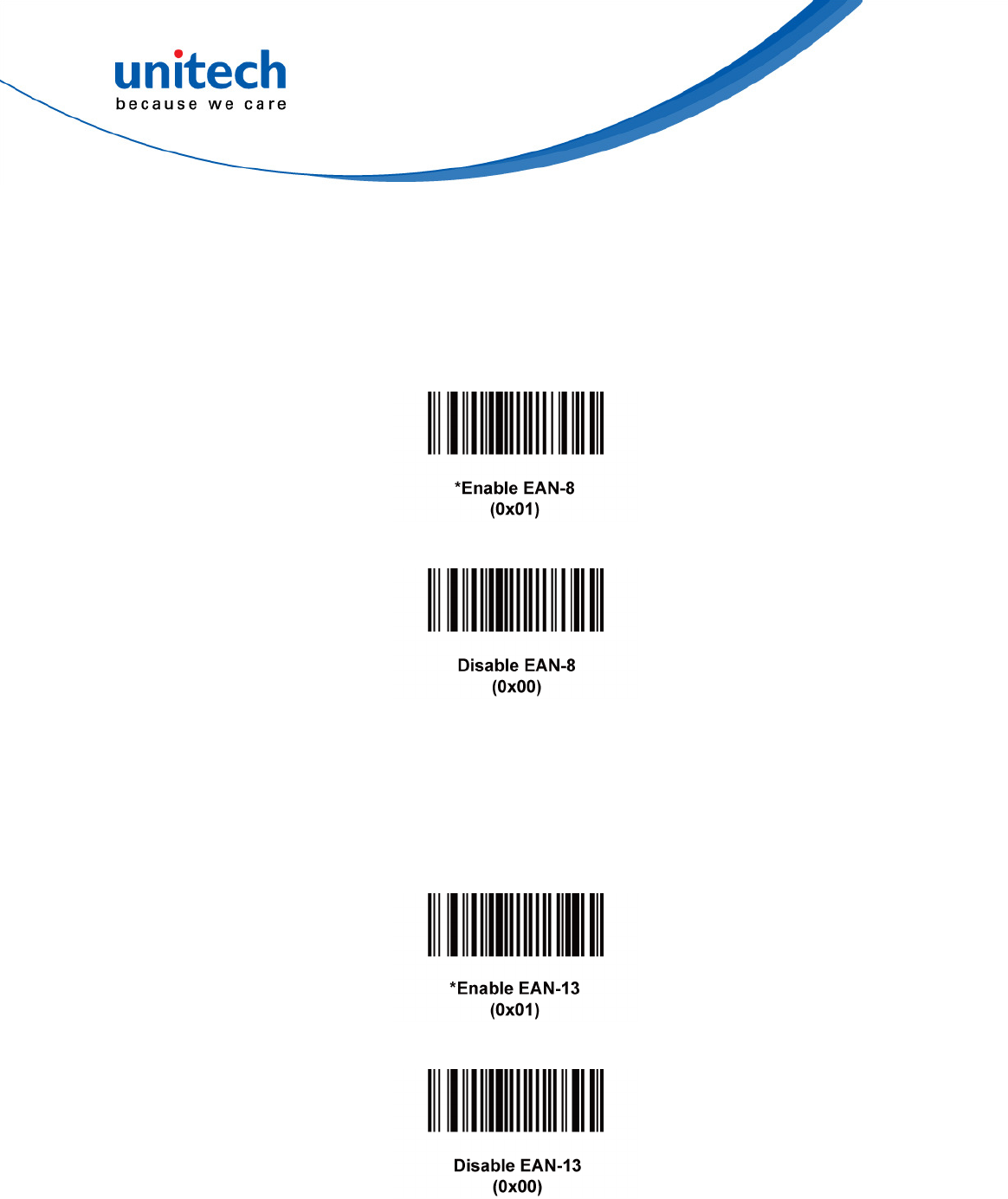
-
40
-
Enable/Disable EAN-8
Parameter # 0x04
To enable or disable EAN-8, scan the appropriate bar code below.
Enable/Disable EAN-13
Parameter # 0x03
To enable or disable EAN-13, scan the appropriate bar code below.
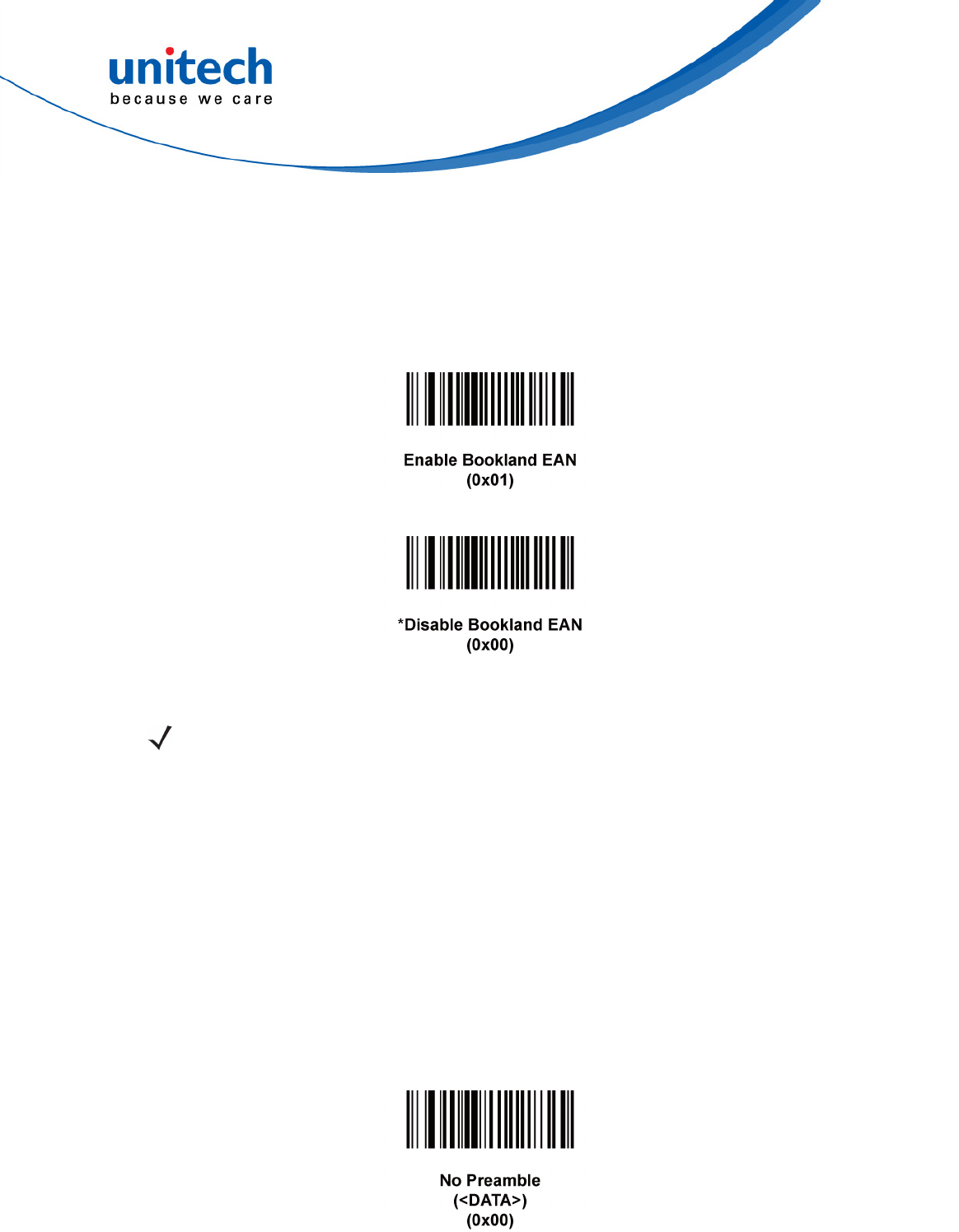
-
41
-
Enable/Disable Bookland EAN
Parameter # 0x53
To enable or disable EAN Bookland, scan the appropriate bar code below.
NOTE
If you enable Bookland EAN, select a Bookland ISBN Format on page 46.
UPC-A Preamble
Parameter # 0x22
Preamble characters (Country Code and System Character) can be
transmitted as part of a UPC-A symbol.
Select one of the following options for transmitting UPC-A preamble to the host
device: transmit system character only, transmit system character and country
code (“0” for USA), or transmit no preamble.
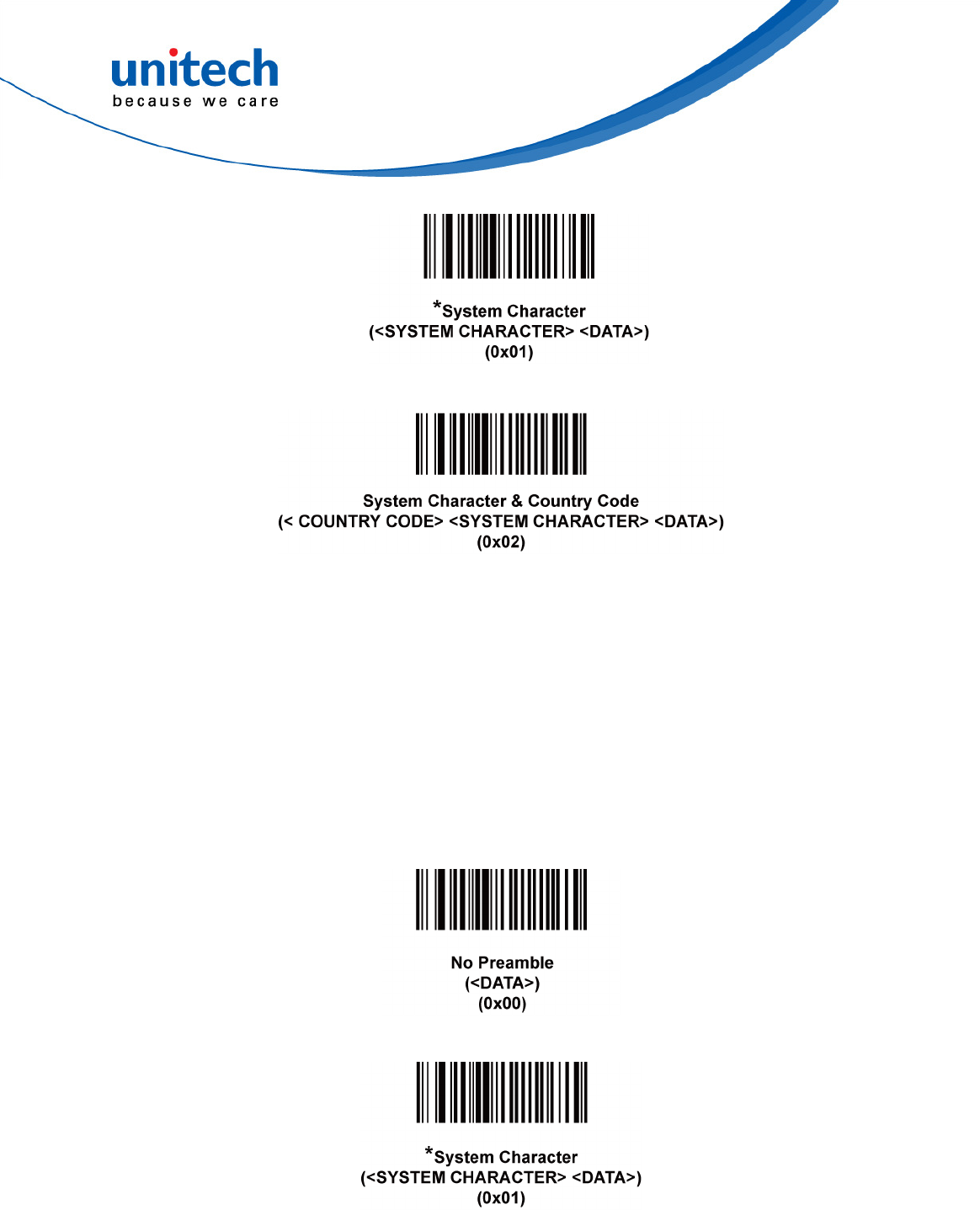
-
42
-
UPC-E Preamble
Parameter # 0x23
Preamble characters (Country Code and System Character) can be
transmitted as part of a UPC-E symbol.
Select one of the following options for transmitting UPC-E preamble to the host
device: transmit system character only, transmit system character and country
code (“0” for USA), or transmit no preamble.
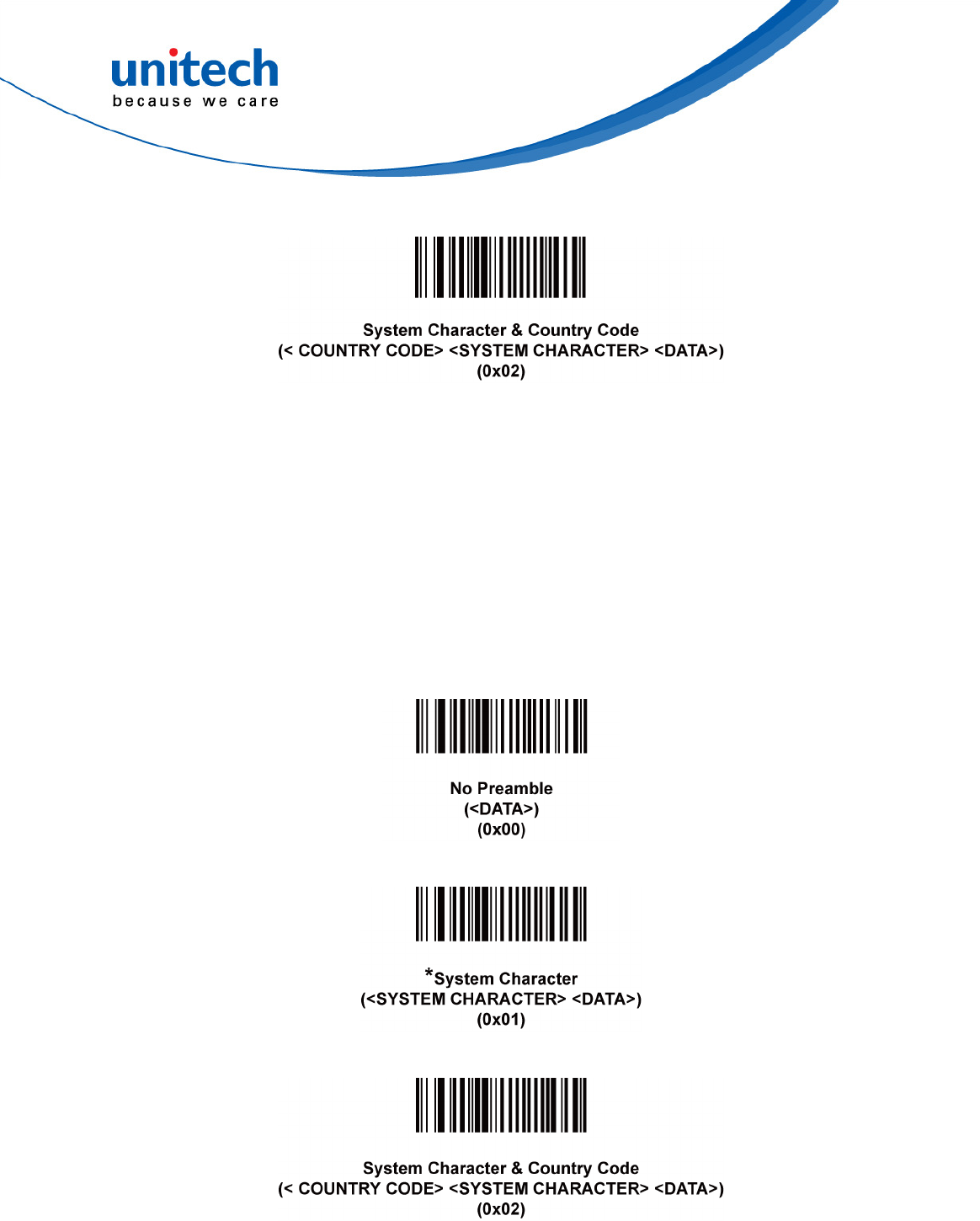
-
43
-
UPC-E1 Preamble
Parameter # 0x24
Preamble characters (Country Code and System Character) can be
transmitted as part of a UPC-E1 symbol.
Select one of the following options for transmitting UPC-E1 preamble to the
host device: transmit system character only, transmit system character and
country code (“0” for USA), or transmit no preamble.
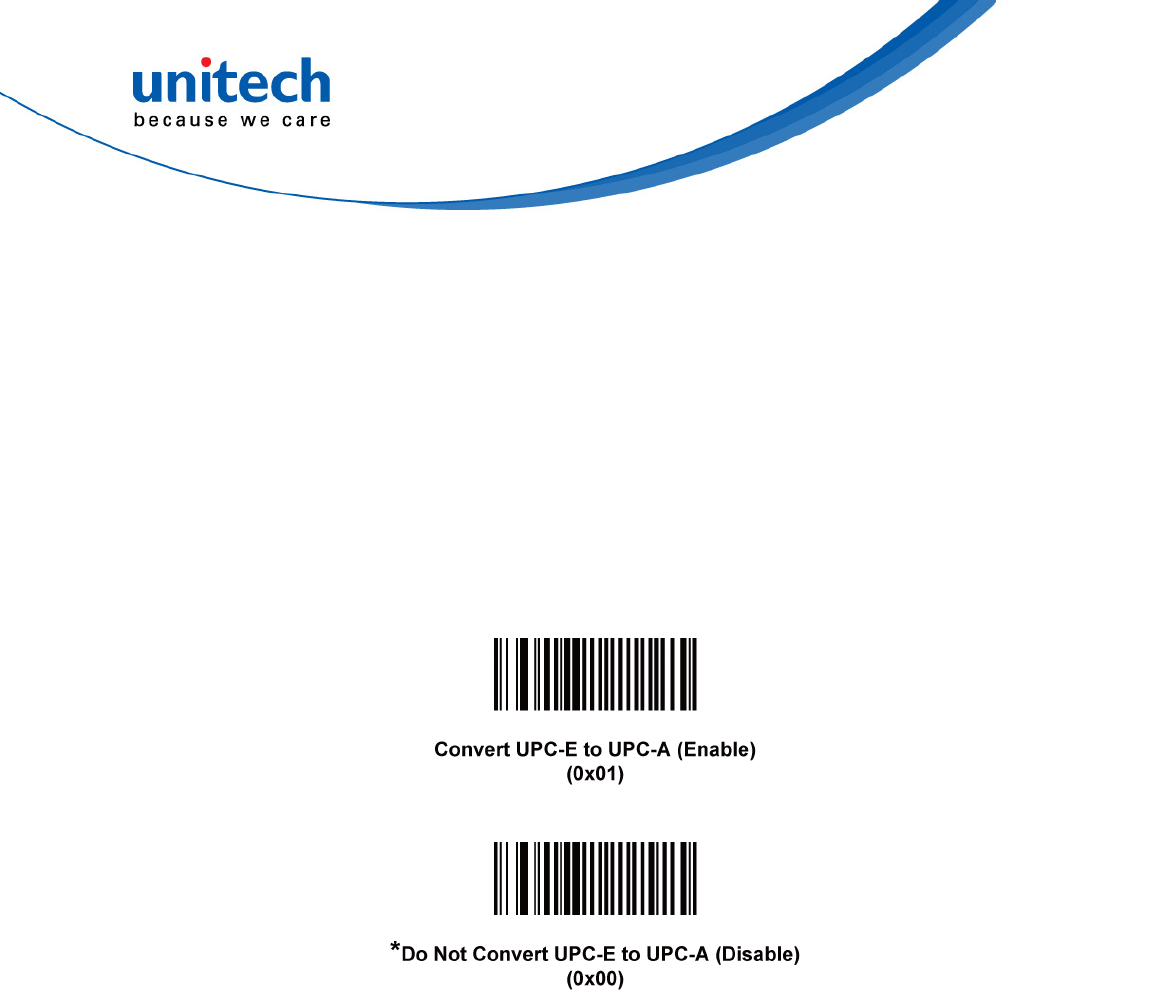
-
44
-
Convert UPC-E to UPC-A
Parameter # 0x25
Enable this parameter to convert UPC-E (zero suppressed) decoded data to
UPC-A format before transmission. After conversion, data follows UPC-A
format and is affected by UPC-A programming selections (e.g., Preamble,
Check Digit).
Scan DO NOT CONVERT UPC-E TO UPC-A to transmit UPC-E (zero
suppressed) decoded data.
Convert UPC-E1 to UPC-A
Parameter # 0x26
Enable this parameter to convert UPC-E1 (zero suppressed) decoded data to
UPC-A format before transmission. After conversion, data follows UPC-A
format and is affected by UPC-A programming selections (e.g., Preamble,
Check Digit).
Scan DO NOT CONVERT UPC-E TO UPC-A to transmit UPC-E1 (zero
suppressed) decoded data.
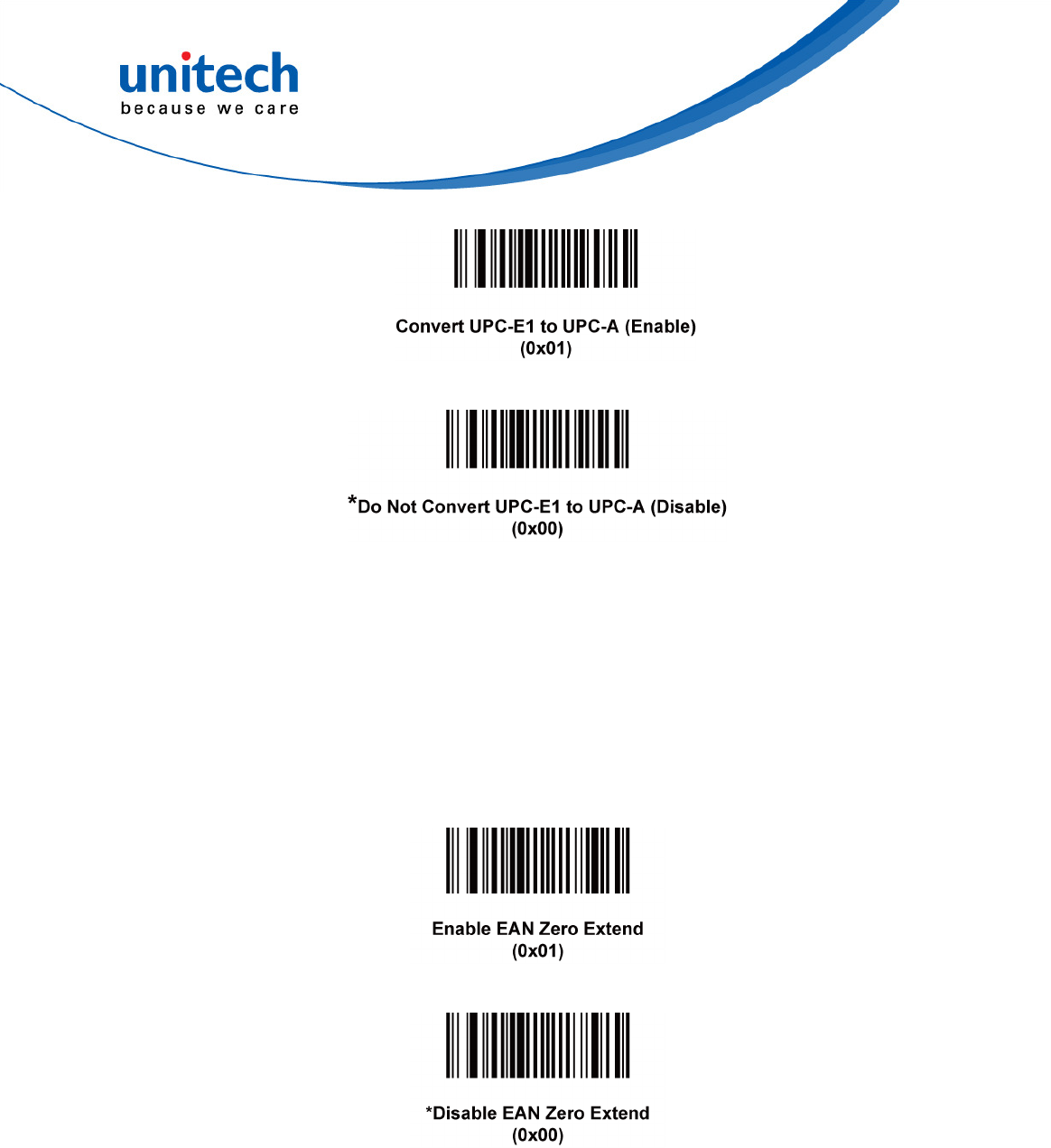
-
45
-
EAN Zero Extend
Parameter # 0x27
When enabled, this parameter adds five leading zeros to decoded EAN-8
symbols to make them compatible in format to EAN-13 symbols.
Disable this parameter to transmit EAN-8 symbols as is.
Bookland ISBN Format
Parameter # 0xF1 0x40
If you enabled Bookland EAN using Enable/Disable Bookland EAN on page 42,
select one of the following formats for Bookland data:
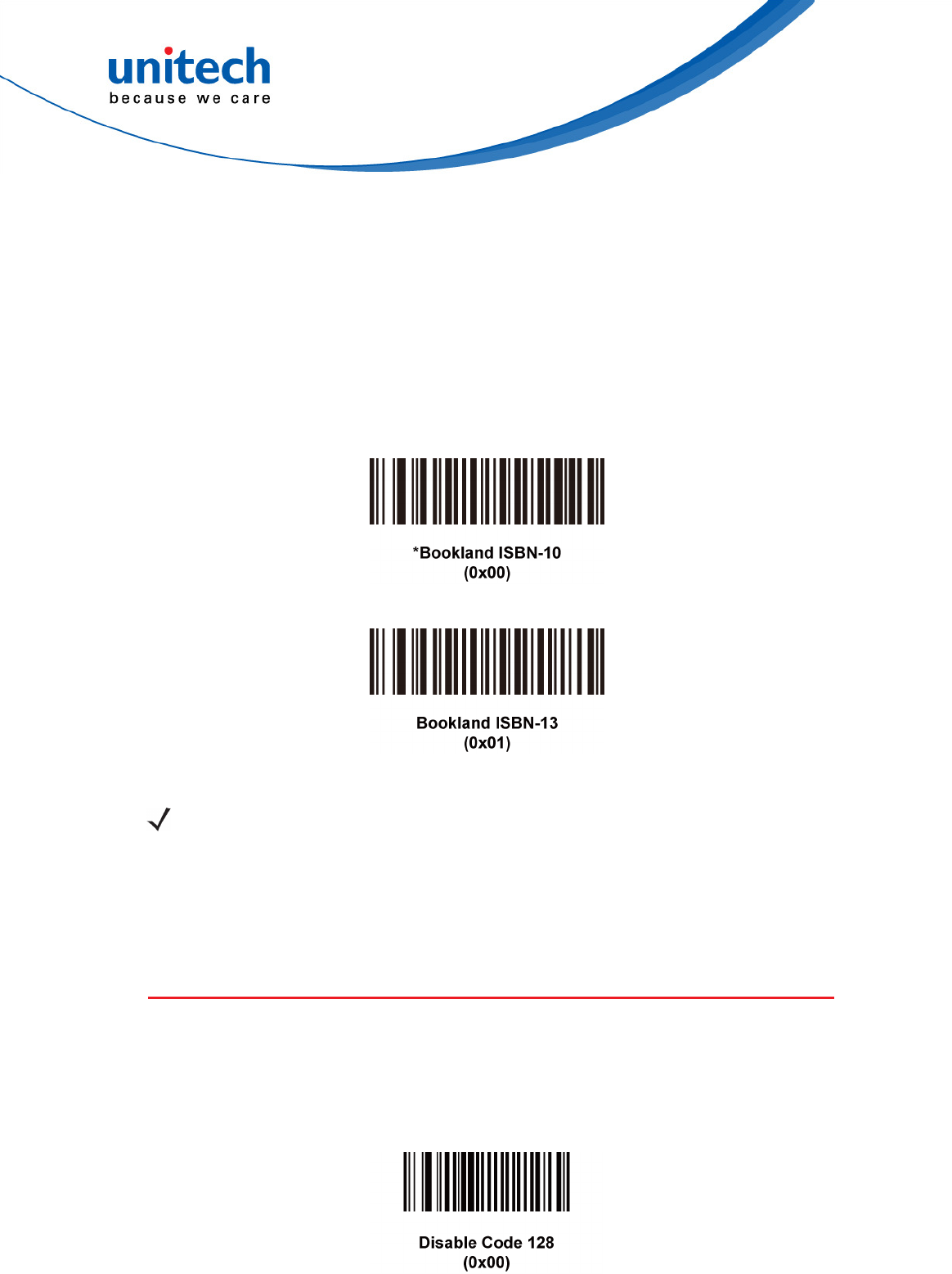
-
46
-
• Bookland ISBN-10 - The scanner reports Bookland data starting with
978 in traditional 10-digit format with the special Bookland check digit
for backward-compatibility. Data starting with 979 is not considered
Bookland in this mode.
• Bookland ISBN-13 - The scanner reports Bookland data (starting
with either 978 or 979) as EAN-13 in 13-digit format to meet the 2007
ISBN-13 protocol.
NOTE
For Bookland EAN to function properly, first enable Bookland EAN using
Enable/Disable Bookland EAN on page 42.
Code 128
Enable/Disable Code 128
Parameter # 0x08
To enable or disable Code 128, scan the appropriate bar code below.
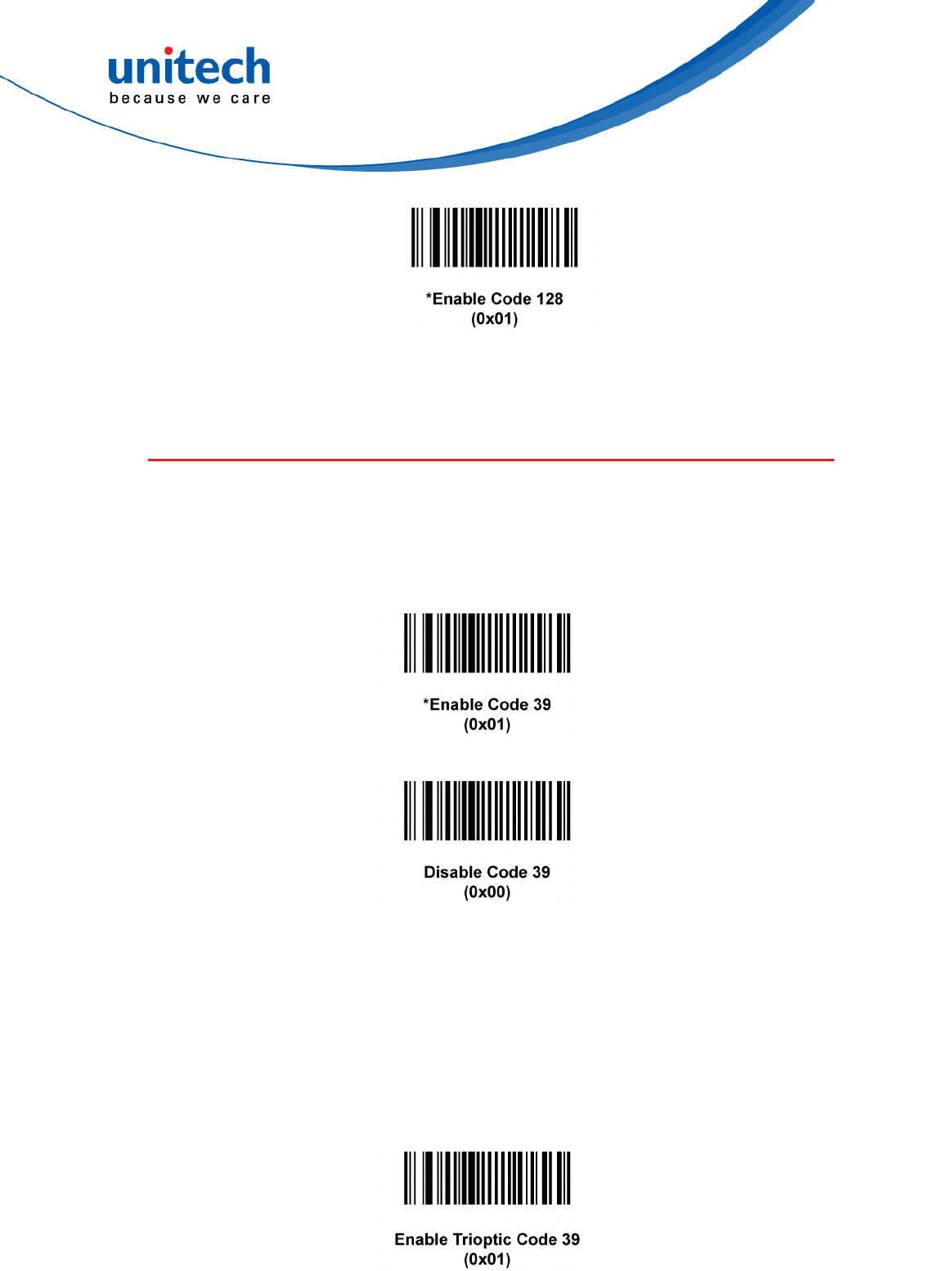
-
47
-
Code 39
Enable/Disable Code 39
Parameter # 0x00
To enable or disable Code 39, scan the appropriate bar code below.
Enable/Disable Trioptic Code 39
Parameter # 0x0D
Trioptic Code 39 is a variant of Code 39 used in marking computer tape
cartridges. Trioptic Code 39 symbols always contain six characters.
To enable or disable Trioptic Code 39, scan the appropriate bar code below.
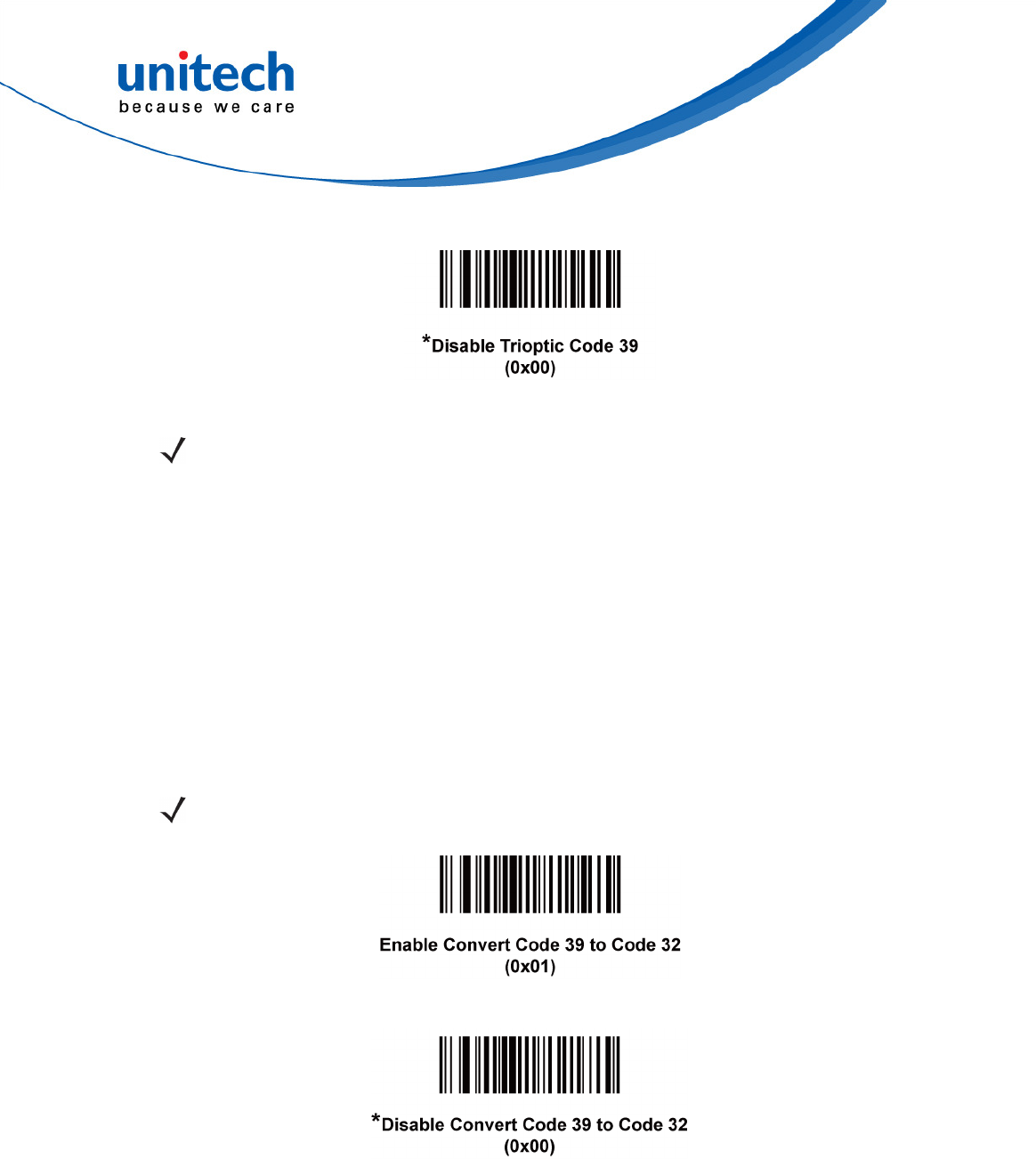
-
48
-
NOTE
Trioptic Code 39 and Code 39 Full ASCII cannot be enabled simultaneously. If
an error beep sounds when enabling Trioptic Code 39, disable Code 39 Full
ASCII and try again.
Convert Code 39 to Code 32 (Italian Pharma
Code)
Parameter # 0x56
Code 32 is a variant of Code 39 used by the Italian pharmaceutical industry.
Scan the appropriate bar code below to enable or disable converting Code 39
to Code 32.
NOTE
Code 39 must be enabled in order for this parameter to function.
Code 32 Prefix
Parameter # 0xE7
Enable this parameter to add the prefix character “A” to all Code 32 bar codes.
Convert Code 39 to Code 32 (Italian Pharma Code) must be enabled for this
parameter to function.
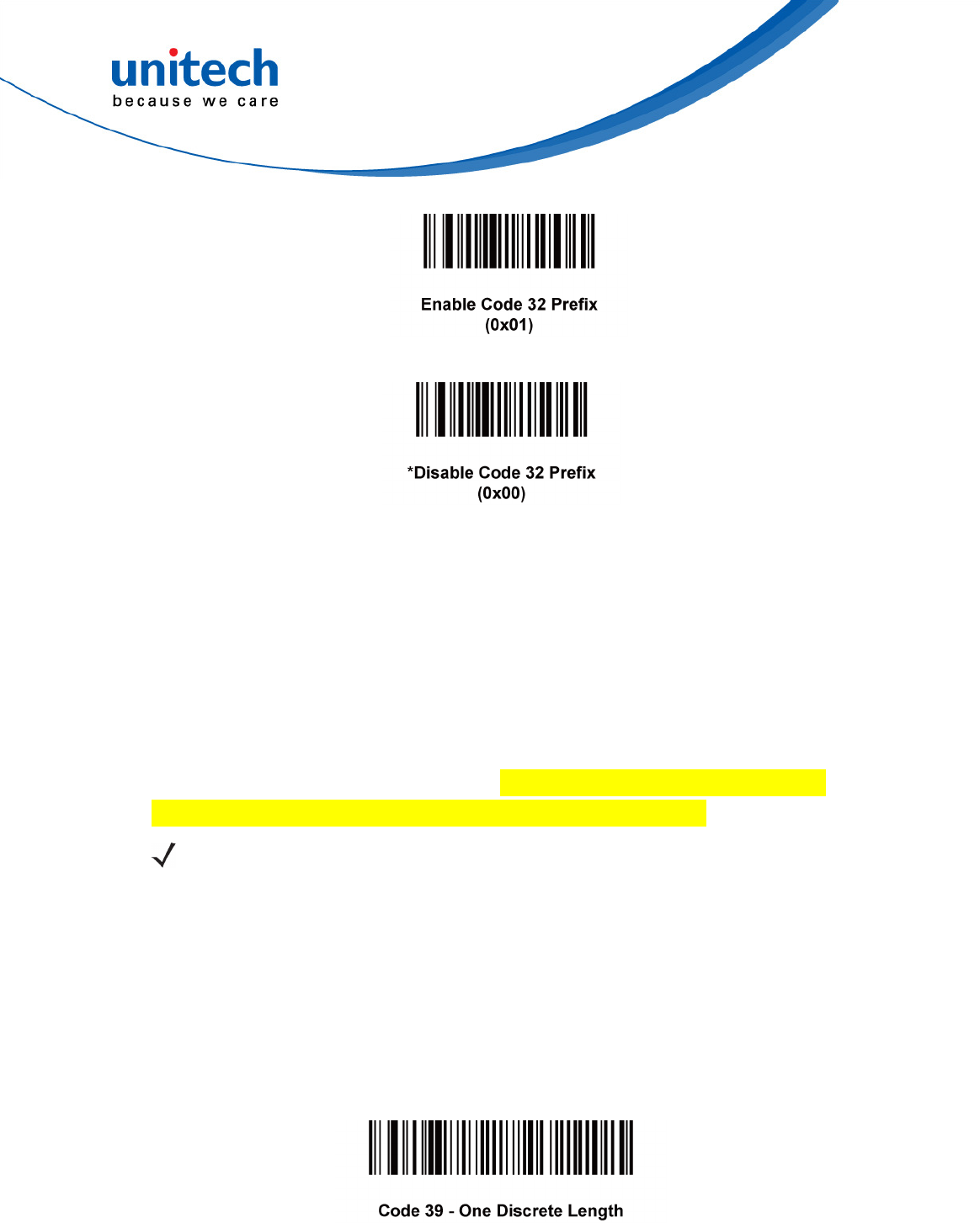
-
49
-
Set Lengths for Code 39
Parameter # L1 = 0x12, L2 = 0x13
The length of a code refers to the number of characters (i.e., human readable
characters), including check digit(s) the code contains. Lengths for Code 39
may be set for any length, one or two discrete lengths, or lengths within a
specific range. If Code 39 Full ASCII is enabled, Length Within a Range or
Any Length are the preferred options. To set lengths via serial commands,
see Setting Code Lengths Via Serial Commands on page B-6.
NOTE
When setting lengths, single digit numbers must always be preceded by a
leading zero.
One Discrete Length - This option limits decodes to only those Code 39
symbols containing a selected length. Lengths are selected from the numeric
bar codes beginning on page 77. For example, to decode only Code 39
symbols with 14 characters, scan Code 39 - One Discrete Length, then scan
1 followed by 4. To change the selection or cancel an incorrect entry, scan
Cancel on page 78.
Two Discrete Lengths - This option limits decodes to only those Code 39
symbols containing either of two selected lengths. Lengths are selected from
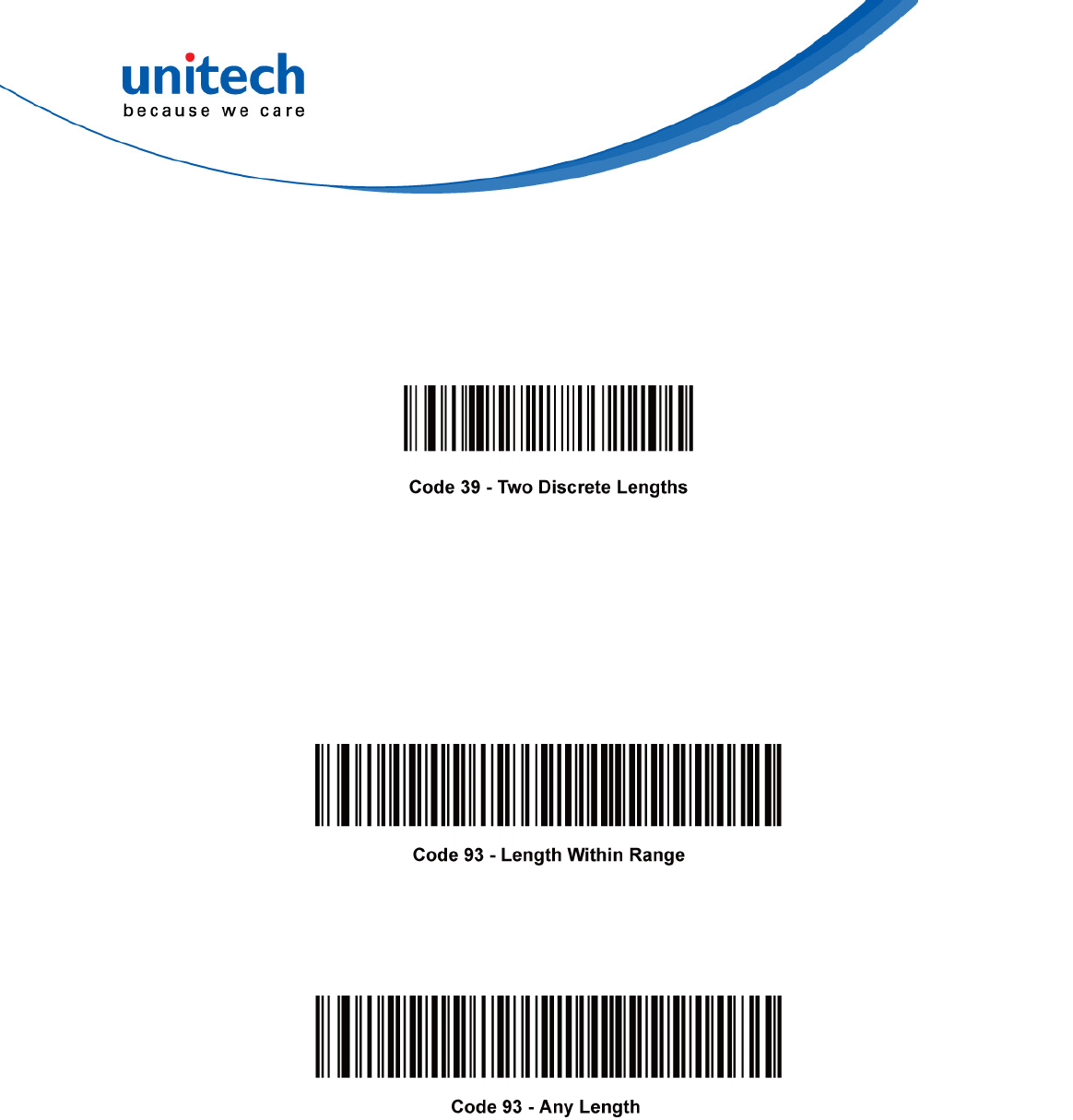
-
50
-
the numeric bar codes beginning on page 77. For example, to decode only
those Code 39 symbols containing either 2 or 14 characters, select Code 39 -
Two Discrete Lengths, then scan 0, 2, 1, and then 4. To change the selection
or cancel an incorrect entry, scan Cancel on page 78.
Length Within Range - This option limits decodes to only those Code 39
symbols within a specified range. For example, to decode Code 39 symbols
containing between 4 and 12 characters, first scan Code 39 - Length Within
Range. Then scan 0, 4, 1, and 2. Numeric bar codes begin on page 77. To
change the selection or cancel an incorrect entry, scan Cancel on page 78.
Any Length - Scan this option to decode Code 39 symbols containing any
number of characters.
Code 39 Check Digit Verification
Parameter # 0x30
When this feature is enabled, the scan engine checks the integrity of all Code
39 symbols to verify that the data complies with specified check digit algorithm.
Only those Code 39 symbols which include a modulo 43 check digit are
decoded. Only enable this feature if your Code 39 symbols contain a module
43 check digit.
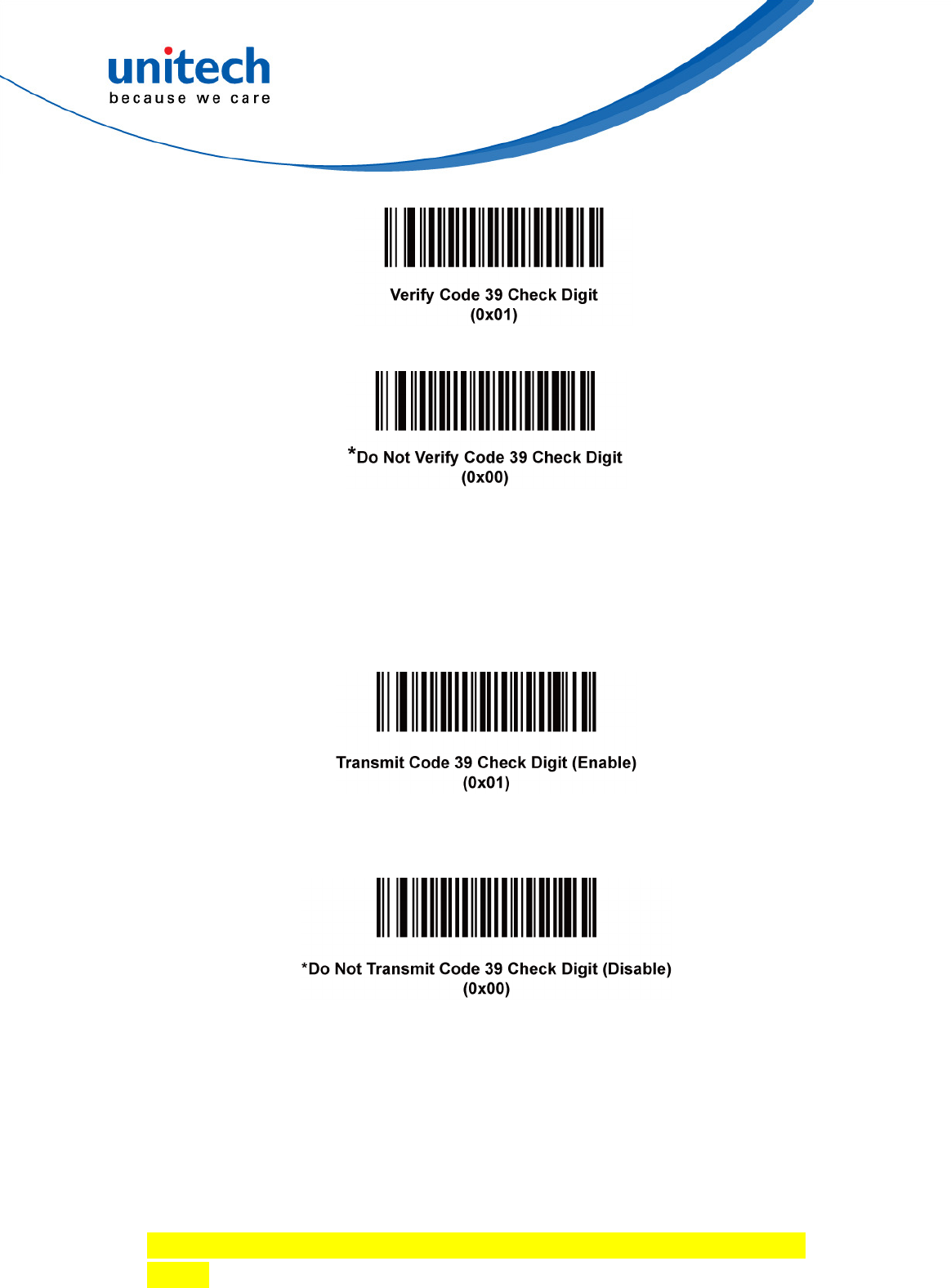
-
51
-
Transmit Code 39 Check Digit
Parameter # 0x2B
Scan this symbol to transmit the check digit with the data.
Scan this symbol to transmit data without the check digit.
Enable/Disable Code 39 Full ASCII
Parameter # 0x11
Code 39 Full ASCII is a variant of Code 39 which pairs characters to encode
the full ASCII character set. To enable or disable Code 39 Full ASCII, scan the
appropriate bar code below.
See Table B-5 on page B-7 for the mapping of Code 39 characters to ASCII
values.
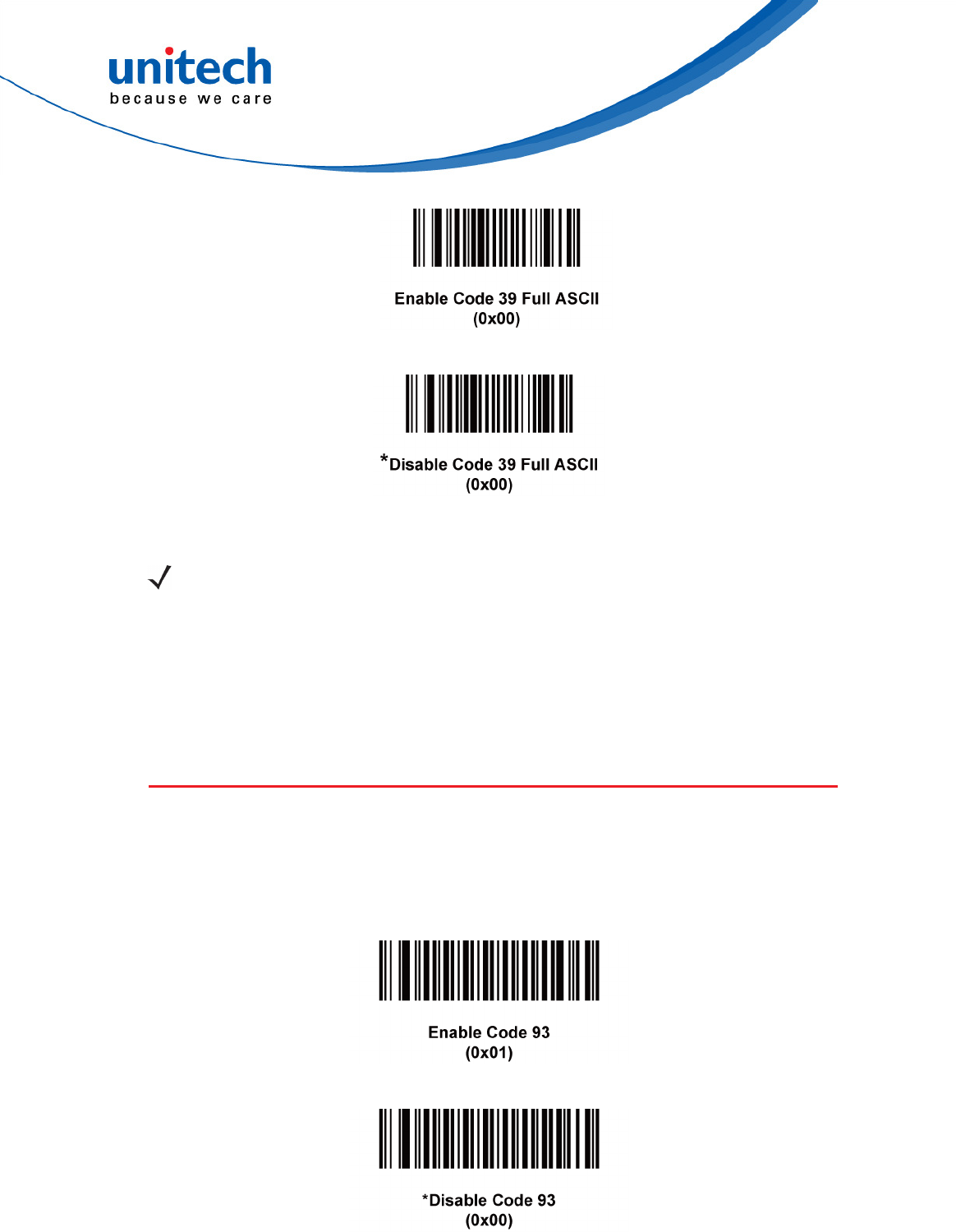
-
52
-
NOTE
Trioptic Code 39 and Code 39 Full ASCII cannot be enabled simultaneously. If
you get an error beep when enabling Code 39 Full ASCII, disable Trioptic
Code 39 and try again.
Code 93
Enable/Disable Code 93
Parameter # 0x09
To enable or disable Code 93, scan the appropriate bar code below.
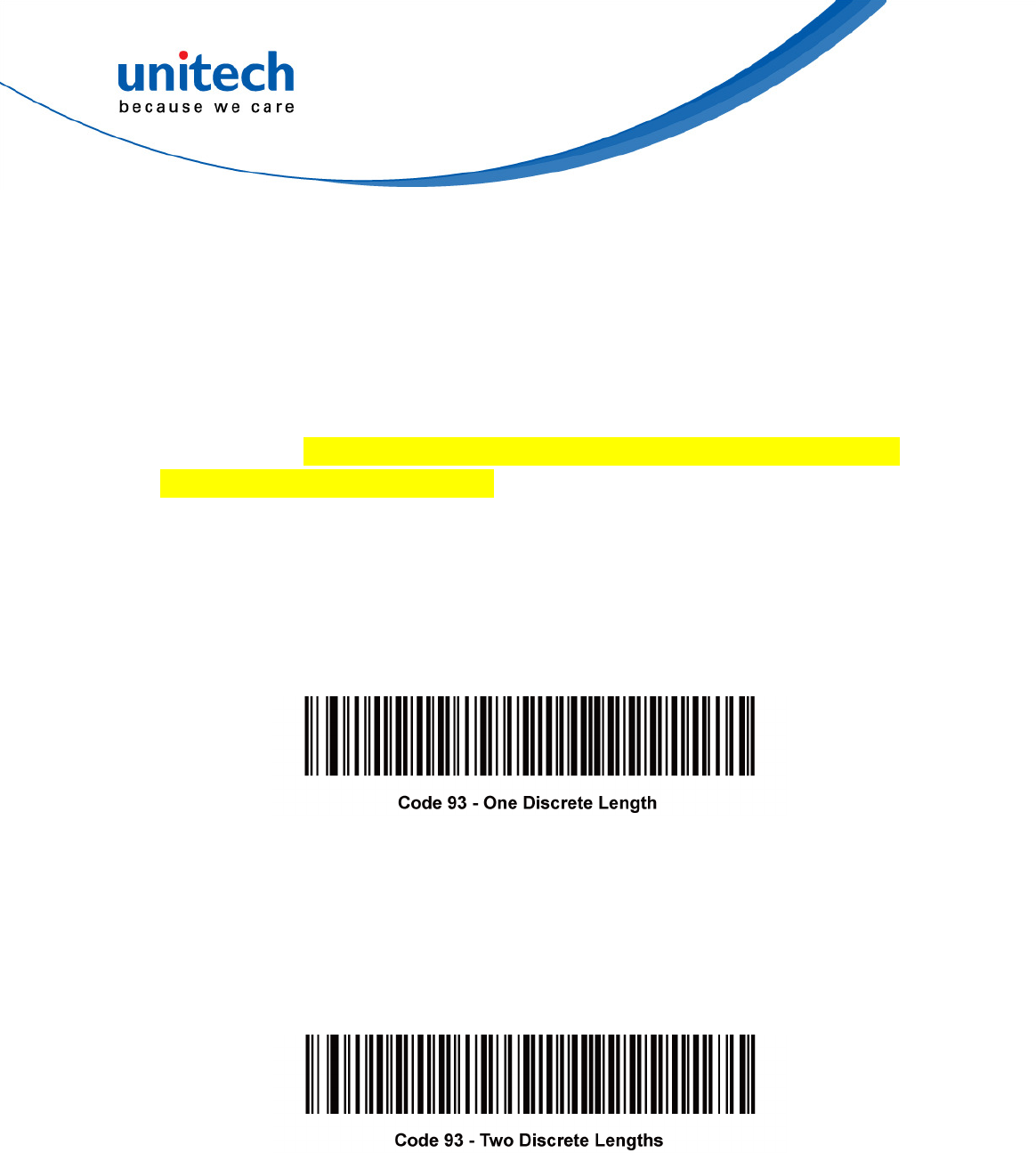
-
53
-
Set Lengths for Code 93
Parameter # L1 = 0x1A, L2 = 0x1B
The length of a code refers to the number of characters (i.e., human readable
characters), including check digit(s) the code contains. Lengths for Code 93
may be set for any length, one or two discrete lengths, or lengths within a
specific range. To set lengths via serial commands, see Setting Code Lengths
Via Serial Commands on page B-6.
One Discrete Length - Select this option to decode only those codes
containing a selected length. For example, select Code 93 One Discrete
Length, then scan 1, 4, to limit the decoding to only Code 93 symbols
containing 14 characters. Numeric bar codes begin on page 77. To change the
selection or cancel an incorrect entry, scan Cancel on page 78.
Two Discrete Lengths - Select this option to decode only those codes
containing two selected lengths. For example, select Code 93 Two Discrete
Lengths, then scan 0, 2, 1, 4, to limit the decoding to only Code 93 symbols
containing 2 or 14 characters. Numeric bar codes begin on page 77. To change
the selection or cancel an incorrect entry, scan Cancel on page 78.
Length Within Range - This option sets the unit to decode a code type within
a specified range. For example, to decode Code 93 symbols containing
between 4 and 12 characters, first scan Code 93 Length Within Range, then
scan 0, 4, 1 and 2 (single digit numbers must always be preceded by a leading
zero).
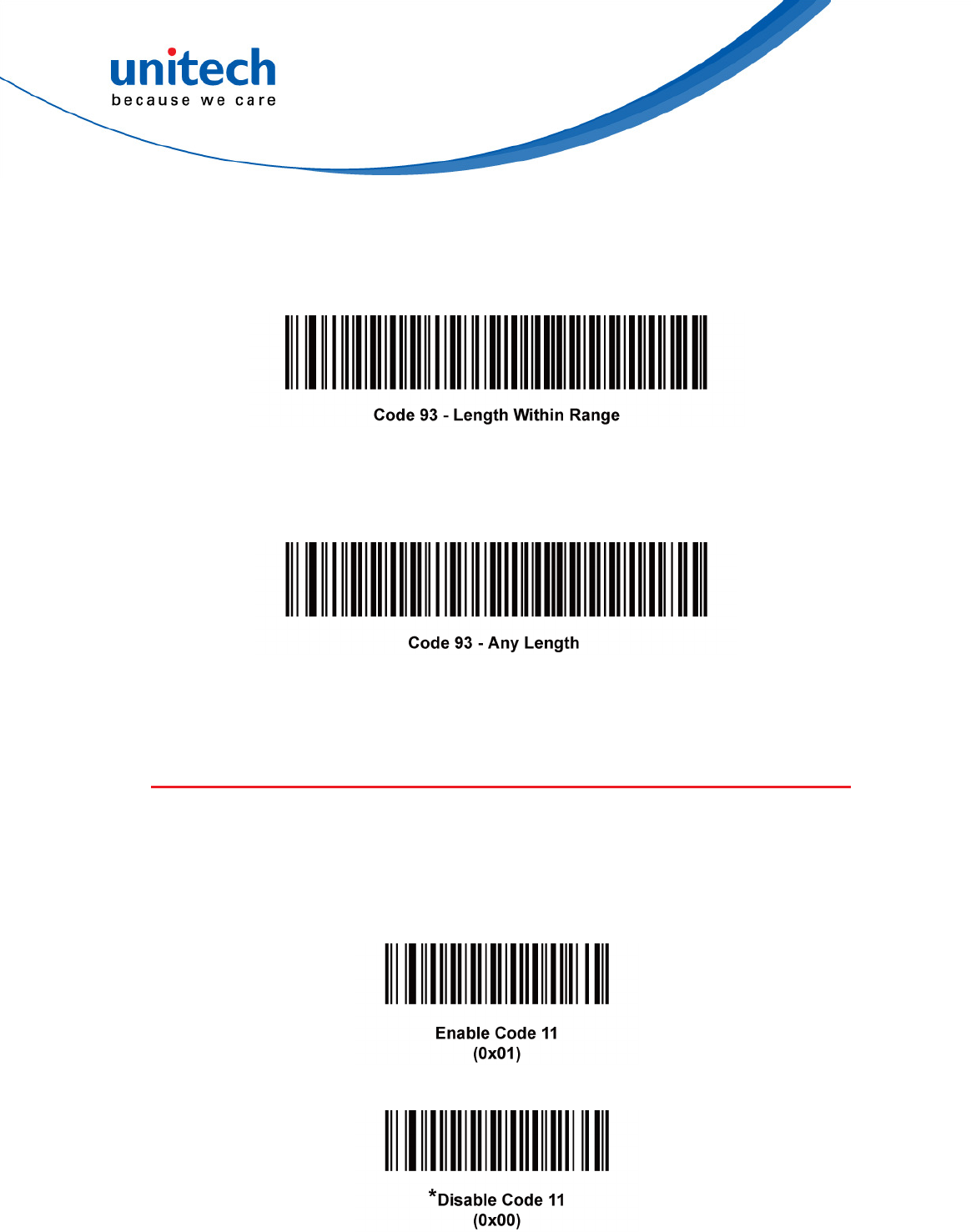
-
54
-
Numeric bar codes begin on page 77. To change the selection or cancel an
incorrect entry, scan Cancel on page 78.
Any Length - Scan this option to decode Code 93 symbols containing any
number of characters.
Code 11
Enable/Disable Code 11
Parameter # 0x0A
To enable or disable Code 11, scan the appropriate bar code below.
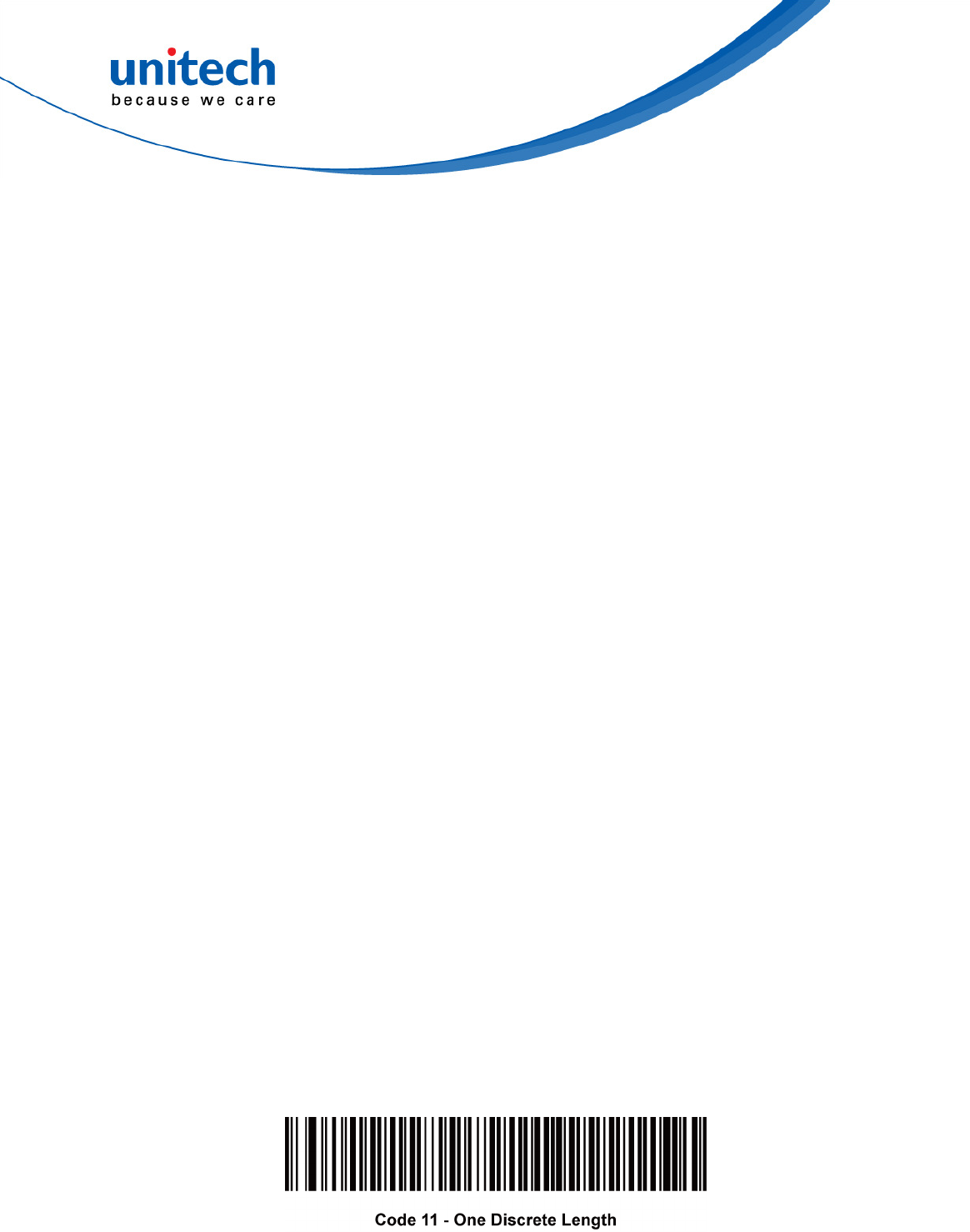
-
55
-
Set Lengths for Code 11
Parameter # L1 = 0x1C, L2 = 0x1D
The length of a code refers to the number of characters (i.e., human readable
characters), including check digit(s) the code contains. Set lengths for Code 11
to any length, one or two discrete lengths, or lengths within a specific range.
• One Discrete Length - Select this option to decode only Code 11
symbols containing a selected length. Select the length using the
numeric bar codes beginning on page 77. For example, to decode
only Code 11 symbols with 14 characters, scan Code 11 - One
Discrete Length, then scan 1 followed by 4. To correct an error or to
change the selection, scan Cancel on page 78.
• Two Discrete Lengths - Select this option to decode only Code 11
symbols containing either of two selected lengths. Select lengths
using the numeric bar codes beginning on page 77. For example, to
decode only those Code 11 symbols containing either 2 or 14
characters, select Code 11 - Two Discrete Lengths, then scan 0, 2,
1, and then 4. To correct an error or to change the selection, scan
Cancel on page 78.
• Length Within Range - Select this option to decode a Code 11
symbol with a specific length range. Select lengths using numeric bar
codes beginning on page 77. For example, to decode Code 11
symbols containing between 4 and 12 characters, first scan Code 11
- Length Within Range. Then scan 0, 4, 1, and 2 (single digit
numbers must always be preceded by a leading zero). To correct an
error or change the selection, scan Cancel on page 78.
• Any Length - Scan this option to decode Code 11 symbols containing
any number of characters within the scan engine capability.
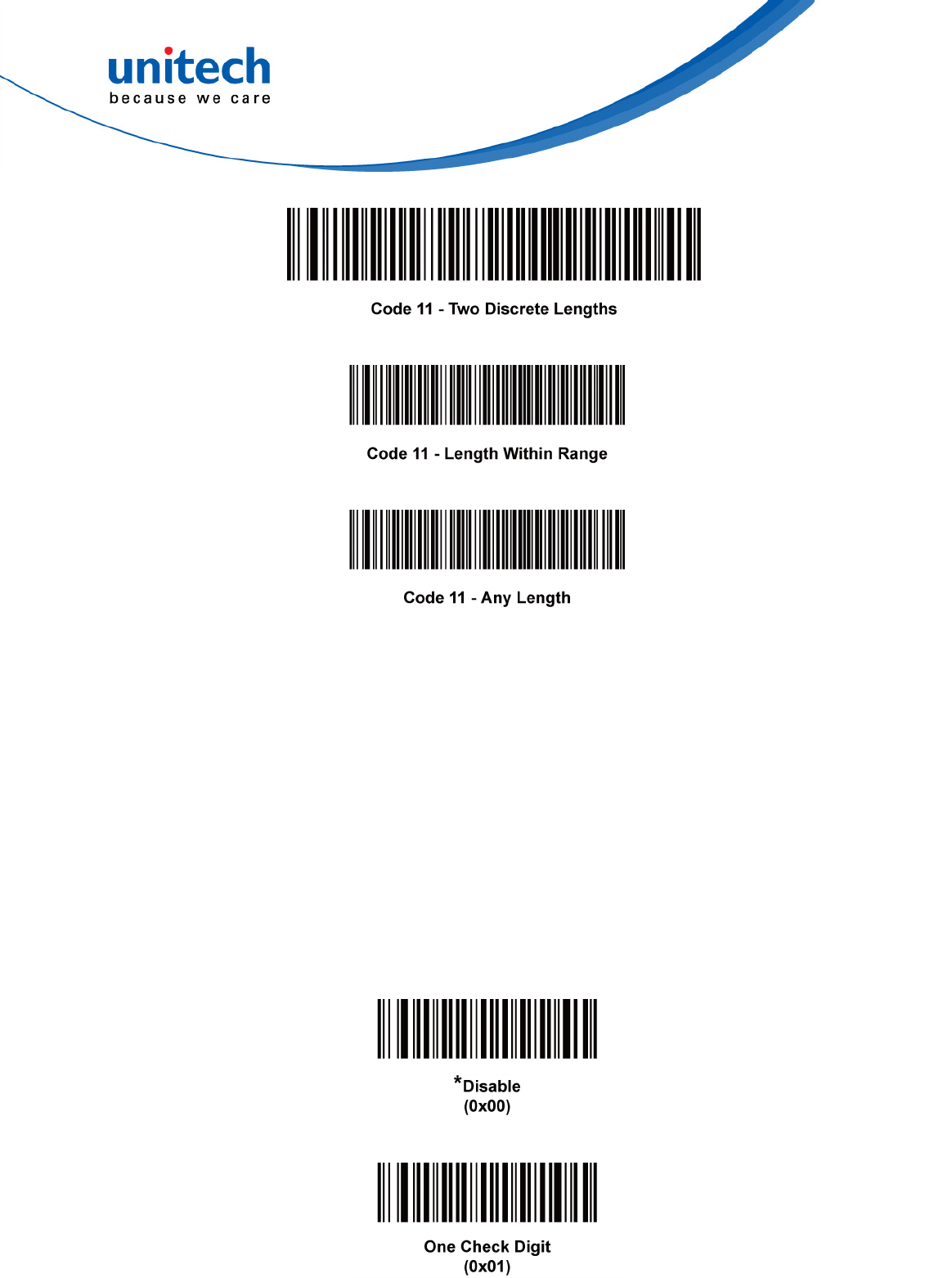
-
56
-
Code 11 Check Digit Verification
Parameter # 0x34
This feature allows the scan engine to check the integrity of all Code 11
symbols to verify that the data complies with the specified check digit algorithm.
This selects the check digit mechanism for the decoded Code 11 bar code. The
options are to check for one check digit, check for two check digits, or disable
the feature.
To enable this feature, scan the bar code below corresponding to the number
of check digits encoded in your Code 11 symbols.
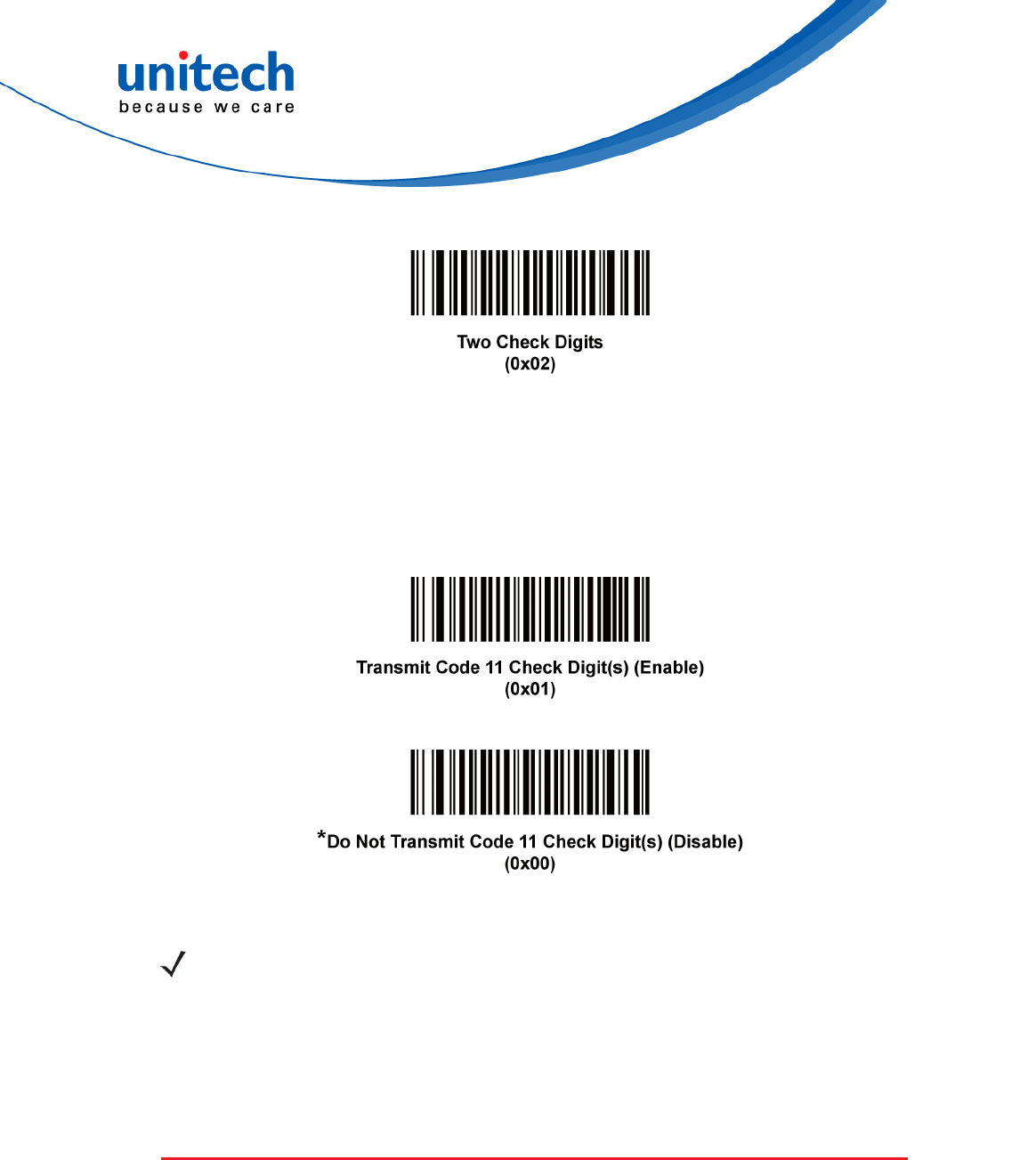
-
57
-
Transmit Code 11 Check Digits
Parameter # 0x2F
This feature selects whether or not to transmit the Code 11 check digit(s).
NOTE
Code 11 Check Digit Verification must be enabled for this parameter to
function.
Interleaved 2 of 5
Enable/Disable Interleaved 2 of 5
Parameter # 0x06
To enable or disable Interleaved 2 of 5, scan the appropriate bar code below.
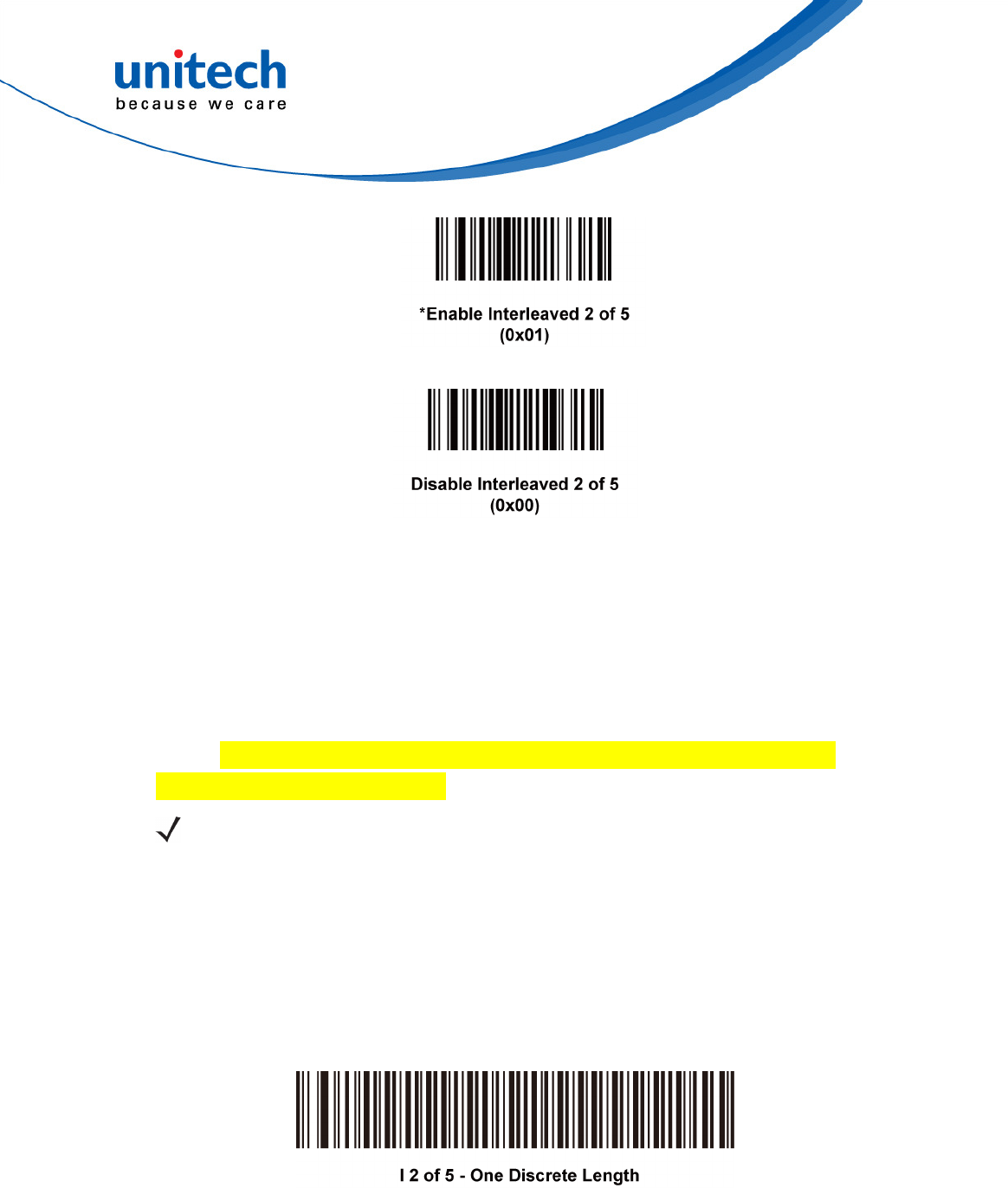
-
58
-
Set Lengths for Interleaved 2 of 5
Parameter # L1 = 0x16, L2 = 0x17
The length of a code refers to the number of characters (i.e., human readable
characters), including check digit(s) the code contains. Lengths for I 2 of 5 may
be set for any length, one or two discrete lengths, or lengths within a specific
range. To set lengths via serial commands, see Setting Code Lengths Via
Serial Commands on page B-8.
NOTE
When setting lengths, single digit numbers must always be preceded by a
leading zero.
One Discrete Length - Select this option to decode only those codes
containing a selected length. For example, select I 2 of 5 One Discrete
Length, then scan 1, 4, to decode only I 2 of 5 symbols containing 14
characters. Numeric bar codes begin on page 77. To change the selection or
cancel an incorrect entry, scan Cancel on page 78.
Two Discrete Lengths - Select this option to decode only those codes
containing two selected lengths. For example, select I 2 of 5 Two Discrete
Lengths, then scan 0, 6, 1, 4, to decode only I 2 of 5 symbols containing 6 or
14 characters. Numeric bar codes begin on page 77. To change the selection
or cancel an incorrect entry, scan Cancel on page 78.
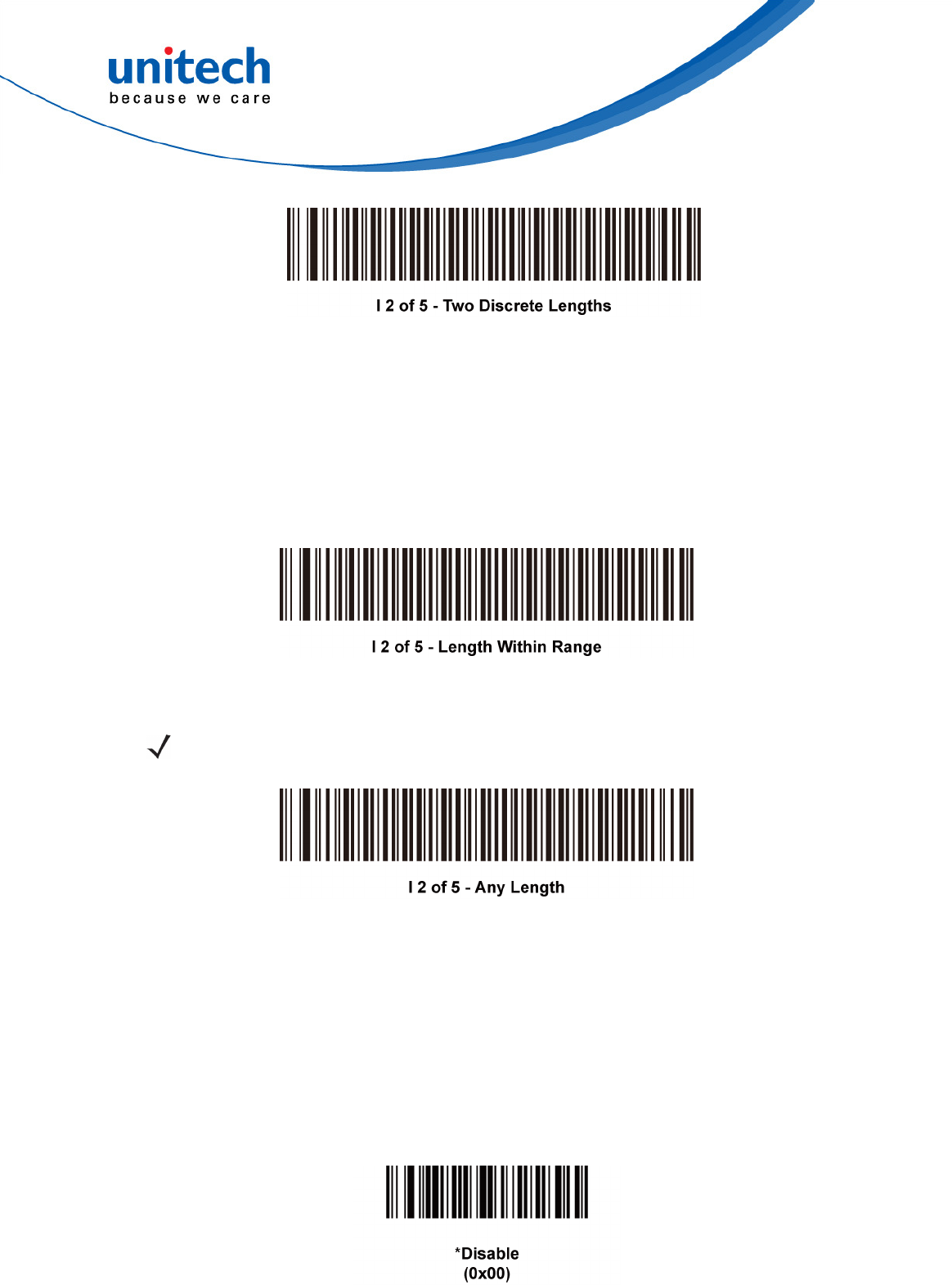
-
59
-
Length Within Range - Select this option to decode only codes within a
specified range. For example, to decode I 2 of 5 symbols containing between 4
and 12 characters, first scan I 2 of 5 Length Within Range, then scan 0, 4, 1
and 2 (single digit numbers must always be preceded by a leading zero).
Numeric bar codes begin on page 77. To change the selection or cancel an
incorrect entry, scan Cancel on page 78.
Any Length - Scan this option to decode I 2 of 5 symbols containing any
number of characters.
NOTE
Selecting this option may lead to misdecodes for I 2 of 5 codes.
I 2 of 5 Check Digit Verification
Parameter # 0x31
When enabled, this parameter checks the integrity of an I 2 of 5 symbol to
ensure it complies with a specified algorithm, either USS (Uniform Symbology
Specification), or OPCC (Optical Product Code Council).
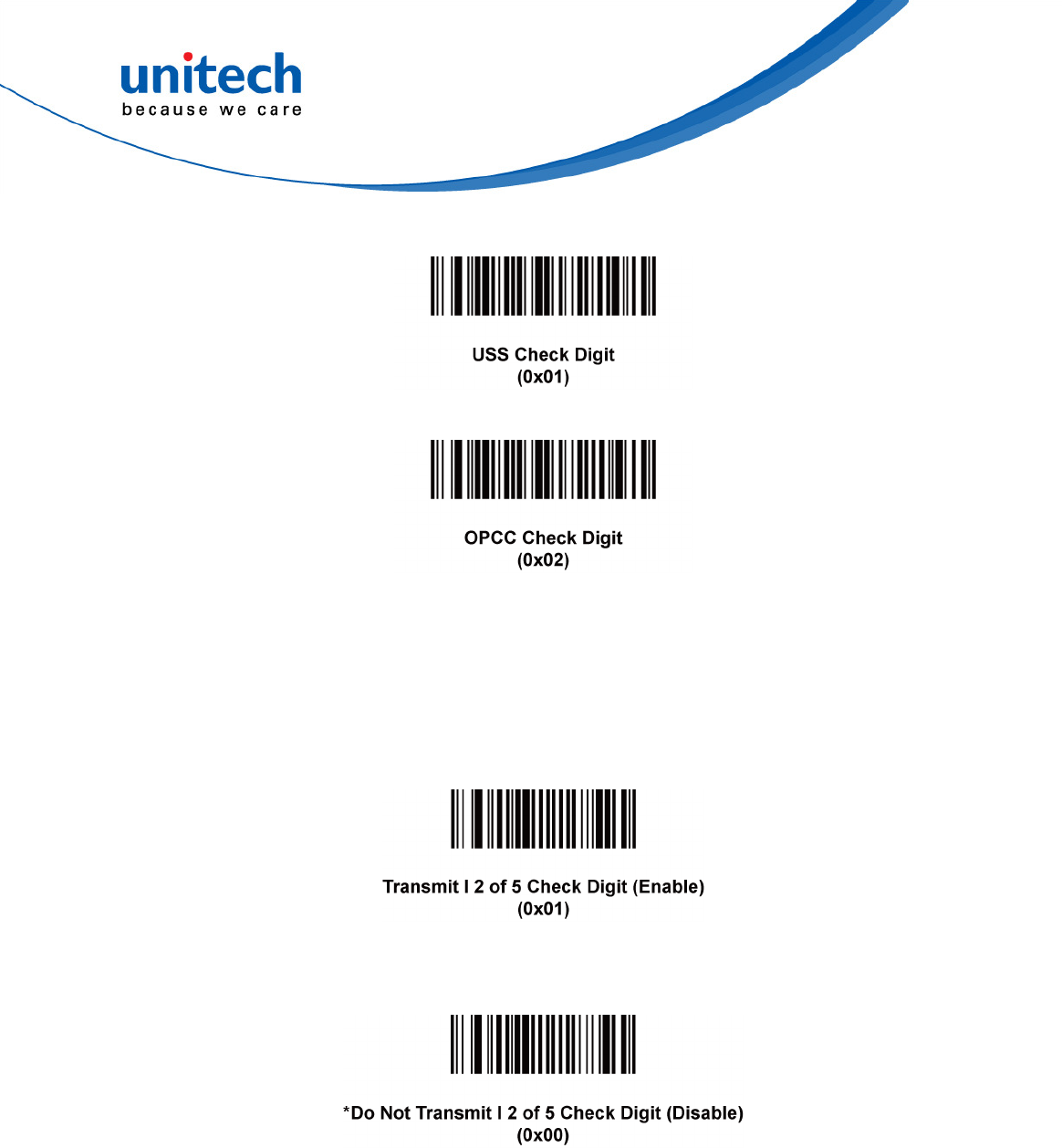
-
60
-
Transmit I 2 of 5 Check Digit
Parameter # 0x2C
Scan this symbol to transmit the check digit with the data.
Scan this symbol to transmit data without the check digit.
Convert I 2 of 5 to EAN-13
Parameter # 0x52
This parameter converts a 14 character I 2 of 5 code into EAN-13, and
transmits to the host as EAN-13. To accomplish this, I 2 of 5 must be enabled,
one length must be set to 14, and the code must have a leading zero and a
valid EAN-13 check digit.
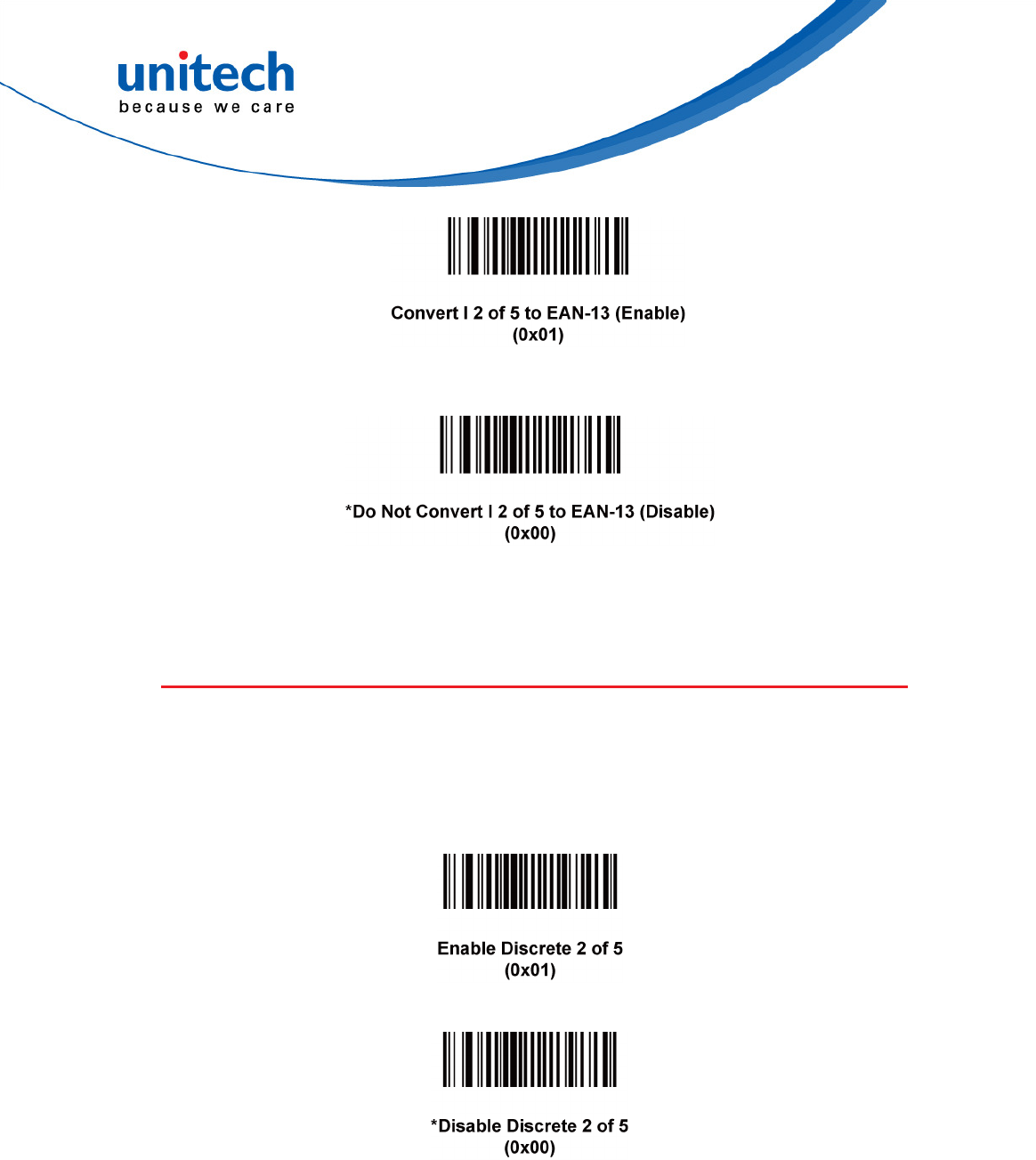
-
61
-
Discrete 2 of 5
Enable/Disable Discrete 2 of 5
Parameter # 0x05
To enable or disable Discrete 2 of 5, scan the appropriate bar code below.
Set Lengths for Discrete 2 of 5
Parameter # L1 = 0x14, L2 = 0x15
The length of a code refers to the number of characters (i.e., human readable
characters), including check digit(s) the code contains. Lengths for D 2 of 5
may be set for any length, one or two discrete lengths, or lengths within a
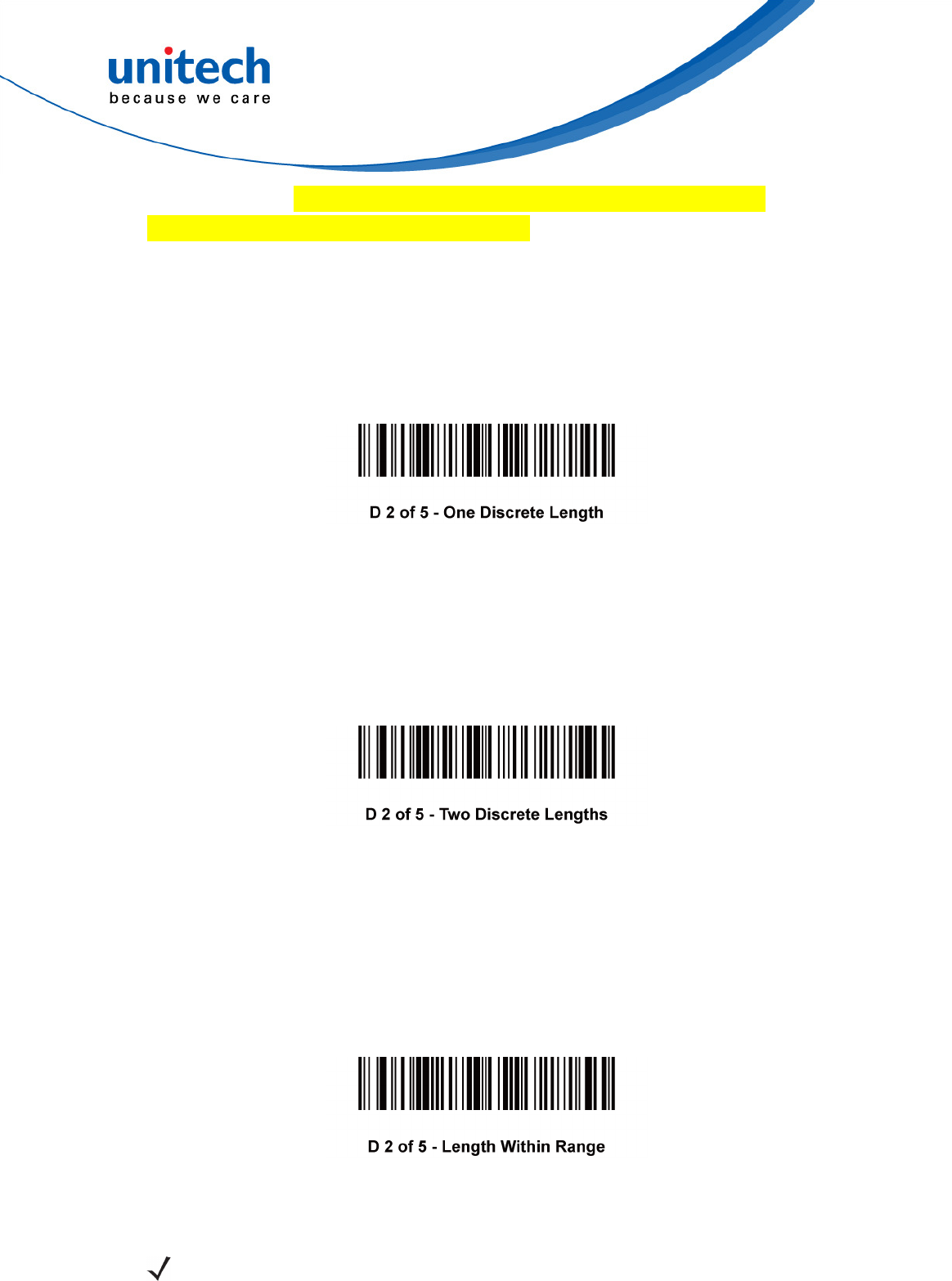
-
62
-
specific range. To set lengths via serial commands, see Setting Code
Lengths Via Serial Commands on page B-6.
One Discrete Length - Select this option to decode only those codes
containing a selected length. For example, select D 2 of 5 One Discrete
Length, then scan 1, 4, to decode only D 2 of 5 symbols containing 14
characters. Numeric bar codes begin on page 77. To change the selection or
cancel an incorrect entry, scan Cancel on page 78.
Two Discrete Lengths - Select this option to decode only those codes
containing two selected lengths. For example, select D 2 of 5 Two Discrete
Lengths, then scan 0, 2, 1, 4, to decode only D 2 of 5 symbols containing 2 or
14 characters. Numeric bar codes begin on page 77. To change the selection
or cancel an incorrect entry, scan Cancel on page 78.
Length Within Range - Select this option to decode codes within a specified
range. For example, to decode D 2 of 5 symbols containing between 4 and 12
characters, first scan D 2 of 5 Length Within Range, then scan 0, 4, 1 and 2
(single digit numbers must be preceded by a leading zero). Numeric bar codes
begin on page 77. To change the selection or cancel an incorrect entry, scan
Cancel on page 78.
Any Length - Scan this option to decode D 2 of 5 symbols containing any
number of characters.
NOTE
Selecting this option may lead to misdecodes for D 2 of 5 codes.
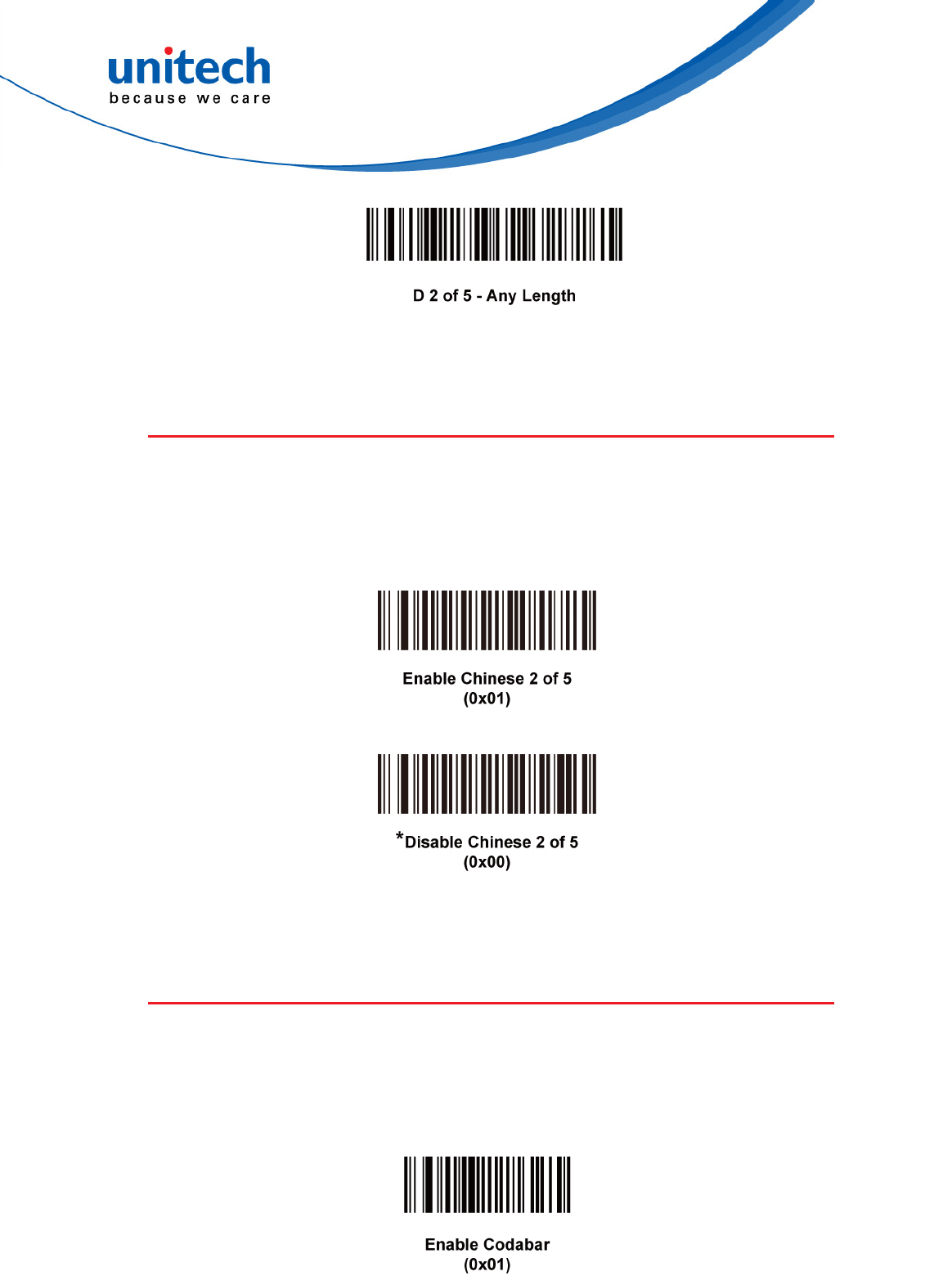
-
63
-
Chinese 2 of 5
Enable/Disable Chinese 2 of 5
Parameter # 0xF0 0x98
To enable or disable Chinese 2 of 5, scan the appropriate bar code below.
Codabar
Enable/Disable Codabar
Parameter # 0x07
To enable or disable Codabar, scan the appropriate bar code below.
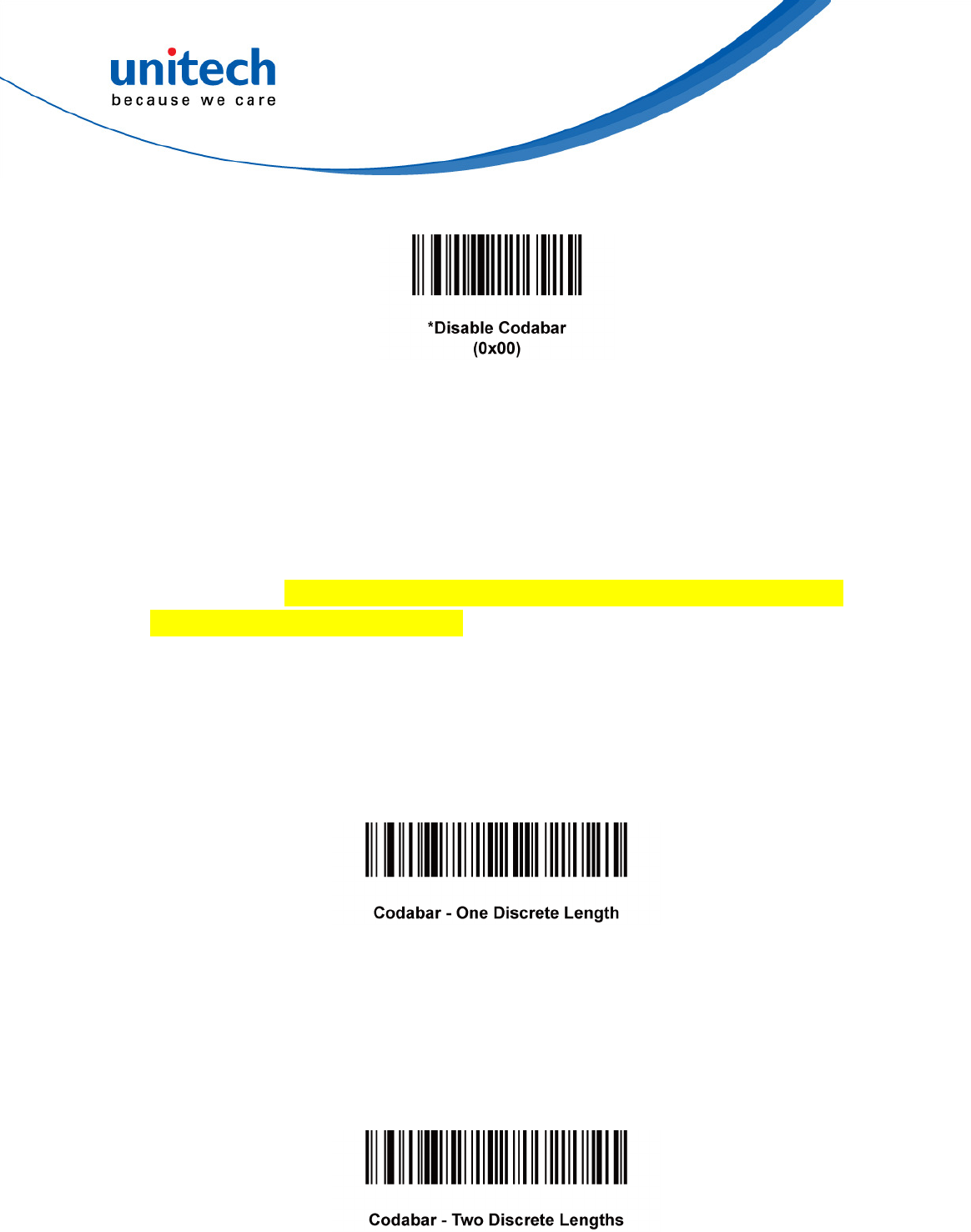
-
64
-
Set Lengths for Codabar
Parameter # L1 = 0x18, L2 = 0x19
The length of a code refers to the number of characters (i.e., human readable
characters), including check digit(s) the code contains. Lengths for Codabar
may be set for any length, one or two discrete lengths, or lengths within a
specific range. To set lengths via serial commands, see Setting Code Lengths
Via Serial Commands on page B-6.
One Discrete Length - Select this option to decode only those codes
containing a selected length. For example, select Codabar One Discrete
Length, then scan 1, 4, to decode only Codabar symbols containing 14
characters. Numeric bar codes begin on page 77. To change the selection or
cancel an incorrect entry, scan Cancel on page 78.
Two Discrete Lengths - This option sets the unit to decode only those codes
containing two selected lengths. For example, select Codabar Two Discrete
Lengths, then scan 0, 2, 1, 4, to decode only Codabar symbols containing 6 or
14 characters. Numeric bar codes begin on page 77. To change the selection
or cancel an incorrect entry, scan Cancel on page 78.
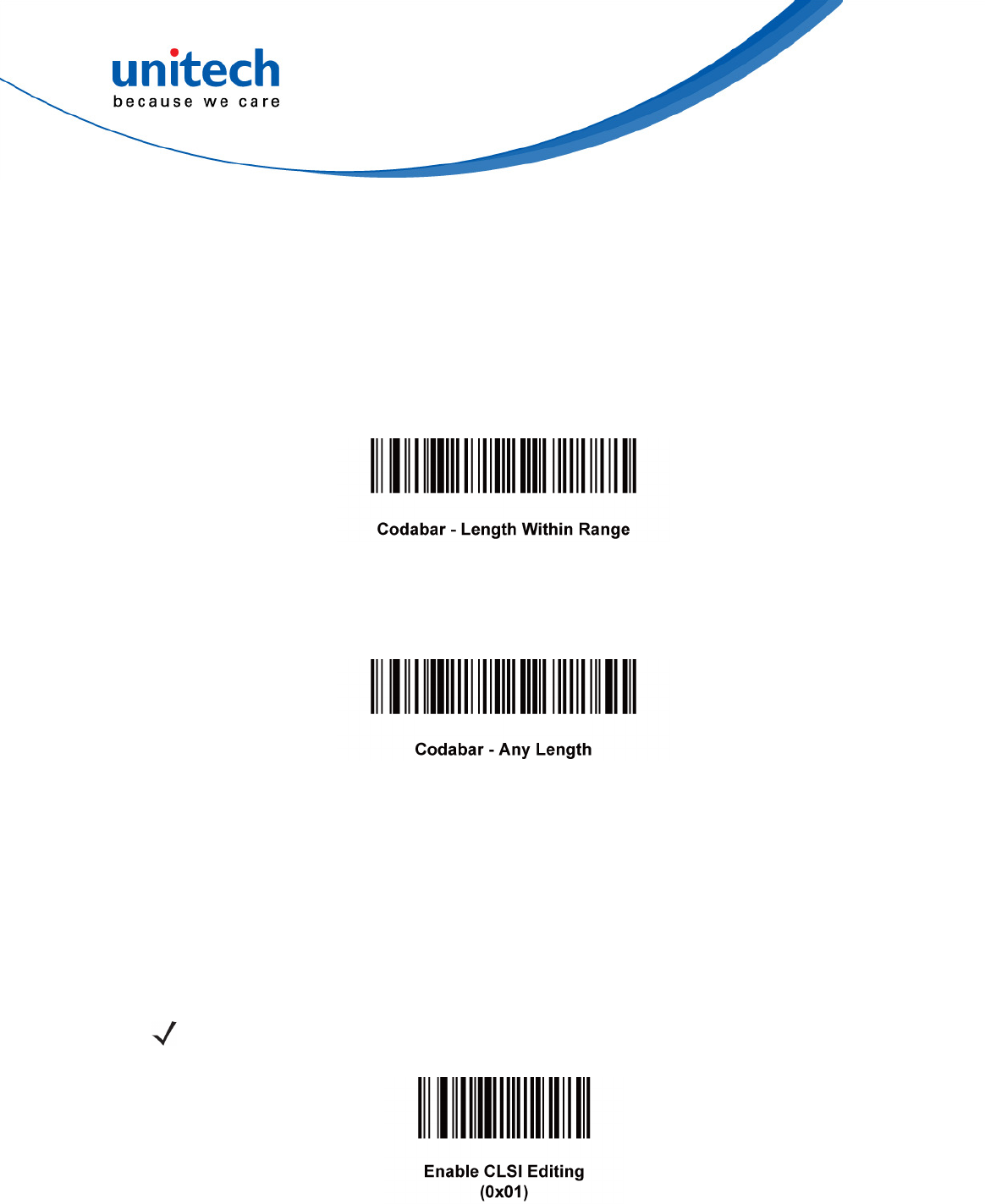
-
65
-
Length Within Range - Select this option to decode a code within a specified
range. For example, to decode Codabar symbols containing between 4 and 12
characters, first scan Codabar Length Within Range, then scan 0, 4, 1 and 2
(single digit numbers must always be preceded by a leading zero). Numeric
bar codes begin on page 77. To change the selection or cancel an incorrect
entry, scan Cancel on page 78.
Any Length - Scan this option to decode Codabar symbols containing any
number of characters.
CLSI Editing
Parameter # 0x36
When enabled, this parameter strips the start and stop characters and inserts a
space after the first, fifth, and tenth characters of a 14-character Codabar
symbol.
NOTE
Symbol length does not include start and stop characters.
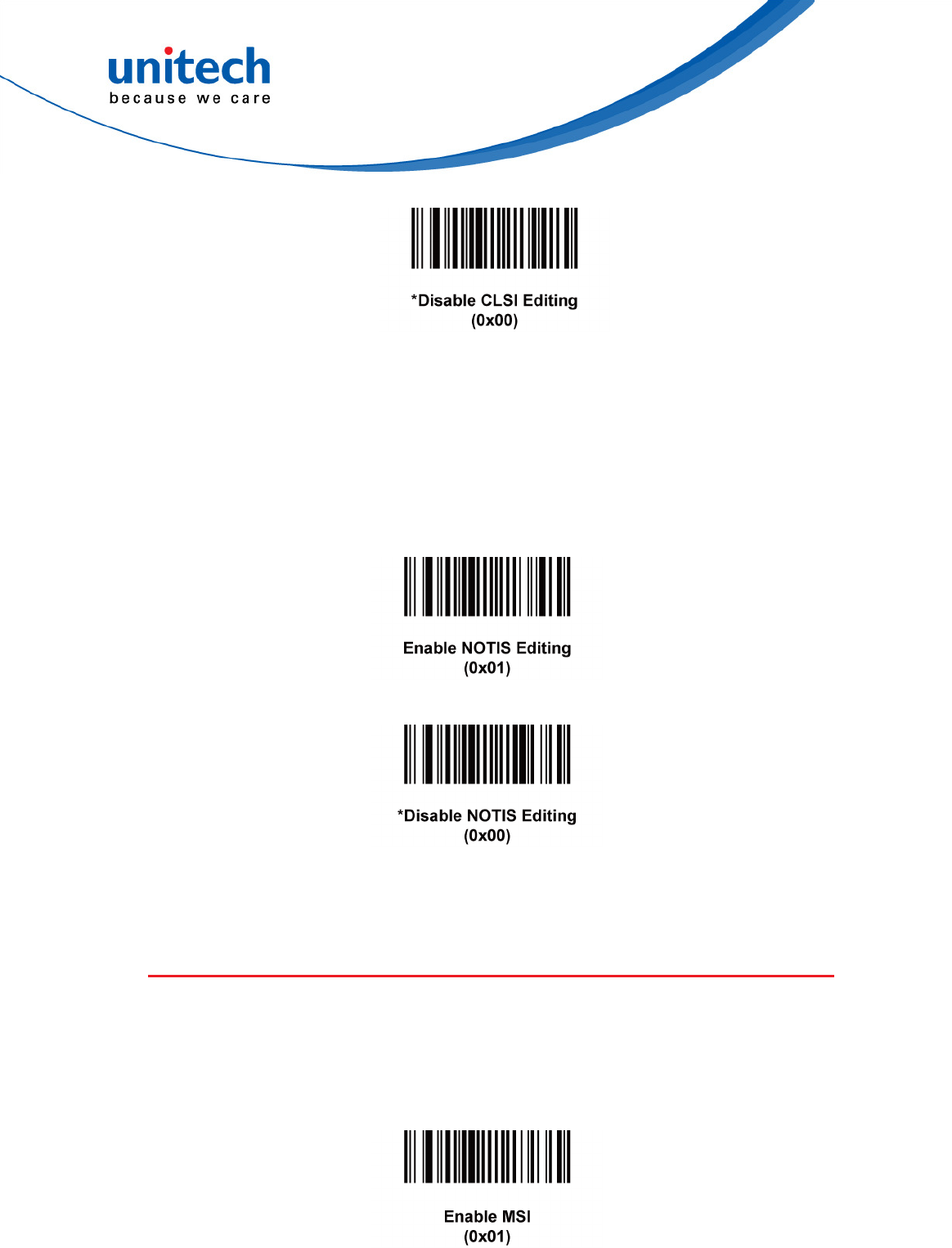
-
66
-
NOTIS Editing
Parameter # 0x37
When enabled, this parameter strips the start and stop characters from
decoded Codabar symbol.
MSI
Enable/Disable MSI
Parameter # 0x0B
To enable or disable MSI, scan the appropriate bar code below.
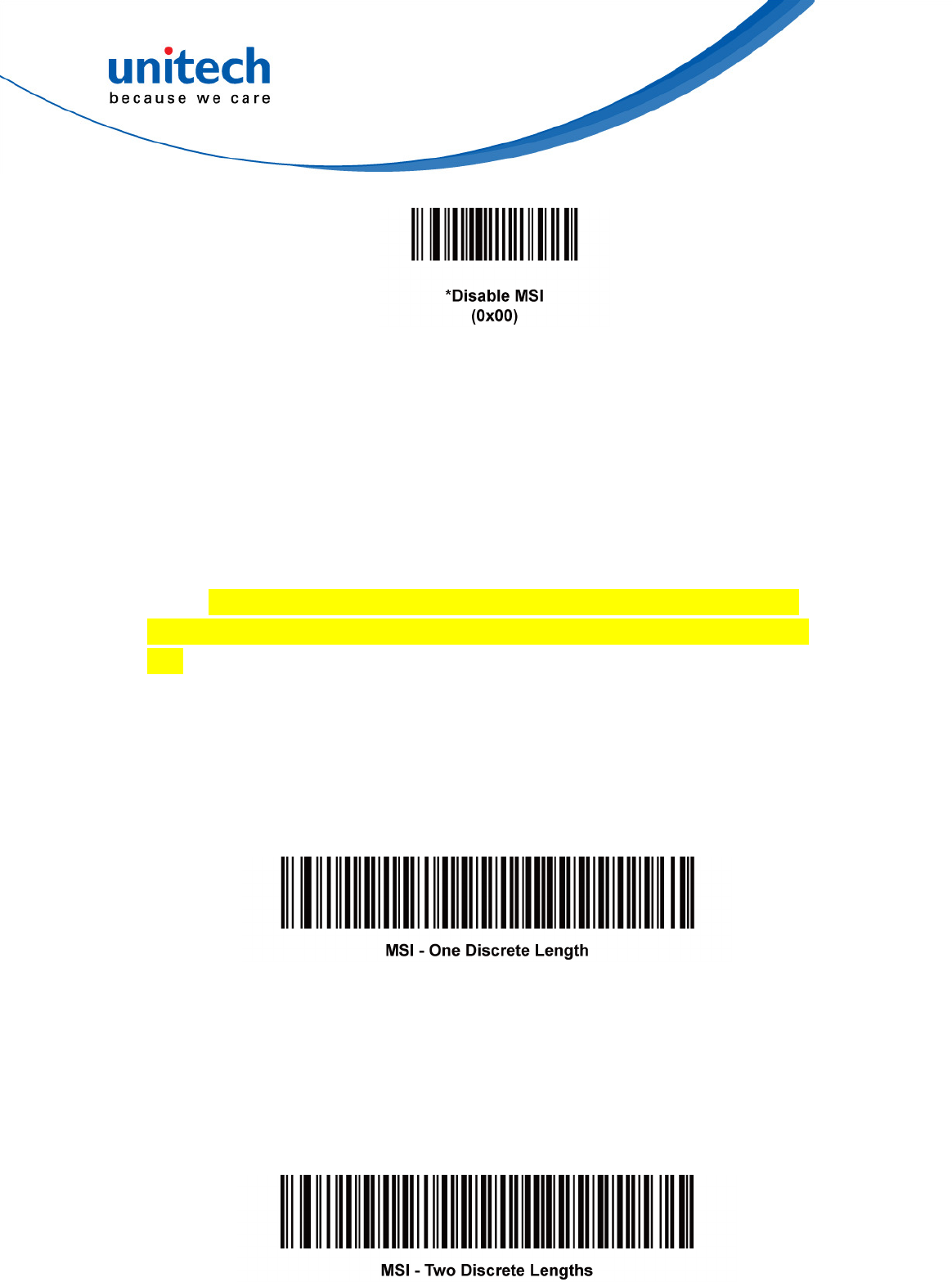
-
67
-
Set Lengths for MSI
Parameter # L1 = 0x1E, L2 = 0x1FT
The length of a code refers to the number of characters (i.e., human readable
characters) the code contains, and includes check digits. Lengths for MSI can
be set for any length, one or two discrete lengths, or lengths within a specific
range. See Table B-5 on page B-9 for ASCII equivalents. To set lengths via
serial commands, see Setting Code Lengths Via Serial Commands on page
B-6.
One Discrete Length - Select this option to decode only those codes
containing a selected length. For example, select MSI Plessey One Discrete
Length, then scan 1, 4, to decode only MSI Plessey symbols containing 14
characters. Numeric bar codes begin on page 77. To change the selection or
cancel an incorrect entry, scan Cancel on page 78.
Two Discrete Lengths - Select this option to decode only those codes
containing two selected lengths. For example, select MSI Plessey Two
Discrete Lengths, then scan 0, 6, 1, 4, to decode only MSI Plessey symbols
containing 6 or 14 characters. Numeric bar codes begin on page 77. To change
the selection or cancel an incorrect entry, scan Cancel on page 78.
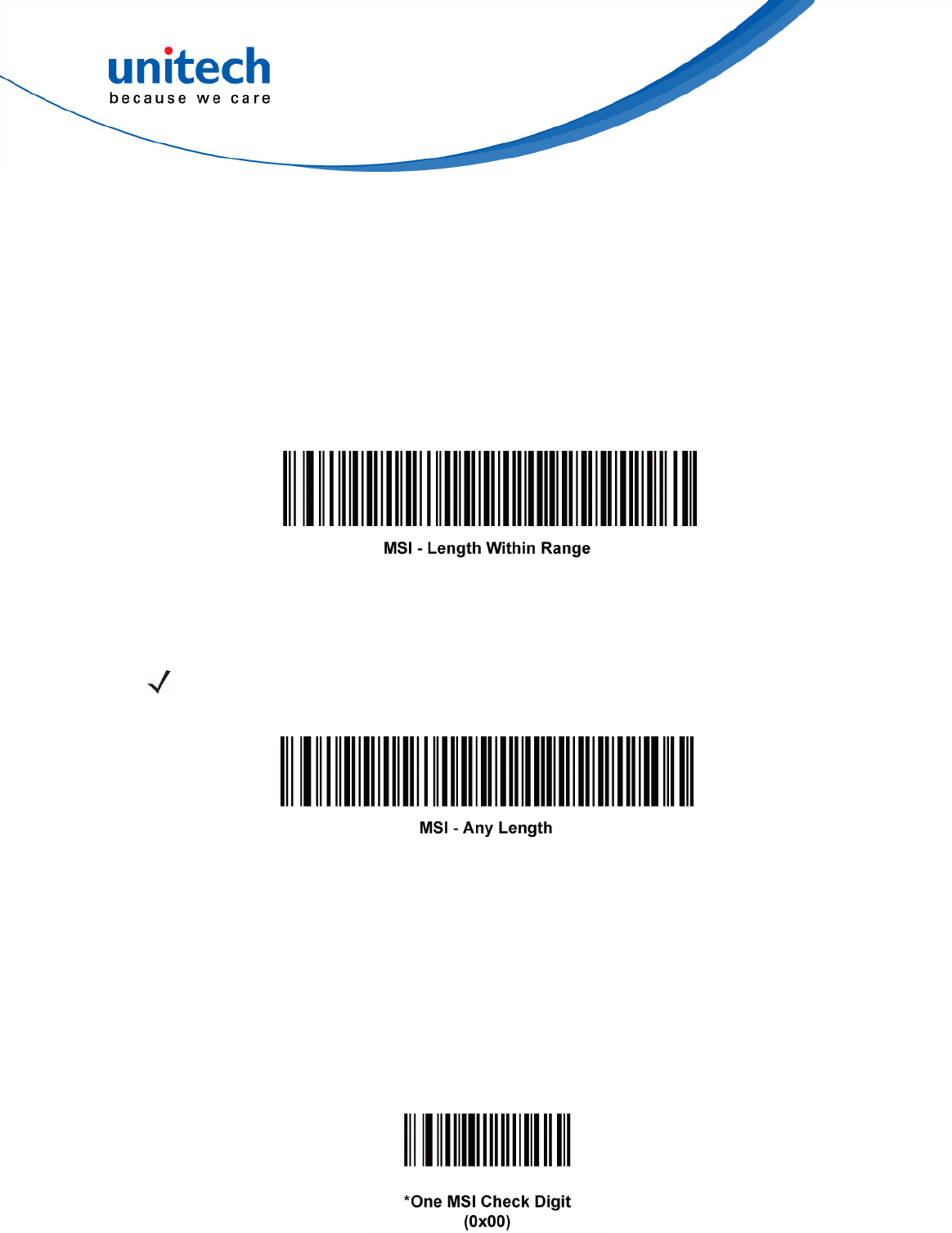
-
68
-
Length Within Range - Select this option to decode codes within a specified
range. For example, to decode MSI symbols containing between 4 and 12
characters, first scan MSI Length Within Range, then scan 0, 4, 1 and 2
(single digit numbers must always be preceded by a leading zero). Numeric
bar codes begin on page 77. To change the selection or cancel an incorrect
entry, scan Cancel on page 78.
Any Length - Scan this option to decode MSI Plessey symbols containing any
number of characters.
NOTE
Selecting this option may lead to misdecodes for MSI codes.
MSI Check Digits
Parameter # 0x32
These check digits at the end of the bar code verify the integrity of the data. At
least one check digit is always required. Check digits are not automatically
transmitted with the data.
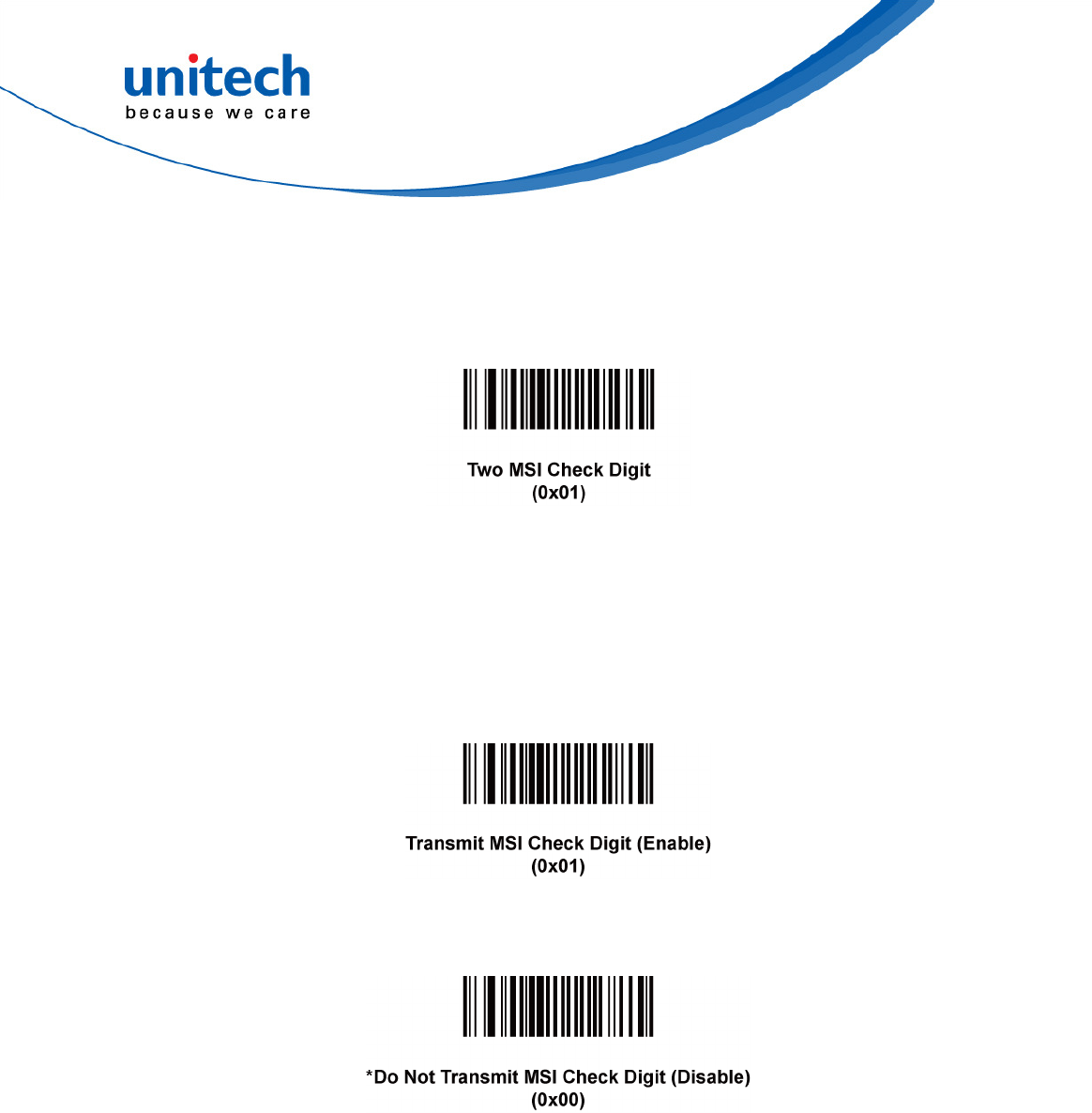
-
69
-
If two check digits are selected, also select an MSI Check Digit Algorithm on
page 70.
Transmit MSI Check Digit
Parameter # 0x2E
Scan this symbol to transmit the check digit with the data.
Scan this symbol to transmit data without the check digit.
MSI Check Digit Algorithm
Parameter # 0x33
When the Two MSI check digits option is selected, an additional verification is
required to ensure integrity.
Select one of the following algorithms.
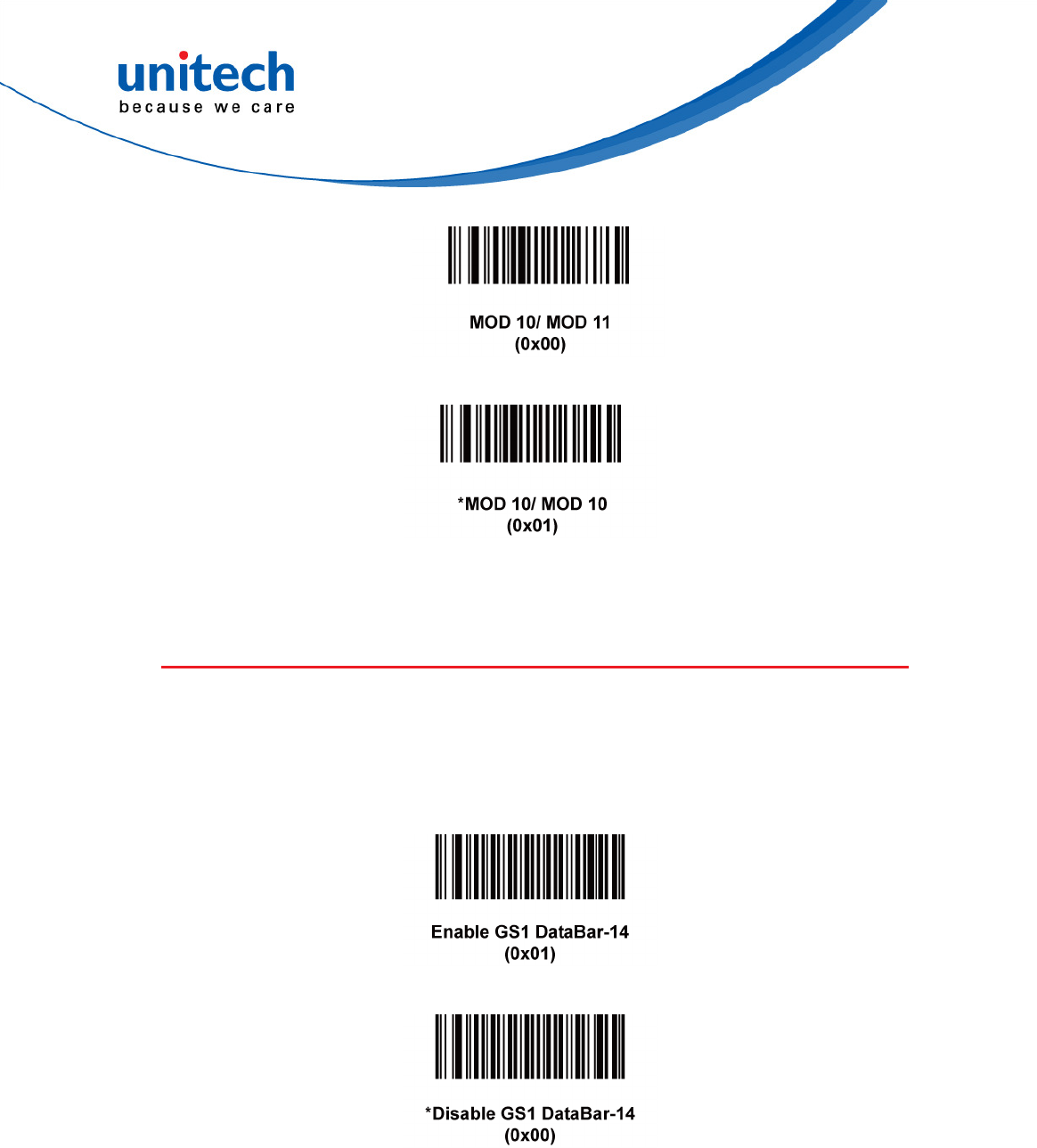
-
70
-
GS1 DataBar
Enable/Disable GS1 DataBar-14
Parameter # 0xF0 0x52
To enable or disable GS1 DataBar-14, scan the appropriate bar code below.
Enable/Disable GS1 DataBar Limited
Parameter # 0xF0 0x53
To enable or disable GS1 DataBar Limited, scan the appropriate bar code
below.
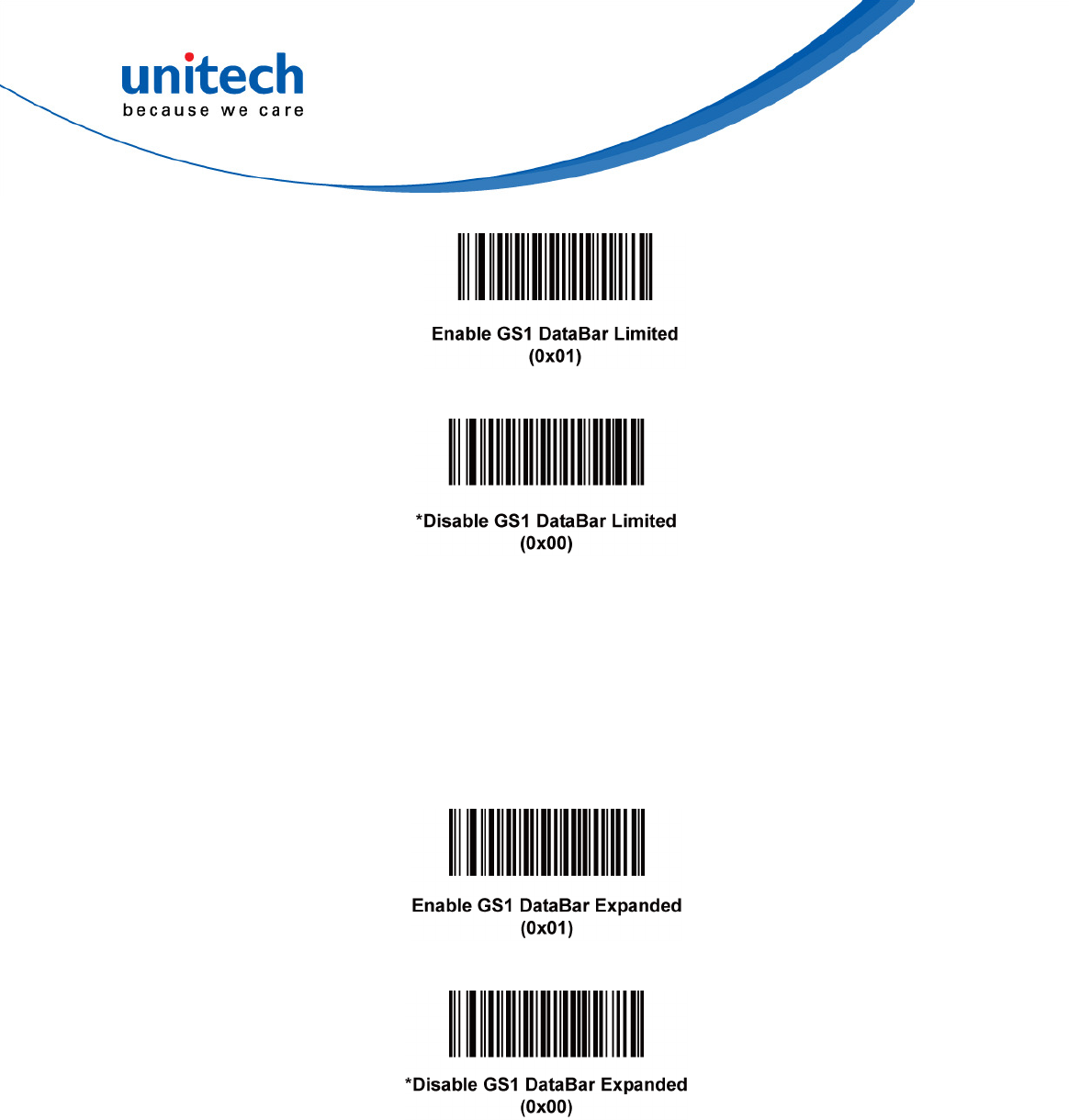
-
71
-
Enable/Disable GS1 DataBar Expanded
Parameter # 0xF0 0x54
To enable or disable GS1 DataBar Expanded, scan the appropriate bar code
below.
Convert GS1 DataBar to UPC/EAN
Parameter # 0xF0 0x8D
This parameter only applies to GS1 DataBar-14 and GS1 DataBar Limited
symbols. When this conversion is enabled, GS1 DataBar-14 and GS1 DataBar
Limited symbols encoding a single zero as the first digit have the leading '010'
stripped and the bar code reported as EAN-13.
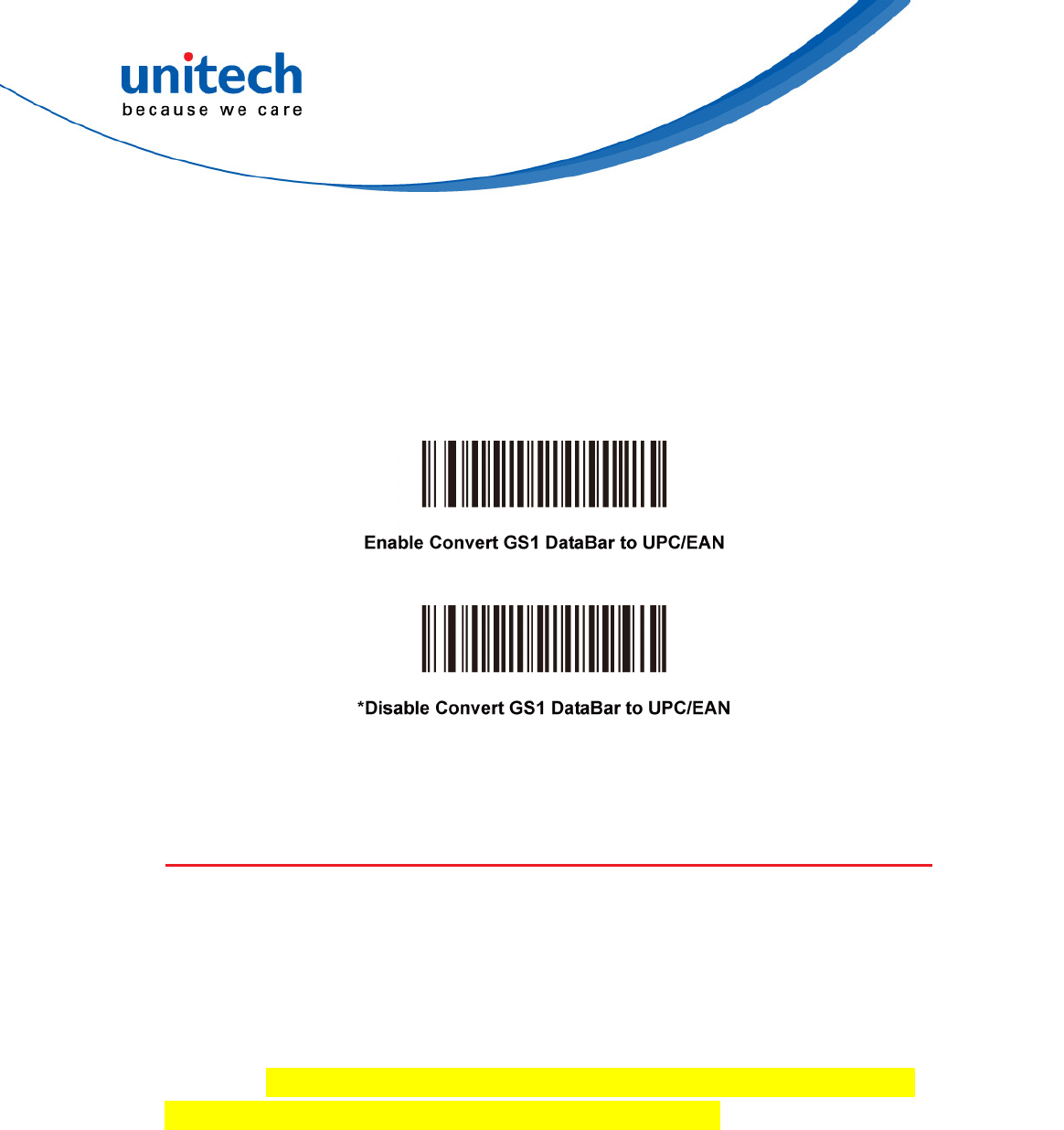
-
72
-
Bar codes beginning with two or more zeros but not six zeros have the leading
'0100' stripped and the bar code reported as UPC-A. The UPC-A Preamble
parameter to transmit the system character and country code applies to
converted bar codes. Note that neither the system character nor the check digit
can be stripped.
Transmit Code ID Character
Parameter # 0x2D
A code ID character identifies the code type of a scanned bar code. This can
be useful when decoding more than one code type. The code ID character is
inserted between the prefix character (if selected) and the decoded symbol.
Select no code ID character, a Symbol Code ID character, or an AIM Code ID
character. The Symbol Code ID characters are listed below; see Appendix B,
Miscellaneous Code Information for AIM Code Identifiers.
• A = UPC-A, UPC-E, UPC-E1, EAN-8, EAN-13
• B = Code 39, Code 32
• C = Codabar
• D = Code 128, ISBT 128
• E = Code 93
• F = Interleaved 2 of 5
• G = Discrete 2 of 5
• J = MSI
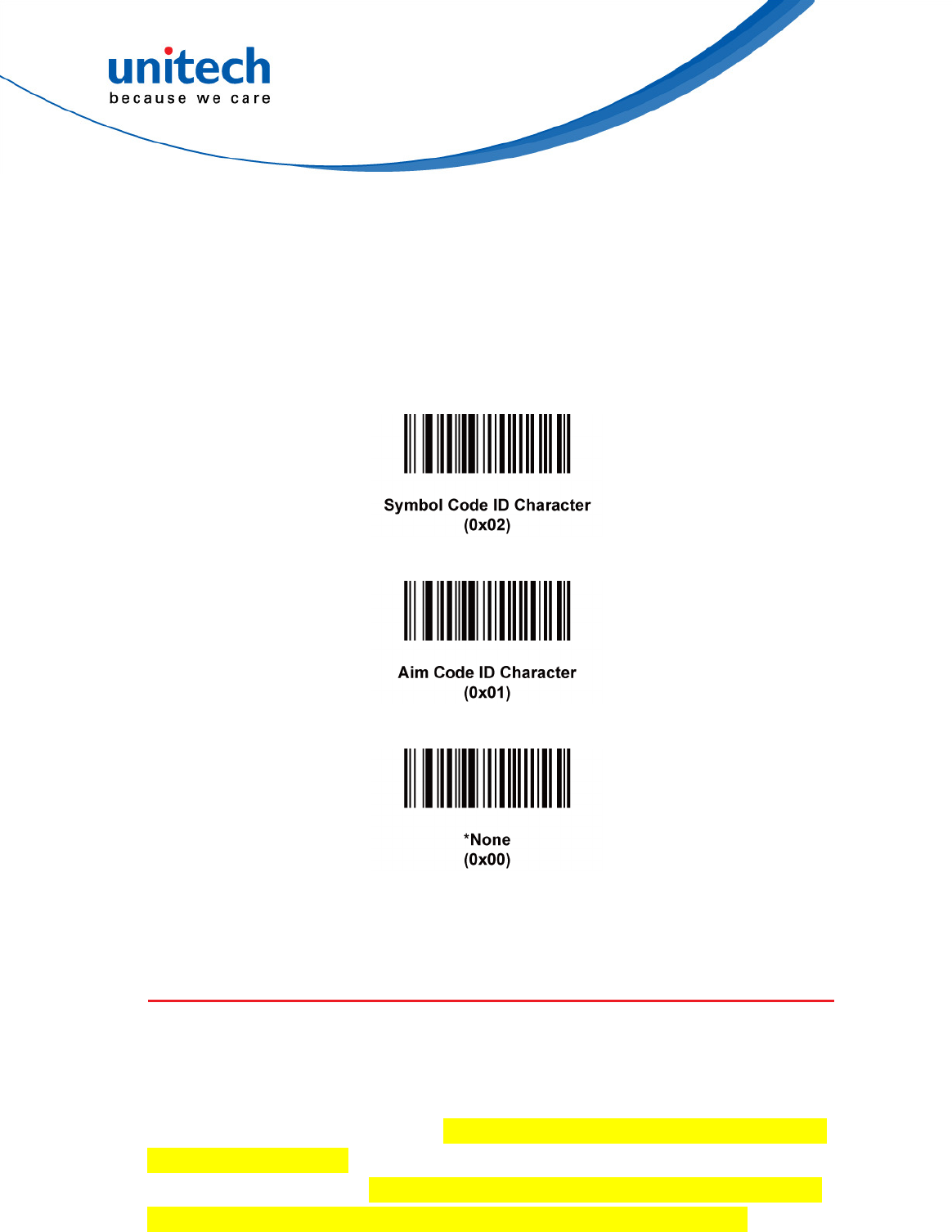
-
73
-
• K = GS1-DataBar
• L = Bookland EAN
• M = Trioptic Code 39
• N = Coupon Code
• R = GS1 DataBar-14, GS1 DataBar Limited, GS1 DataBar Expanded.
Prefix/Suffix Values
Parameter # P = 0x69, S1 = 0x68, S2 = 0x6A
A prefix and/or one or two suffixes can be appended to scan data for use in
data editing. To set these values, scan a four-digit number (i.e. four bar codes)
that corresponds to ASCII values. See the Table B-5 on page B-7 and Numeric
Bar Codes on page 77. To change the selection or cancel an incorrect entry,
scan Cancel on page 78. To set the Prefix/Suffix values via serial commands,
see Setting Prefixes and Suffixes Via Serial Commands on page B-7.
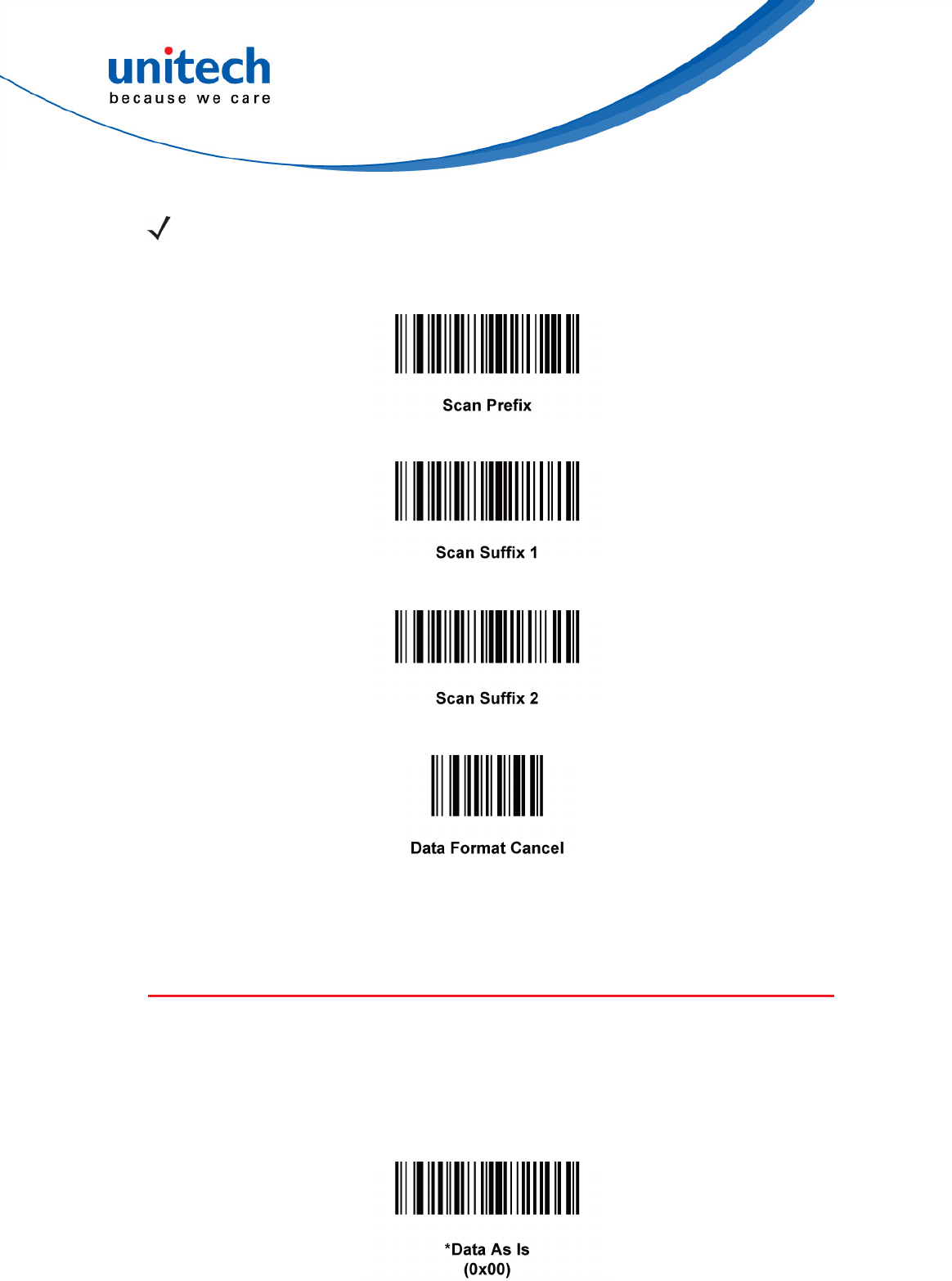
-
74
-
NOTE
In order to use Prefix/Suffix values, the Scan Data Transmission Format on
page 75 must be set. See page 75.
Scan Data Transmission Format
Parameter # 0xEB
To change the Scan Data Transmission Format, scan one of the eight bar
codes corresponding to the desired format.
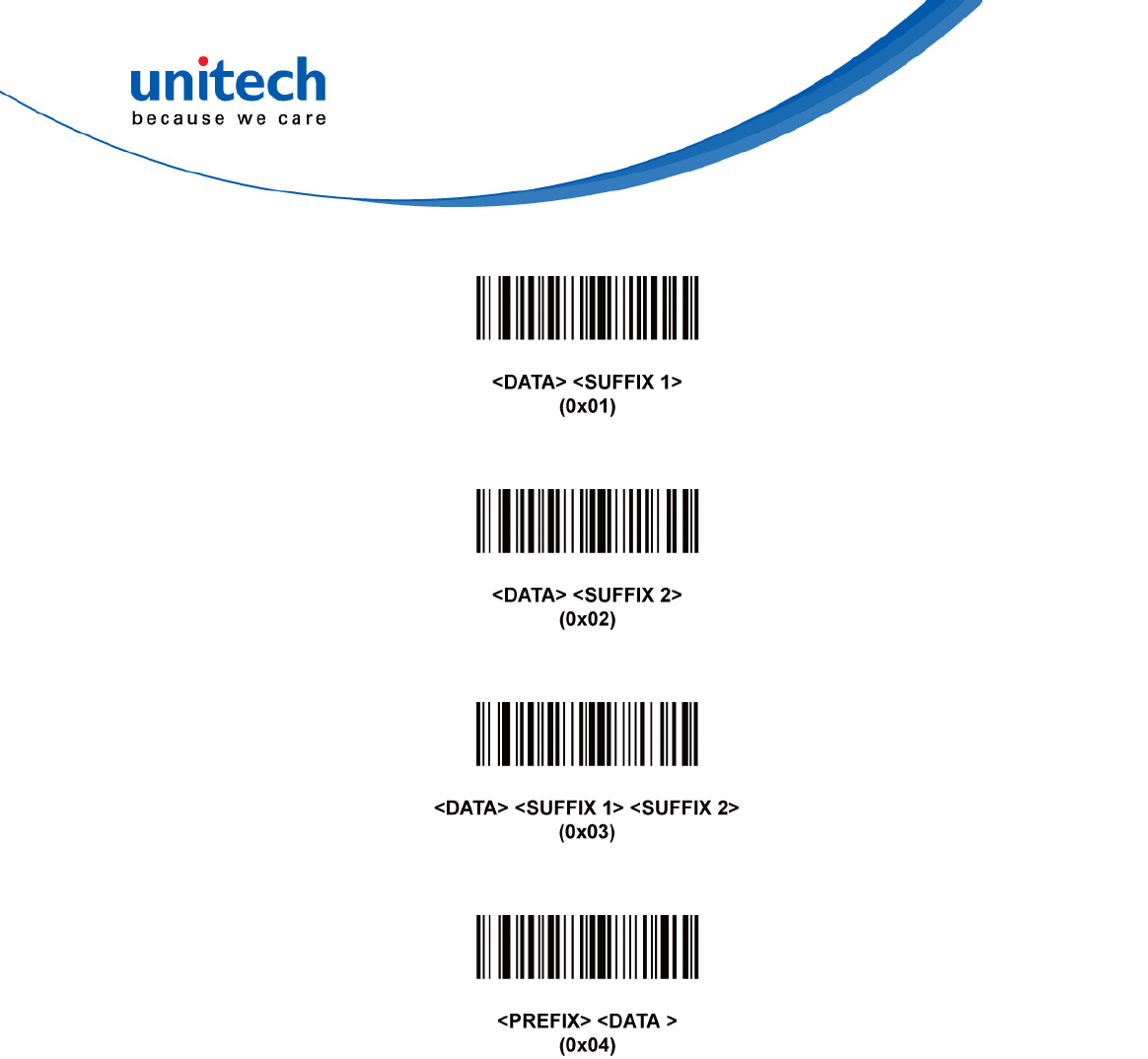
-
75
-
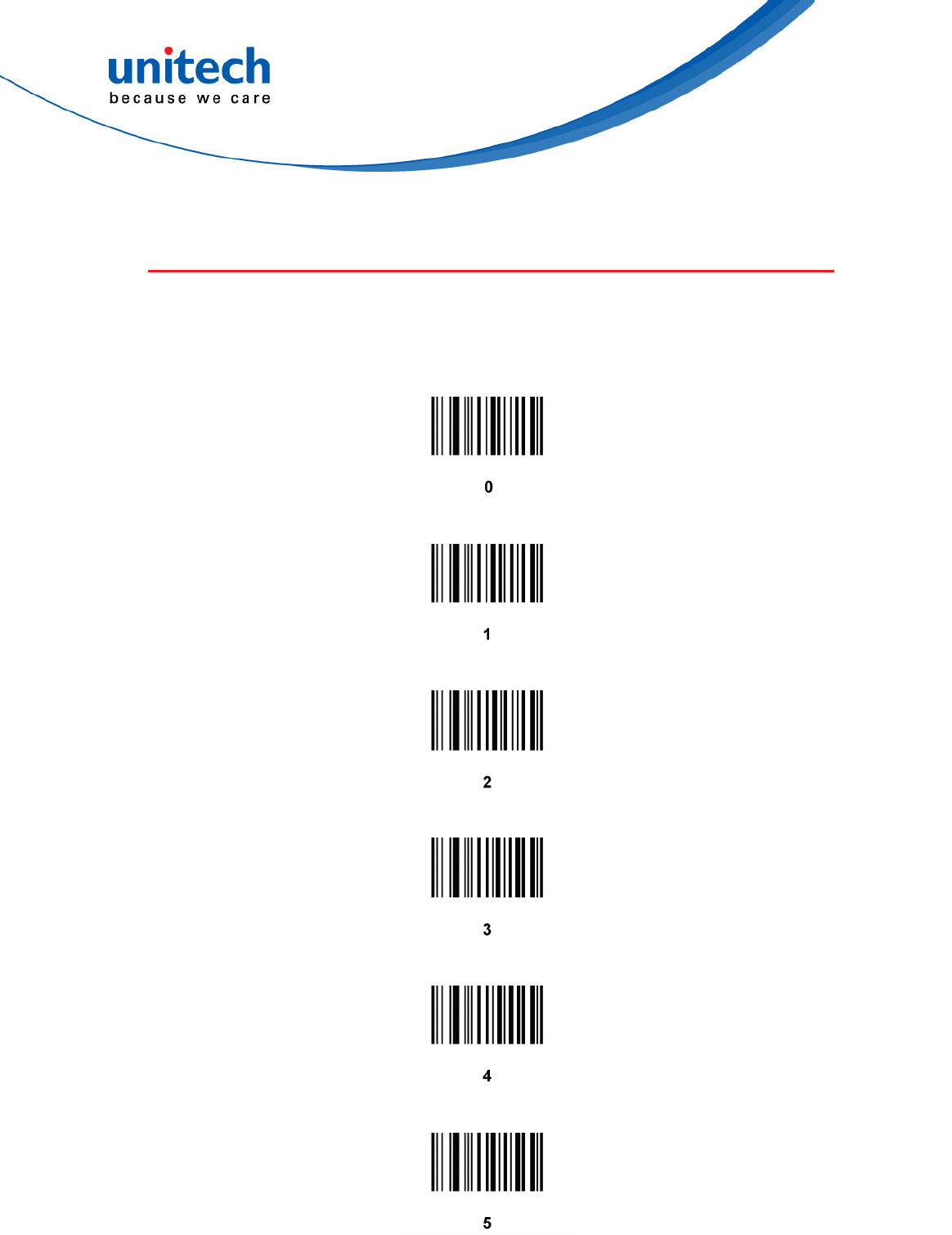
-
76
-
Numeric Bar Codes
For parameters requiring specific numeric values, scan the appropriately
numbered bar code(s).
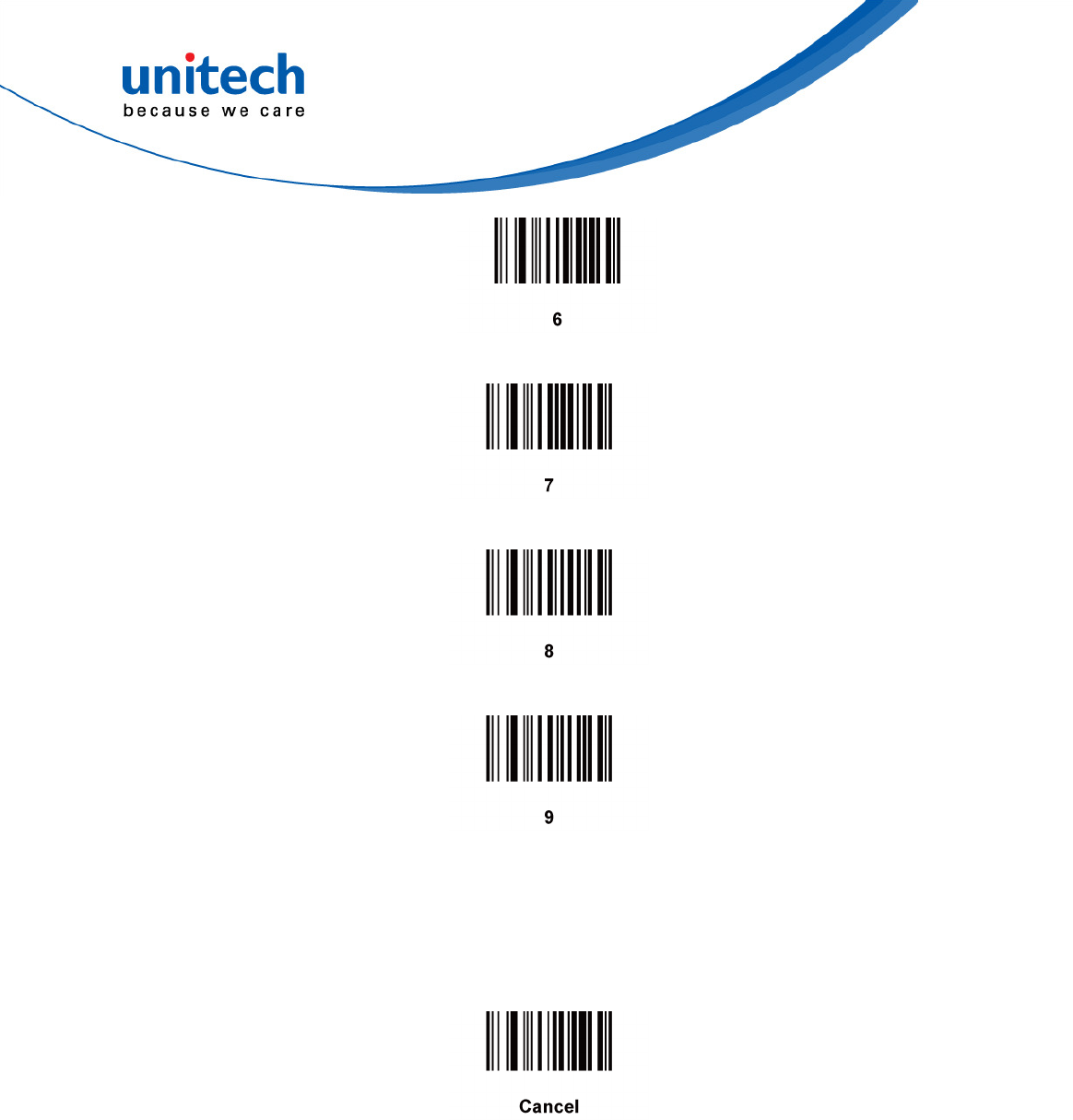
-
77
-
Cancel
To change the selection or cancel an incorrect entry, scan the bar code below.

-
78
-
Regulatory Compliance Statements
FCC Warning Statement
This equipment has been tested and found to comply with the limits for a Class
B digital device, pursuant to part 15 of the FCC rules. These limits are
designed to provide reasonable protection against harmful interference in a
residential installation. This equipment generates, uses and can radiate radio
frequency energy and, if not installed and used in accordance with the
instructions, may cause harmful interference with radio communications.
However, there is no guarantee that interference will not occur in a particular
installation. If this equipment does cause harmful interference with radio or
television reception, which can be determined by turning the equipment off and
on, the user is encouraged to try to correct the interference by one or more of
the following measures:
–Reorient or relocate the receiving antenna.
–Increase the separation between the equipment and receiver.
–Connect the equipment into an outlet on a circuit different from that to
which the receiver is connected.
–Consult the dealer or an experienced radio/TV technician for help.
1. This Transmitter must not be co-located or operating in conjunction with
any other antenna or transmitter.
2. This equipment complies with FCC RF radiation exposure limits set forth
for an uncontrolled environment. To maintain compliance with FCC RF
exposure requirements, avoid direct contact to the transmitting antenna
during transmitting.
3. Any changes or modifications (including the antennas) made to this device
that are not expressly approved by the manufacturer may void the user’s
authority to operate the equipment.

-
79
-
FCC Label Statement
This device complies with part 15 of the FCC rules. Operation is subject to the
following two conditions:
1. This device may not cause harmful interference, and
2. This device must accept any interference received, including interference
that may cause undesired operation.
Canadian Compliance Statement
This Class B Digital apparatus meets all requirements of the Canadian
Interference-Causing Equipment Regulations.
Cet appareil numerique de la classe B respecte les exigences du Reglement
sur le material broilleur du Canada.
European Conformity Statement
This device complies with the R&TTE Directive (1999/5/EC) issued by the
Commission of the European Community.
RoHS Statement
This device conforms to RoHS (Reduction Of
Hazardous Substances) European Union regulations
that set maximum concentration limits on hazardous
materials used in electrical and electronic
equipment.
TaiwanNCC Warning Statement
低功率電波輻射性電機管理辦法
第十二條: 經型式認證合格之低功率射頻電機,非經許可,公司、商號或使用
者均不得擅自變更頻率、加大功率或變更原設計之特性及功能。
第十四條: 低功率射頻電機之使用不得影響飛航安全及干擾合法通信;經發現
有干擾現象時,應立即停用,並改善至無干擾時方得繼續使用。低功率射頻電機
需忍受合法通信或工業、科學及醫療用電波輻射性電機設備之干擾。

-
80
-
Laser Information
The Unitech MS916 series is certified in the U.S. to conform to the
requirements of DHHS/CDRH 21CFR Subchapter J and to the requirements of
IEC 825-1. Class II and Class 2 products are not considered to be hazardous.
The MS916 series contains internally a Visible Laser Diode (VLD) whose
emissions do not exceed the maximum limits as set forth in the above
regulations. The scanner is designed so that there is no human access to
harmful laser light during normal operation, user maintenance or prescribed
service operations.
The laser safety warning label required by the DHHS/IEC for the MS916
series' optional laser scanner module is located on the memory compartment
cover, on the back of the unit.
CAUTION! Use of controls or adjustments or performance of procedures other than
those specified herein may result in hazardous laser light. Use of optical
instruments with the scanner, including binoculars, microscopes, and
magnifying glasses, with will increase eye damage.
This does not include
eyeglasses worn by the user.